

What I Wish I Knew Before Visiting Argentine Patagonia
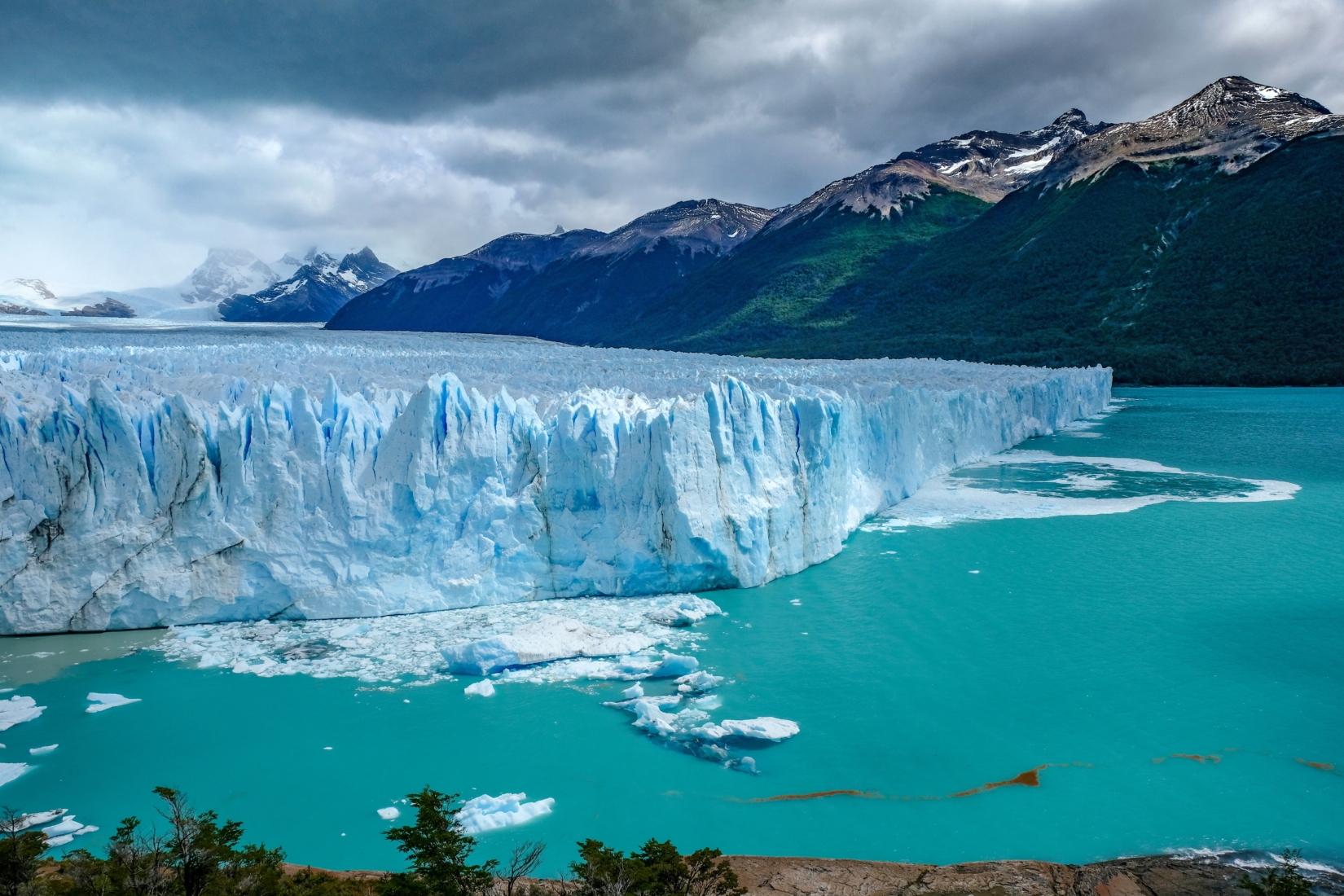
Argentine Patagonia is a land of true extremes, of sights and sweeping vistas that you need to see to believe. Here, the mountain tops of the Fitz Roy skewer the clouds. There, the rolling pampas are dotted with sheep farms. Suddenly, killer whales splash through the oceans. Then, a colossal ice sheet fragments from the Andean glaciers on high. If we could design a region for adventure travelers, it really would look something like Argentinian Patagonia!
This ultimate guide to Argentine Patagonia offers a look at this amazing corner of South America. It ranges from an introduction of the lake district of Bariloche and the penguin-spotted channels of Tierra del Fuego to advice on the best activities and must-see attractions in Patagonia and what to pack for your trip. We’ll also cover details about the best times to visit, what the weather is like, and the practicalities of getting there. Let’s jump into it!
Inside this Guide
My experience in argentine patagonia, where is argentinian patagonia, how to get there, when is the best time to visit, what to pack for argentine patagonia, top travel destinations while visiting argentinian patagonia, must-see attractions in argentinian patagonia, top hikes in argentinian patagonia.
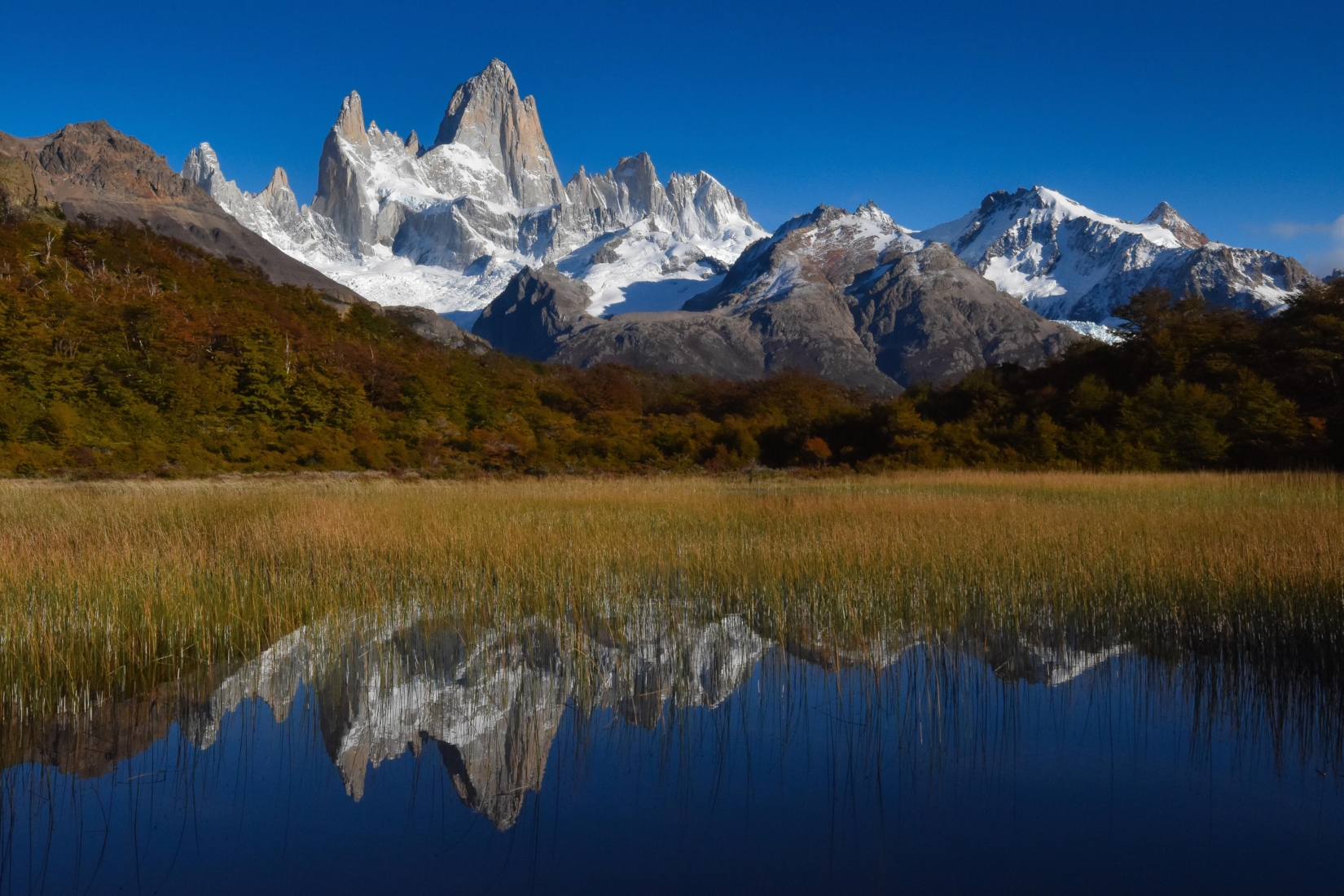
Just a mention of the name Patagonia is always enough to get the hairs standing on the back of my neck. And if you ask me about the Argentinian part of that great wilderness, I begin to recall images of the jagged Fitz Roy , the ice-shaking Perito Moreno Glacier, the dramatic landscape of Tierra del Fuego, and the inky lakes of Bariloche.
I’ve now trekked and traversed these lands and wonders extensively. But the former sense of majesty and mystique that visiting Argentinian Patagonia inspired has never fully left me. Whenever I pack the crampons and lace the boots for a trip to this frontier of South America, I fizz with a mix of excitement, joy, and apprehension, all fueled by the prospect of returning to what I now know to be unquestionably one of the most savage, yet sublime, parts of the planet.
The magic of destinations like Patagonia helped me to make a career out of travel. I’m so fortunate to have founded The Explorer’s Passage , the world’s premier adventure travel company. We pride ourselves in assisting travelers to experience the most unique corners of the planet through meticulously executed trips. Join us for a jaunt to Argentina and rest assured we’ll take care of all the details so you can enjoy your trip in the most intimate, exhilarating ways possible.
Argentinian Patagonia is a seriously vast region. It encompasses more than a quarter of the latitudes of South America as a whole, running just shy of 1,000 miles (1,609 km) from the winding Rio Negro (generally accepted to be its northern border) to the fragmented isles of Tierra del Fuego on the cusp of Cape Horn.
The greater region of Patagonia is shared between Argentina and Chile. The land area of both is similar from north to south but the Chilean side is nowhere near as wide. It encompasses a long run of the snow-capped Andes and a sliver of coastal plains before bending into the Magellan Strait. The Argentine side, meanwhile, hits nearly 500 miles (805 km) at its widest point, rolling from alpine lakes and glaciers to barren pampas and steppes. If you’re also interested in exploring the Chilean side of Patagonia, check out our W Trek Adventure !
The extreme far Southern Patagonia is a fragment of the Isla Grande de Tierra del Fuego. That, in turn, is entirely separated from the Argentina mainland, sharing a sole land border with Chilean Patagonia to the west. There are also a number of offshore territories that belong to the region, including the seal-spotted Isla de los Estados, which is considered to be the very end of the Andes mountain chain within southern Patagonia

As you might imagine, getting to Argentine Patagonia, this far-flung corner of South America, isn’t as simple as jetting into Buenos Aires for a night in the tango halls. But it’s also not super difficult. The reason? Flights. While the majority of international links into Argentina still head straight to the capital’s Ministro Pistarini International Airport (also known as Ezeiza International Airport), there are plenty of domestic connections that help you make the hop – and it’s still a hefty hop, mind you – into Patagonia.
The most popular air route services to get to Argentinian Patagonia from Buenos Aires are the ones that go direct to El Calafate (taking just over 3 hours) and to the stunning mountain resort of Bariloche (taking 2.5 hours). You can also go straight to Ushuaia, the most southerly city in the world, in as little as 3.5 hours.
Prefer traveling via land? Don’t worry – the old-school way of getting to southern Patagonia is still very much alive. Buses link to Bariloche from Buenos Aires in around a full day’s travel, though the ride is a real adventure going straight across the heart of the country, providing nice views while getting to Argentine Patagonia.
There are others that make the long road trip down the iconic Ruta 40 (one of South America’s most breathtaking highways) from Bariloche to the trekking hub of El Chaltén, usually taking upwards of 25 hours in all, providing amazing views and scenery as you travel to Patagonia.
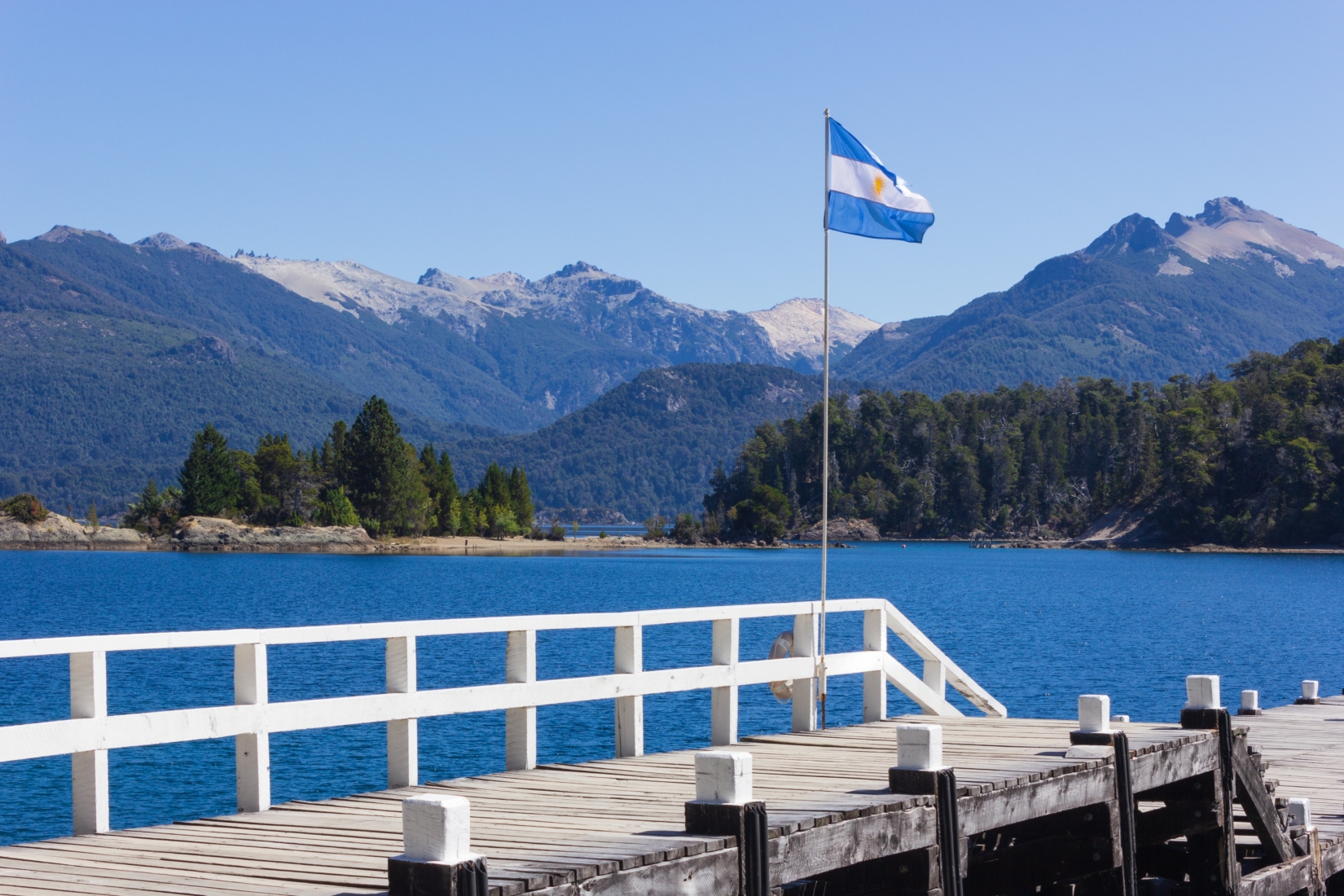
It’s hard to predict what the weather will be like in regions like Patagonia that sit at the very ends of the Earth. However, there is a clear four-season pattern that can offer some insights into the sort of conditions you can expect during certain months to give you a good idea of what to pack according to the time of your trip to Argentine Patagonia. Let’s take a closer look…
- Winter (June to August) – Winter can be harsh in this extremity of the continent. Down in Ushuaia, it’s possible to see thermometers ebb to around 20°F (-7°C), but most days it’s between 30 to 50°F (-1 to 10°C). It will get warmer as you head north, but the Andes create huge snow systems that can cover the major hiking hubs of El Calafate and El Chaltén.
Trails don’t completely close per se, but it’s virtually impossible to complete the longer routes while touring Argentinian Patagonia at this time of year. At best, you’ll be looking at short day hikes and will need to be wary of changeable conditions. The real upshot of traveling here in the winter is the excellent skiing. Bariloche is the center of that, with a season that typically runs from April to October.
- Spring (September to November) – Spring is a time of serious transition that can mean hefty temperature fluctuations in the Andes. Those hitting the walking hubs around Fitz Roy might get wildflower displays and milder winds than in the summer, but layering is key while visiting Argentinian Patagonia during this time of the year as below-freezing nights follow positively balmy, sun-drenched days in the 60°F (15 to 20°C) range.
However, rainfall does ease off, getting to a yearly low of just over 1.5 inches (40 mm) in El Chaltén in November, making this the start of a few good months to consider visiting. What’s more, spring is prime time for whale watching on the rugged Argentinian Atlantic coast or enjoying beautiful scenery in the Argentine lake district.
- Summer (December to February) – Often seen as the runaway best time to come trekking in Patagonia, the summer is about clear, dry days and cool nights. Temperatures in the main hiking areas tend to hover around the 60s and low 70s (15 to 22°C), but stay closer to 55°F (13°C) in Ushuaia. December sees the annual peak for sunshine hours, providing exceptional weather for touring and exploring all of the must-see attractions that Argentine Patagonia has to offer.
Rainfall tends to be lower towards the start of the season, sticking to 2 inches (50 mm) in December. All that means is the trails of El Chaltén are in fine condition and the glacier face at Perito Moreno is most likely to showcase its incredible calving process. The downside? The prices are higher and there are always crowds around, not to mention the winds from the west can be very strong. For these reasons, not everyone agrees that these popular months are the best time to visit.
- Fall (March to May) – The fall months are the wettest across the whole region which must be considered when planning your trip and what to pack for Argentine Patagonia. Take El Chaltén for example, precipitation levels there can be almost double in April than they are in September. The weather in Patagonia naturally has an adverse effect on the quality of the trails and the views – rains mean clouds and clouds can mean bad photos.
But all is not lost. It doesn’t rain all the time during the autumn and when it clears, you’ll be able to see the ochre, orange, and red changing of the forests in the subalpine zones. Plus, there tend to be way fewer trekkers around at this time, helping to cut prices and up that feeling of total seclusion during your visit to Argentine Patagonia.

As previously mentioned, the weather in Argentine Patagonia can be very unpredictable with temperatures ranging from 20 to 70°F (-7 to 22°C) depending on the time of year you decide to visit. Plus, rain and snow are also fairly common in this region, so it is important to bring along waterproof outerwear and trekking boots to keep dry while touring or trekking in these parts. Your best bet for packing for Argentine Patagonia is to layer up and be prepared to shed a few layers as the day gets warmer and your body heats up while trekking.
Aside from considering the ranging temperatures and weather in Argentine Patagonia, it is also important to take into account the sunny days while packing for your trip. A good pair of polarized sunglasses and plenty of sunscreen will be your best friend to protect against blinding sun rays reflecting off of ice, snow, and water in this region. This will be especially helpful when you spend hours in direct sunlight while trekking.
Below you’ll find a basic list of the essential items we recommend you bring while visiting Patagonia.
- Trekking boots (waterproof)
- Long thermal underwear, shirts, and pants
- Light fleece jacket
- Protective outer-layer jacket (waterproof)
- Sunscreen and insect repellent
- Quick dry towel
- Trekking backpack
Additionally, we’ve got a more general guide for what to pack in your daypack while trekking if you just don’t know where to start!
Patagonia isn’t just one destination. It’s hundreds. They’re all wedged into this 400,000-square mile (1,036,000-sq km) block of South America, ranging from the spiked Andean peaks to wave-lashed shorelines. Some of the most enticing places of the lot are located on Argentina’s side of the border, too.
Here are some of our top picks for cities and towns to visit:
- El Chaltén – They call El Chaltén the “National Capital of Trekking in Argentina.” The town, a ramshackle and surprising mix of backpacker hostels and sleek mountain spas, sits at the foot of the great Fitz Roy massif, attracting many travelers seeking to knock “trekking in Patagonia” off their bucket list.
Look west and you’ll see the toothed tops of what some consider to be the most incredible part of the Andes, rising 11,170 feet (3,405 m) above sea level. There are trails galore, from the 11.8-mile (19-km) romp to the Laguna Torre to the soaring panoramic Pliegue Tumbado walk, allowing for anyone to find a hike in Argentinian Patagonia that suits their abilities. Back in the El Chaltén town center, there’s a real frontier vibe, with swinging-door saloons and timber taverns selling hearty Argentine steaks and stews .
- El Calafate – The gateway city to the eye-watering Parque Nacional Los Glaciares is tucked into what’s surely one of the most incredible clefts in the Andes of western Argentina. Most people come to this part of southern Patagonia to catch a glimpse of one thing: Perito Moreno Glacier, one of the must-see attractions in Argentine Patagonia that we’ll cover more about later. That hulking tongue of moving ice can be seen calving bergs into the glistening glacier lake that forms right in front of it. There are other draws besides the Perito Moreno Glacier, too – 4X4 excursions, trekking in Los Glaciares, helicopter flyovers, and stargazing are all on the menu.
- Bariloche – Full name: San Carlos de Bariloche. Reputation: “Patagonia’s most charming town,” at least according to Travel + Leisure and oodles of folks who’ve gone. Set along the shores of inky Nahuel Huapi Lake within the Argentine lake district, this elegant escape in the Andes can often feel more like Switzerland than South America. Bariloche is topped by churches that would look right at home in Geneva and has a framing of snow-capped mountains. There’s skiing to be done in the winter on the slopes of Catedral Alta, as well as hiking up Cerro Llao Llao and Cerro Campanario depending on the weather in Patagonia during your visit. And the wonderful Argentinian Lake District unfolds on its doorstep.
- Ushuaia – Plonked on the 54th parallel, Ushuaia is the world’s southernmost city located at the tip of Argentine Patagonia. It spreads out before the sloshing waters of the Beagle Channel beneath the Martial Glacier, the terminus of both the Pan-American Highway and Argentina National Route 3. To put it another way: This is very much the end of the road, unless, of course, you’re headed to Antarctica via a sea voyage, which mainly departs from here. In this case, check out our Antarctica Cruise Guide for all the information you’ll need to reach the base of the globe.
Adventurers visiting Ushuaia in Argentine Patagonia have plenty to do, from seafaring in the Tierra del Fuego and meeting penguin colonies to climbing windblown peaks above the shipwreck-dotted San Pablo Cape.
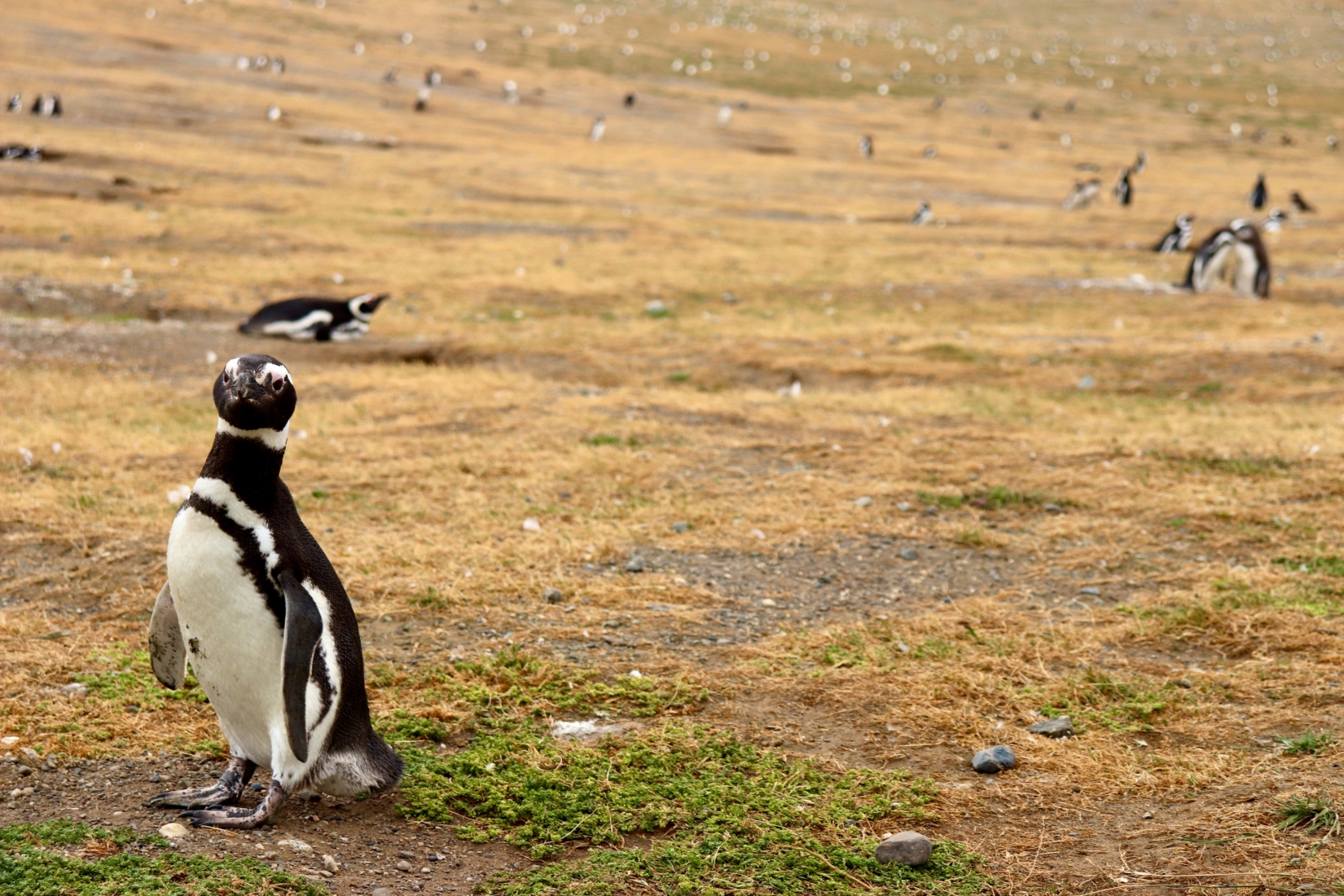
- Puerto Madryn – One part industrial and one part wild, Puerto Madryn is the entry point to the legendary Península Valdés . That’s the area you’ll want to focus on while touring Argentine Patagonia, particularly in the months between June and January, when the southern right whales pass through en masse, attracting many tourists to travel to Patagonia. Even without the cetaceans, it’s a pretty epic region dotted with pink-tinged salt pans and beset by primeval steppe.
Make sure to stop in these villages and cities for a multifaceted trip that is sure to excite.
It’s easy to see why Argentinian Patagonia can be a favorite on an outdoorsy, adventure seeker’s list of top destinations. The sights and activities are largely majestic jagged peaks and scenic hikes on the trails that weave around them. Plus, the penguin and whale spotting is not to be missed.
Plan to see these popular attractions when you go:
- Fitz Roy – Cerro Fitz Roy spikes the skies to the west of El Chaltén town, heralding arguably the most iconic mountain massif in South America, drawing in lots of tourists to Argentine Patagonia. It’s almost impossible to believe it’s real, what with pinnacle after pinnacle of granite monolith lurching straight from the edge of a gleaming glacier. Conquering the top on your Patagonia trek is a serious mountaineering undertaking. Most trekkers stick to viewpoints around the Laguna de los Tres just below (more on that later).
- Perito Moreno Glacier – Set at an opening in the Andes some 50 miles (80.5 km) to the west of El Calafate in southern Patagonia, the Perito Moreno Glacier has been wowing travelers for decades. Covering nearly 100 square miles (259 sq km) of a wide valley in the Los Glaciares National Park, it’s arguably the best place in the world to see the process of calving (when glaciers fragment into icebergs where they meet the water).
You can also hike right on top of the Perito Moreno Glacier. Choose between mini trekking options to sample crampon trekking, or go for the Big Ice adventure – a challenging hike lasting 12 hours that takes you across much more of the glacier surface. Hiking the Perito Moreno Glacier is sure to be an awe-inspiring experience for any travelers visiting Argentine Patagonia.
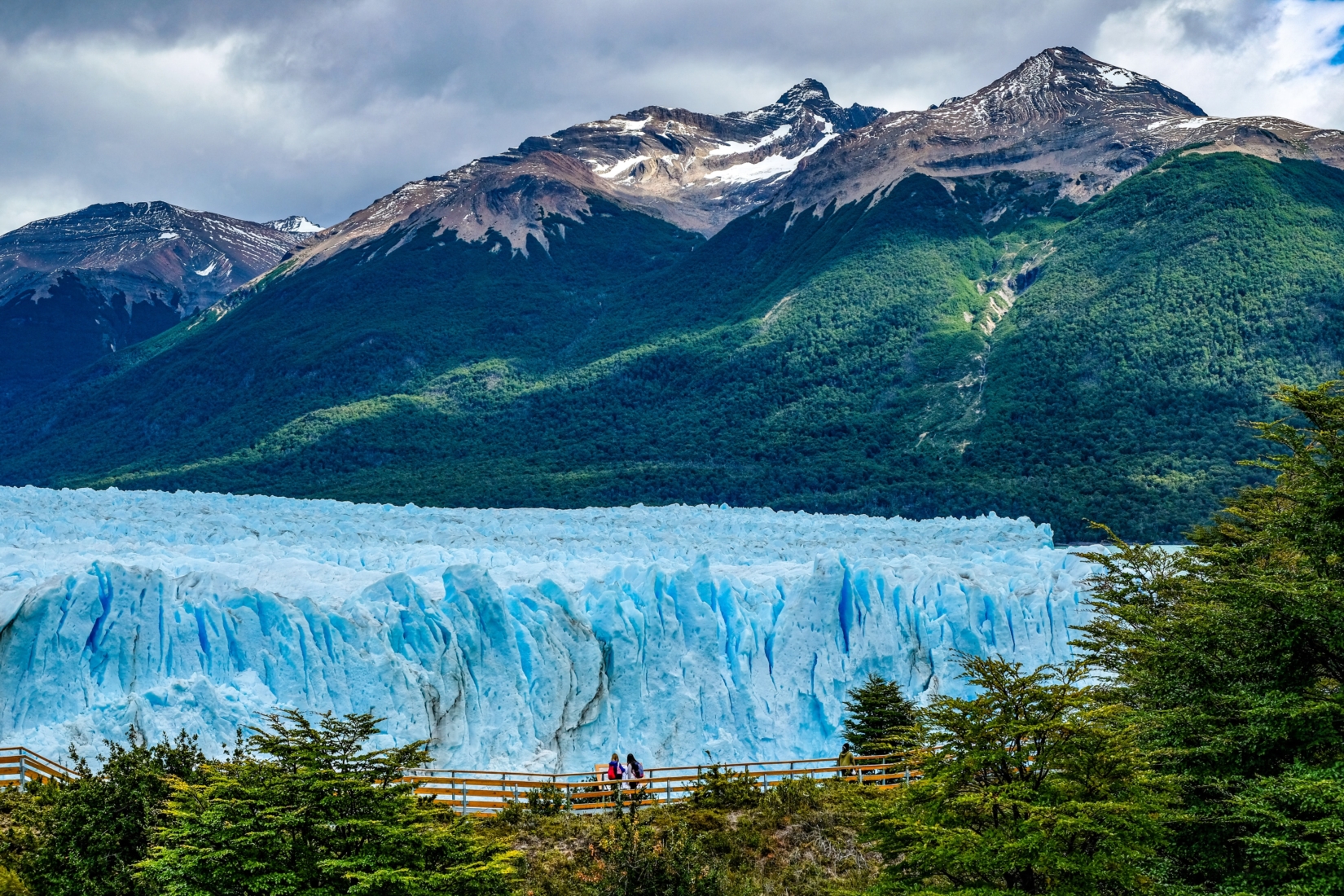
- Tierra del Fuego – Tierra del Fuego is where the end of South America fragments into the Atlantic Ocean at the tip of Patagonia. Like so many parts of this region, it’s shared between Chile and Argentina, but it’s the latter that has the main base: Ushuaia, the southernmost city in the world, that we covered above. Tierra del Fuego visitors will often start the day with a hike to the scenic Glacier Martial and then venture out by water to spot Gentoo penguins and sea lions on the Beagle Channel and beyond.
- Whale watching – Argentinian Patagonia actually has some of the finest whale watching on the continent. That’s despite the fact that there’s really only one destination that has the infrastructure and natural gifts for it. You’re looking for the duo of Puerto Madryn and the whole Península Valdés. The main species to spot are southern right whales and orcas, along with all manner of dolphins and penguins. The best time to visit Patagonia for whale watching is between June and December.
- Trekking – Last but most certainly not least, the trekking. Argentinian Patagonia can rival even the mighty Himalaya on this front. There are treks of all shapes and sizes, levels, and styles fit for anyone. We’ll take a look at the most famous Patagonia treks in just a moment but suffice to say that there are routes that let you get up close and personal with jagged mountains like the Fitz Roy and others that let you tread on colossal glaciers such as the famous Perito Moreno Glacier.
Spring and summer are generally considered the best time to travel to Patagonia if you wish to hit the trails, as many of the routes close completely due to snowfall during the other seasons.
If you’re interested in hiking Torres del Paine on the Chilean side of Patagonia, check out our 19 Things to Know Before Hiking the W Trek .
A 1,000-mile (1,069-km) string of the Andes bisects the whole of Patagonia, delineating much of the border between Chile and Argentina. But Argentina gets the eastern section of the mountains, which is generally considered to be the premier trekking part. It’s where you can tread on epic trails, such as:
- Laguna de los Tres – The Laguna de los Tres is the piece de resistance of El Chaltén, the trekking capital of the country. It begins in the town itself, then passes through woods of fire trees and barberry bushes, then emerges onto exposed slopes with a steep ascent onto a glacier-carved moraine. That’s where the glimmering waters of the Laguna de los Tres unfold, right beneath the hulking granite spires of the Fitz Roy. There’s really no better viewpoint around. Sunrise hikes in Patagonia are extra special since you see the peaks glow radiant pinks and reds in the first rays of the day.
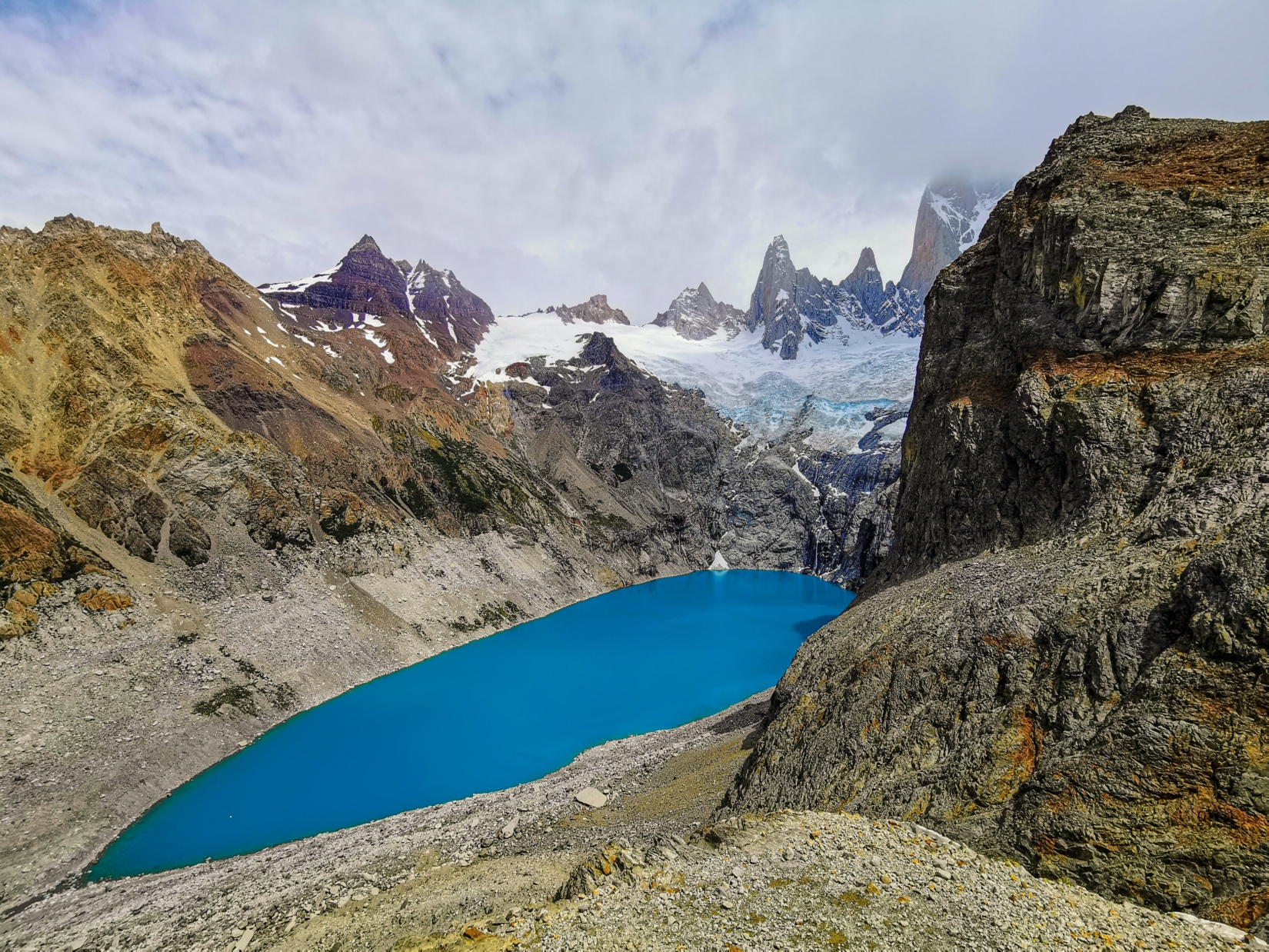
- Laguna Torre – A 9-hour hike through the valley behind the Fitz Roy massif can bring you into the domain of the Laguna Torre. It’s a needle-like stack of stone that’s considered one of the hardest climbing feats in the world. You won’t be harnessing up to do that, but the journey there offers sublime views of the Grande Glacier and an inky mountain lake framed by the summit itself. A good option is to stay in the backcountry campground – that will let you complete the hike at sunrise, when the Laguna Torre peak looks, simply, stunning.
- Big Ice – Helping you scratch a line from the bucket list, the Big Ice tour is a trek actually on top of the Perito Moreno Glacier. There are shorter options known as mini treks, but this is the true expedition for exploring the nooks and crannies of the creaking ice field as it cascades down from the heights of Cerro Pietrobelli. Days start with a hike along a tough moraine before you cross to the glacier itself to see, firsthand, pristine ice caves and crevasses cut into the surface all throughout your hike in Patagonia.
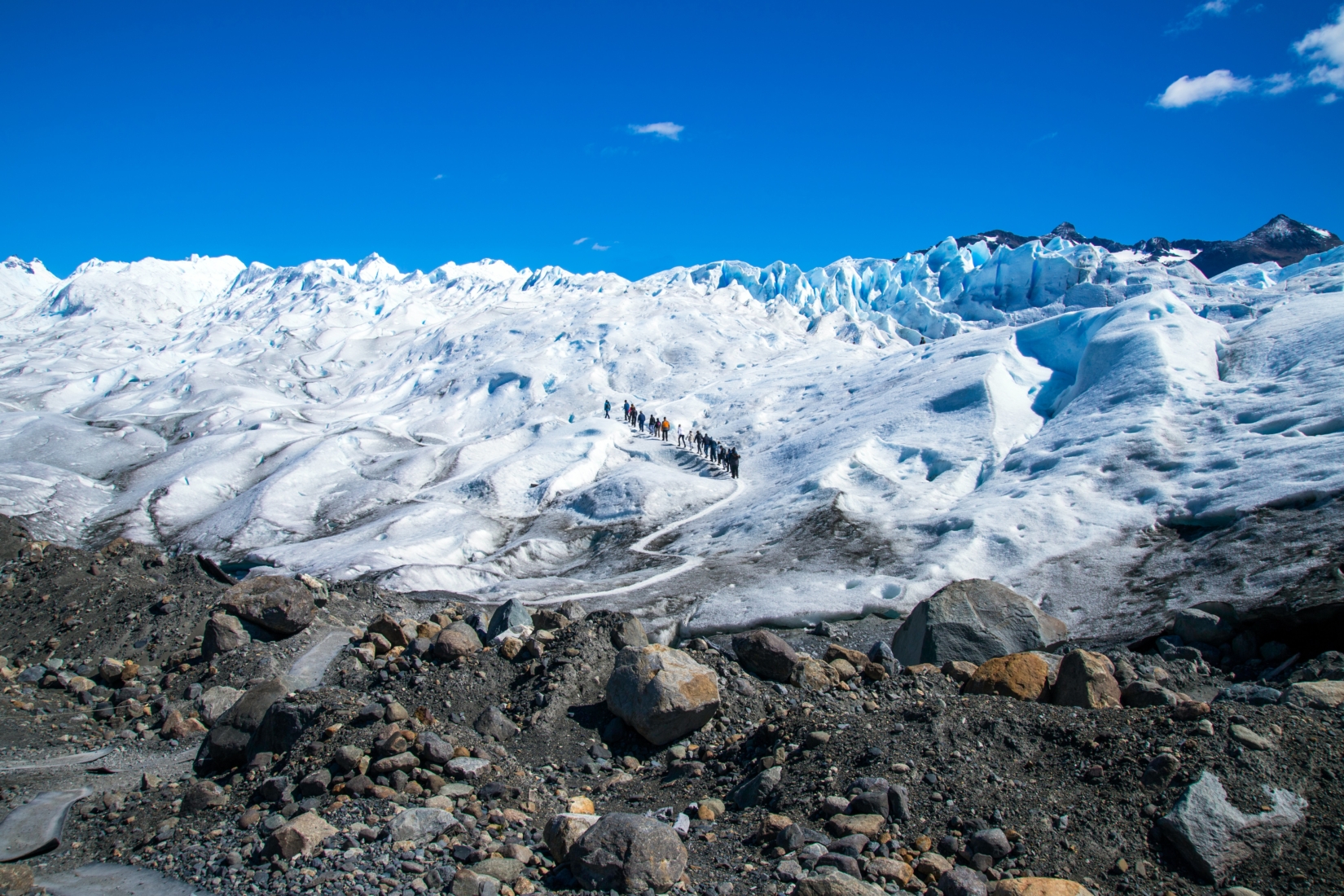
- Huemul Circuit – If you’re all about spying the vast white plains of the Southern Patagonian Ice Field, then there’s no better hike than the Huemul Circuit. It’s 4 days and 40 miles (64 km) of dramatic, high-altitude scenery in the depths of the Los Glaciares west of El Chaltén. This hike is a challenge, requiring river fording, use of a Tyrolean traverse, and 3,000-foot (91 m) ascents in a single day. Highlights along this hike in Patagonia include the Paso del Viento , a wind-blasted pass under Cerro Huemul, and sections along sky-blue Viedma Lake.
- Pliegue Tumbado – This Patagonia hike, taking you ever higher and higher from a starting point in a local visitors’ center to the Pliegue Tumbado plateau, is all about gaining a vantage point to survey El Chaltén’s unrivaled little crevice in the Andes. This hike is highly exposed and usually windy in the dominant summer westerlies. At 4,900 feet (1,494 m) up, you’ll gain a ridge that takes in the Fitz Roy to the north and glacier-draped Mount Huemul to the west.
This trip guide is just a taste of what you’ll experience on a remarkable visit to Argentine Patagonia. If you have more questions on visiting Argentinian Patagonia or need help planning your trip, let’s connect! Our knowledgeable Adventure Consultants would love to hear from you so contact us and let us show you what’s possible .
Why travel with The Explorer’s Passage?
We pride ourselves on delivering extraordinary tours based on travelers’ needs and are humbled by our guests’ testimonials . In fact, our dedication has earned us a 5-star rating on Tripadvisor , and awards by Travel+Leisure Magazine and Newsweek. Check us out and discover why so many travelers worldwide choose us . My team and I would love for you to join us in Argentine Patagonia or or any of our many other adventure trips !
Cheers, Jeff
Jeff Bonaldi Founder & CEO The Explorer’s Passage
About Jeff Bonaldi
Jeff Bonaldi is the Founder and CEO of The Explorer’s Passage, a premier adventure travel company. His mission is to provide travelers with the opportunity to transform their lives and the planet through the power of adventure.
Learn more about Jeff’s story and his company HERE .
Share This Amazing Location!
Related posts.
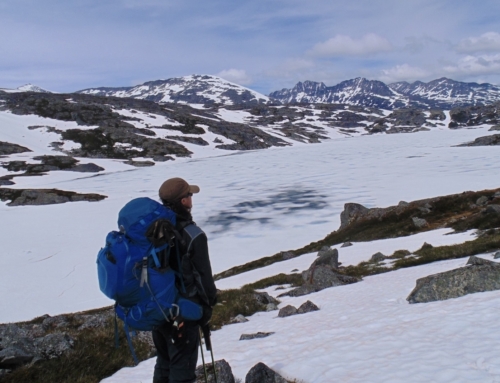
A Traveler’s Must-Read Guide to the Chilkoot Trail Hike
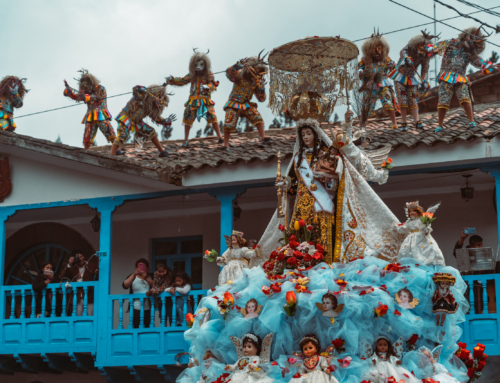
All You Need to Know About the Virgen del Carmen Festival in Peru
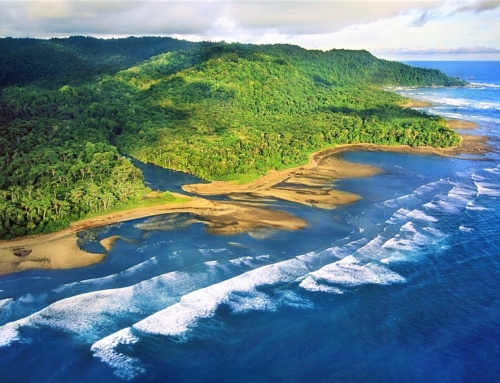
Top Attractions on the Osa Peninsula in Costa Rica

Ultimate Guanacaste Travel Guide – Explore Costa Rica’s Coastal Paradise
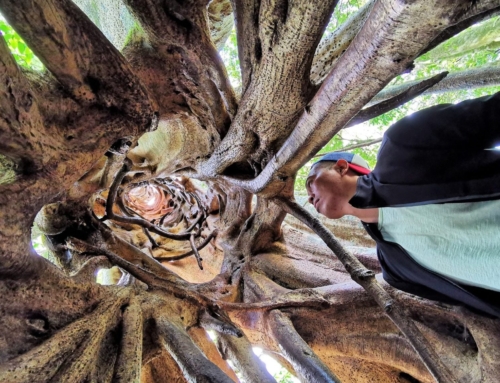
Top Things to Know Before Visiting Monteverde, Costa Rica

A Traveler’s Handbook to Manuel Antonio in Costa Rica – Everything to Know for Your Trip
- International edition
- Australia edition
- Europe edition
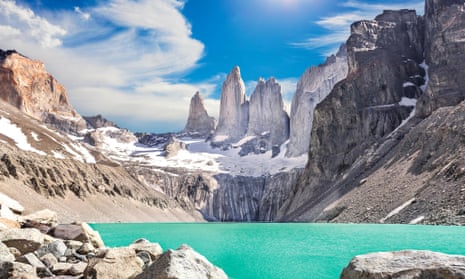
Guide to Patagonia: what to do, how to do it, and where to stay
Forty years ago this month, Bruce Chatwin visited Patagonia and his subsequent book lit a beacon for the remote region in many travellers’ minds. Chris Moss picks the highlights among its peaks, glaciers and lakes
F or my first forays into Patagonia, in the 1990s, I left behind my guidebooks and travelogues. Travelling light, I was blown away by big, jagged mountaintop glaciers and – more literally – the fierce westerlies that gusted summer long. Between the gawping and the roast lamb dinners, I struggled to make sense of German settlements, Tehuelche place names, Anglophile ranch-owners and ruddy Welsh faces on the coast; crossing the empty steppe, I wondered why any of these would come to such an arid, godforsaken place to make a home.
Later on, Bruce Chatwin’s In Patagonia helped me to make sense of all this. Chatwin visited the region 40 years ago this month to write what would become In Patagonia, published in 1977 to great acclaim. Drawing on a wide range of sources, from Shakespeare’s The Tempest to the accounts of the 1921-2 farm workers’ uprising (collected by Argentine author Osvaldo Bayer), the book fills the empty spaces of southern South America with people, myths and magical happenings. In Patagonia is as much a homage to storytelling as it is to the place itself.
Patagonia covers some 400,000 square miles – roughly one and a half times the size of the UK – and visitors need to plan ahead. Established tourism is found in the northern lake districts of Argentina and Chile, and around Los Glaciares national park in the former, and Torres del Paine national park in the latter. Elsewhere, the wilderness still rules, and a cursory glance at a map reveals that Argentinian Patagonia is mainly empty spaces and ranching country, while Chilean Patagonia is a collage of islands, inlets and labyrinthine channels.
Chatwin stayed for four months, but you probably won’t have that much time – below are some experiences you can fit into a 10-day or two-week trip, and a few odysseys aimed at the time-rich traveller. Tour packages from the UK are included, but it’s easy to visit Patagonia independently – there are hostels all over, excellent campsites, frequent buses and mini-buses, and English is widely spoken. Pound sterling is very strong against the Argentine peso, so short local flights are affordable right now. Across the region, food and drink are excellent value too. A few decades ago, Patagonian cuisine consisted of grilled lamb and tripe stew; these days restaurants serve everything from cured wild boar to snook-and-hake ceviche, while local parrillas (grills) are always a safe bet for a meaty feast.
Argentinian Patagonia: coast

Argentinian Patagonia is generally defined as the land south of the Rio Negro, which meets the sea near the town of Viedma. Exploring Patagonia’s Atlantic coast is relatively easy: the Ruta Nacional 3 highway runs all the way from Buenos Aires to Rio Gallegos, where you take a ferry across the Strait of Magellan to Tierra del Fuego, to complete the 3,000km run. Andesmar , Condor , Don Otto and El Pinguino operate comfortable, economical long-distance buses to the main towns (Buenos Aires to Puerto Madryn costs from £70). Hiring a car allows greater freedom, but you’d have to bring it back to the pick-up point – a 14-day hire of a small vehicle from Buenos Aires starts at £350 with Europcar or Budget.
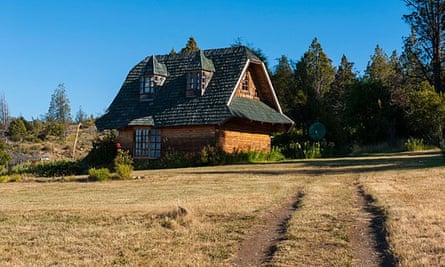
On the northern coast, the two big stories are Wales and whales. In 1865, 165 migrants arrived from Wales aboard the Mimosa and established settlements beside the River Chubut. The towns that grew out of these hamlets – Rawson, Puerto Madryn, Trelew and Gaiman – are easy to visit by bus or car, with chapels and Welsh-themed teashops concentrated in the latter. If you want to do as the Welsh – and Chatwin – did, and travel all the way to the Andes, it’s a long bus ride or drive across the steppe. A side-theme here is dinosaurs; lots of fossils have been found in Patagonia and Trelew has an excellent collection at its Egidio Feruglio Museum of Paleontology .
The South Atlantic teems with marine life. Southern right whales can be seen calving in the southern winter (July-September) off Puerto Madryn, though the best place to see them is Puerto Pirámides on the Valdés peninsula, from which smallish boats allow visitors to get close to the huge cetaceans. Pods of orcas, as well as elephant seals, sea lions and fur seals are visible off the peninsula’s coast year round. South of Madryn, at Punta Tombo, there are 210,000 breeding pairs of Magellanic penguins – the largest colony in the world – resident from September to March. Further south, at Puerto Deseado, you can see rockhopper penguins, five species of cormorant and Commerson’s dolphins in the estuary, and a huge seal colony at Cabo Blanco.
The most southerly important landmark on the coast is Puerto San Julián. It is here that Portuguese explorer Ferdinand Magellan made landfall in 1520, encountering the tall Tehuelche tribesmen whom he called Patagones, after a mythical character in a chivalric tale, leading to the region’s name. There is a fine 12km coastal walk here from the town centre to the abandoned Swift meatpacking plant.
There’s little reason to go further south than this unless you’re driving and bound for Cabo Virgenes, at the southeastern-most tip of mainland Argentina. This dramatic cape looks out over the Atlantic and the Strait of Magellan – the Estancia Monte Dinero is open to visitors and runs the cosy Al Fin y Al Cabo cafe-bar at the foot of the lighthouse, with sweeping views over the ocean. There’s another huge Magellanic penguin colony nearby.

Where to stay
El Gualicho hostel, Puerto Madryn Three blocks from the sea, this popular, brightly decorated hostel (orange paint is the main theme) can help guests organise diving trips and other excursions. £54 per double or twin, B&B, +54 02 80 445 4163, elgualicho.com.ar
Monte Dinero One of only a few working sheep farms open to visitors; accommodation is lavish and the food some of the best in Patagonia. £260 per double, full board, +54 29 6642 8922, montedinero.com.ar
Territorio, Puerto Madryn A stylish sort of haute motel right on the bay, equipped with library, spa, sauna and a good restaurant. D oubles from £135; + 54 28 0488 3180, hotelterritorio.com
Argentinian Patagonia: Andes

The most populated and developed area of Andean Patagonia is the lake district of Río Negro and Neuquén provinces. The latter is more popular with Argentinians than foreign visitors, but the quaint towns of Junín de los Andes, San Martín de los Andes and Villa La Angostura are good bases for camping, hiking, trout fishing, horse riding and quad biking. A photogenic drive (or tour-bus ride) here is the Seven Lakes route, which winds for 110km between a series of lakes surrounded by Andean peaks and beech and myrtle forests enlivened by red anemone-like notros and yellow michay flowers .
Bariloche, on the banks of the immense Nahuel Huapi lake, is a major town, and a base for trekking and mountain biking; Apurabici rents bikes for £15 a day and organises half-day guided rides along mountain trails for £50pp.
A popular excursion from here is a through-Andes ferry-and-bus ride to Puerto Varas in Chile, allowing you to see the further reaches of the lakes that are inaccessible by road. Operated by Cruce Andino (cruceandino.com), a single costs £146.
Bariloche is a natural starting point for a drive south along Argentina’s Ruta Nacional 40. This long, largely paved highway actually runs the length of the country, skirting the Andes, and the Patagonian section runs past all the towns listed below.
From Bariloche to Cabo Virgenes it’s 2,300km; Audley Travel can arrange a 14-day car and accommodation package for £4,295 per person, including all flights and a 4WD vehicle.
To do it yourself, use bus firms that operate along the entire route, such as Chaltén Travel and TAQSA (one-way Bariloche to El Calafate from £106). A small operator, Cal Tur , connects Los Antiguos with El Calafate.

South of Bariloche are a string of pleasant towns, including El Bolsón – a former hippy hangout, and still popular with Argentinian campers – and Cholila, where Butch Cassidy and the Sundance Kid bought a ranch (you can visit Cassidy’s log cabin there). Close by, Los Alerces national park has some of the nicest campsites in Patagonia, especially those on the edges of Bahía Rosales and on the Kruger and Rivadavia lakes. There are seven serviced campsites and nine basic ones, and a further seven areas that allow wild camping. It’s $80 (£6) to enter the park and camping costs £8-10 per night. There’s good trekking throughout the park, and also at nearby Lago Puelo, and its namesake national park.
From Esquel, the steam-powered La Trochita train – aka the Old Patagonian Express – still has weekly departures, but most only go 20km, to Nahuel Pan. Close to the town is the Museo Leleque . Supported by the Benetton family, it showcases 14,000 native artefacts, including arrowheads, bone drills, ceremonial axes, grinding stones and pottery shards.
South of Esquel is Trevelin, where you enter, briefly, another Welsh-themed area, after which comes a lot of nada – the great empty spaces of central Patagonia. The Ruta Nacional 40 passes through backwater towns like Tecka, José de San Martín and Alto Río Senguer, and the main population centres – Río Mayo (“the national capital of shearing”), Los Antiguos (which sits on the shores of the immense Lago Buenos Aires), and Bajo Caracoles. There’s not a lot to see on the roadside except sheep, though you may catch sight of a fox, a guanaco (a camelid), or a choique (aka Darwin’s rhea – like an emu), or the whiff of a skunk.
One major highlight en route is the Unesco-listed Cueva de las Manos (Cave of Hands). On a gravel road off the Ruta Nacional 40, around 165km south of the town of Perito Moreno, are overhanging caves where, in 1972, archaeologists found 9,000-year-old stencilled handprints and galloping guanacos painted by ancient peoples – probably the ancestors of the native Tehuelche nomads. The art is thought-provoking and the setting, overlooking a deep gorge, is superb (entrance: £6).
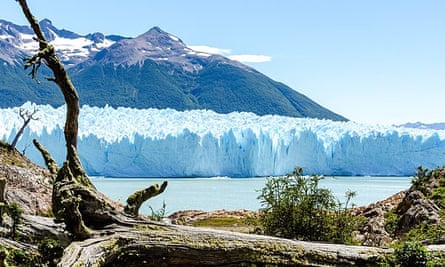
Continuing south, you arrive – eventually – in the extraordinarily beautiful Los Glaciares national park , a huge area that protects the southern ice field, dozens of glaciers, virgin forests of lenga, ñire and guindo trees. The star attractions are the towering Fitz Roy massif at its northern end, and the huge, turquoise-coloured Lago Argentino to the south. Many travellers come here to see the lake’s glacier, Perito Moreno ; it’s world-famous, because the ice expands until the warmer waters beneath undermine it and cause a calamitous implosion, sending tsunami-like waves on to the terminal moraine.
There’s plenty to do in the park, from ice-hiking to walking up to ogle 3,405m Mount Fitz Roy, to Land Rover excursions to the top of the barren summit of Cerro Huyliche (with calafateextremo.com.ar ). Alternatively, you can relax in the backpacker town of El Chaltén , admiring the views, the condors and the craft beers – La Vineria has a great stock of ales and Patagonian wines. Frequent minibuses connect El Chaltén to the other main town, El Calafate.
America del Sur hostel, El Calafate Simple, clean rooms in a wooden villa, five minutes’ walk from the town centre. From £20 for a bed in a four-berth dorm, +54 29 0249 3525, americahostel.com.ar
Hostería Canela, Esquel This homely B&B is a tranquil bolthole just outside the town. from £105 per double, +54 29 45 453 890, canelaesquel.com
Estancia Don José, Rio Mayo On a working guanaco farm, this country house has comfortable rooms and there’s a quaint cottage set apart from the main house. £168 per double B&B,+54 29 71 5624 9155, turismoguenguel.com
Chilean Patagonia and Tierra del Fuego

No one can really agree where Chilean Patagonia begins. Much of the south of this long, skinny country is jagged coastline, uninhabited islands, roads that come to dead ends, and impenetrable forests and ice fields. The lake district looks like a mirror image of Argentina’s, though German settlers have left their mark on the churches and houses of Frutillar , Puerto Octay and Puerto Varas. These towns (and Pucón to the north) are close to a series of national parks that protect the lakes and forested slopes of the Villarrica and Puyehue volcanoes. Trekking, cycling, kayaking and rafting trips are easy to organise from any of the towns, and Pachamagua , in Puerto Varas, is a canyoning specialist.
Horse riding is available all over Patagonia, but for those seeking an adventure, the Puelo valley between Cochamó in Chile and Lago Puelo in Argentina has become something of a classic; specialists Ride World Wide and In the Saddle offer a variety of itineraries along the valley. The low pass through the Andes is also used by scores of trekkers each summer.
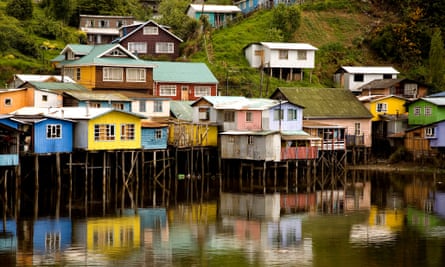
To the south is genuine wilderness, with the main road interrupted by river crossings. A drive down the 1,247km Carretera Austral (Southern Highway) from Puerto Montt to Villa O’Higgins is a great way to see the lushly forested Palena and Aysén regions, and Lago General Carrera, the second biggest lake in South America. Four-wheel-drive vehicles are recommended, and you’ll need at least 10 days; it’s wise to book some accommodation beforehand, especially in the holiday months of January and February.
For the southern section, the highway follows the Río Baker (until recently the river was threatened by a hydroelectricity scheme ) and passes the new Parque Patagonia . This protected swath of steppe and low mountain ranges is starkly beautiful, with the coirón grasses and spiny bushes providing a habitat for rhea, tinamou , pigeon and burrowing owl. In the mountains are eagles and vultures, including the condor, while the beech forests teem with treecreepers, woodpeckers and even hummingbirds.
Tailor-made firms such as Last Frontiers can organise flights, accommodation and a car for around £5,000 per person, but Europcar at Coyhaique’s Balmaceda airport will rent 4WD pick-ups for two weeks from around £1,100, and you could keep costs down by packing a tent or using hostels. For those on a tight budget, there’s a ferry from Puerto Montt to Chaitén; the service takes 10-12 hours and costs £17 ( navieraustral.cl ). Becker Buses operates on the northern section of the Southern Highway (Chaitén-Coyhaique, £25). See villaohiggins.com for connecting buses south.

The centrepiece of Chilean Patagonia is the Torres del Paine national park . The park’s 130km circuit is popular, though those tight for time can opt for shorter sections. There are great campsites, several superlative hotels, some challenging walks, and the chance to see guanaco and condor against quite stunning landscapes. Several firms are now offering puma-tracking trips in the park. Chilean firm Far South Expeditions offers packages from £1,650 – it’s cheaper with a larger group of travellers; UK luxury operator Miraviva will organise a five-night puma-themed safari, from £4,825 per person (excluding flights). From nearby Puerto Natales, Skorpios offers four-day excursions into the fjords around the southern ice field from £1,100 full-board.
Punta Arenas, an important port before the opening of the Panama Canal, has stately mansions, museums and an old cemetery – Chatwin visited his uncle’s grave here, as he brought his story to its conclusion. It’s also the departure port for the excellent Australis small-ship expedition cruises to Cape Horn and Ushuaia (four nights from £920), Argentina’s – and South America’s – southernmost city.

Singing Lamb, Puerto Natales Friendly, cosy, colourfully decorated hostel with free internet, library and an international clientele. The generous breakfast is a combination of eggs, freshly baked bread, homemade marmalade, and locally grown prunes, sarsaparilla and gooseberries. Doubles from £51 B&B (also has cheap dorms), +56 61 241 0958, thesinginglamb.com
Hotel Nogueira, Punta Arenas This small, rather grand 22-room hotel (former guests include King Juan Carlos of Spain and Princess Anne) was once the mansion of sailor José Nogueira, one of the founding fathers of Punta Arenas. Doubles from £80 B&B, +56 61 271 1000, hotelnogueira.com
Antumalal, Pucón Bauhaus-style hotel built in the 1940s on the edge of Villarrica lake, beneath the volcano. The interior is all fleece, posh fabrics and Mapuche crafts. Doubles from £160, +56 45 244 1011, antumalal.com
Patagonia: A Cultural History (Landscapes of the Imagination), by Chris Moss, is published by Signal Books
- Patagonia holidays
- Argentina holidays
- Chile holidays
- Adventure travel
- Whale watching holidays
- Horse riding holidays
- Camping holidays
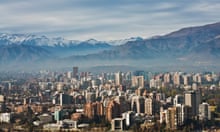
Santiago city guide: what to see, plus the best bars, restaurants and hotels
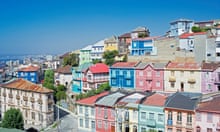
Poet's Pacific paradise: Pablo Neruda’s homes in Chile

Buenos Aires city guide: what to see, plus the best bars, restaurants and hotels

10 amazing landscapes in Chile – that you've probably never heard of
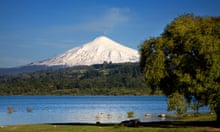
Highlights of Chile: readers’ travel tips

Patagonia adventure: a voyage round Cape Horn

Top 10 bars in Santiago, Chile
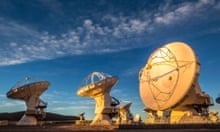
Stargazing in Chile: dark skies in the Atacama desert
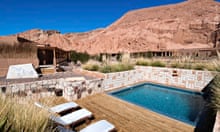
Chile’s desert delights: a culinary journey
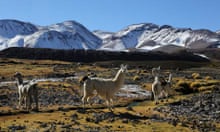
The high road: Argentina to Chile by bus
Comments (…), most viewed.
A Beginner's Guide to Argentinian Patagonia

A vast and remote region in South America that 402,000 square miles across Argentina and Chile, Patagonia is naturally divided by the Andes, though most of it — about 90% — is Argentinian.
Five provinces (Neuquén, Río Negro, Chubut, Santa Cruz and Tierra del Fuego) make up Argentinian Patagonia, one of the country's more popular destinations for wildlife such as the southern right whale and condor, and extreme outdoor pursuits such as skiing and glacier trekking.
Ready to plan your first trip to Argentinian Patagonia? Here's everything you need to know.
When to Go to Argentinian Patagonia
While hotel, activities and restaurant prices are elevated for local tourists, the Argentinian peso remains weak against the dollar at 43 to 1 following a 2018 devaluation , so it's still a great value. Summer (January to March) and winter (June to August) are peak seasons.
Given that the most southerly point of Argentinian Patagonia is 620 miles from Antarctica, expect the unexpected on the weather front. While the mercury in Tierra del Fuego rarely rises above 60 degrees — where you can also experience four seasons in just a few hours — the Lake District enjoys a sunny summer with average 68 degree days. But always be prepared with extra layers.
Getting Around Argentinian Patagonia
As Argentinian Patagonia is much larger than its Chilean counterpart, at least 12 days are recommended to get a feel for the area. Or, you can fly into one region and enjoy it with a two-night stay. Long-distance buses that are very comfortable and designed for trips of 24 hours or more are a great way to travel between these small southern cities. Otherwise, you can rent a car or fly. There is no rail network.
Accommodation suits all budgets, from well-equipped campsites to five-star hotels. Budget-conscious travelers should check out Cabo Raso in Chubut and Hotel Tirol in Bariloche. For a more luxurious experience, consider staying at Océano Patagonia in Valdés, Correntoso — a participating member of Small Luxury Hotels where you can earn and redeem World of Hyatt points in the Lakes District — or Arakur Ushuaia , a member of Leading Hotels of the World, which has its own loyalty program called the Leaders Club .
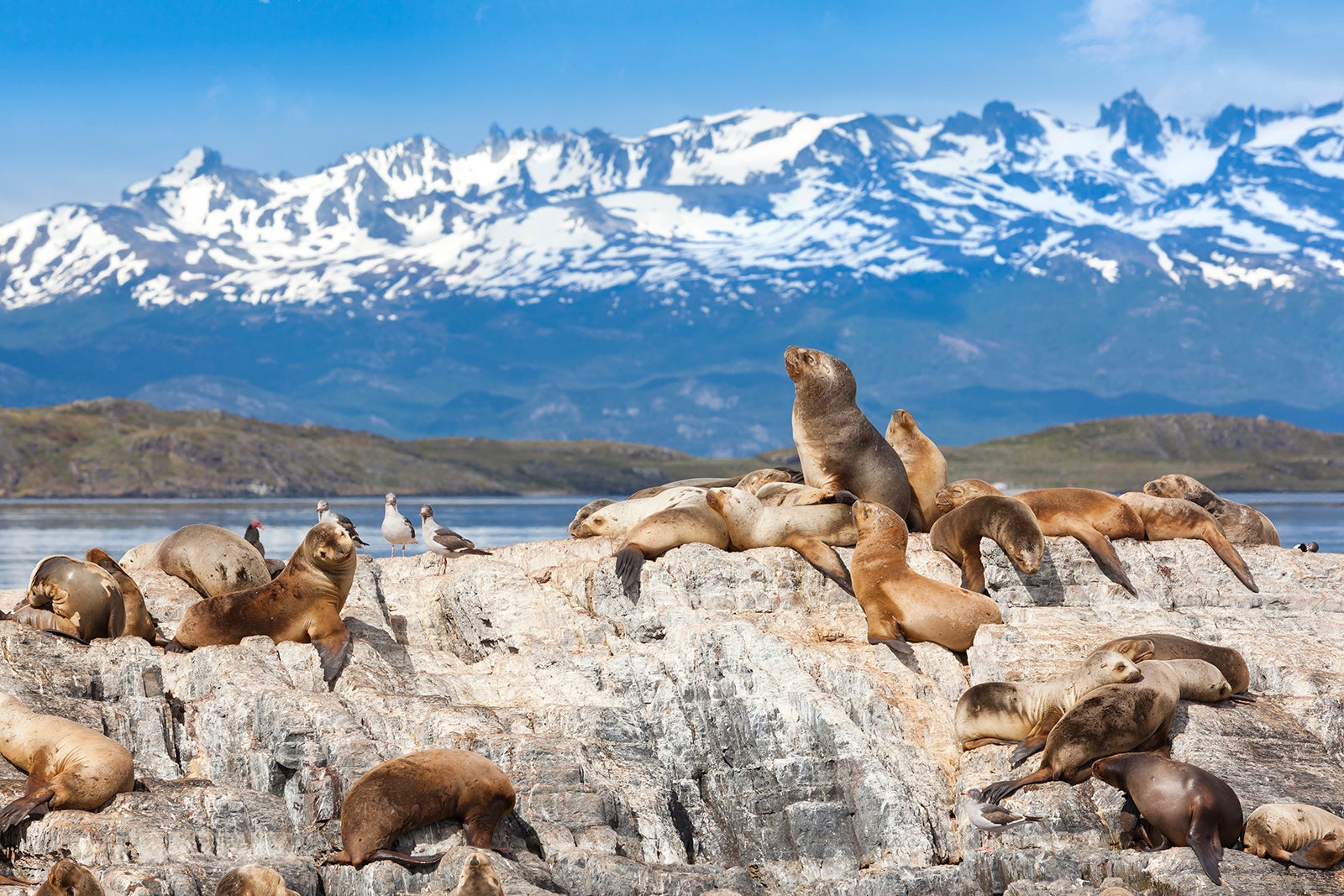
The Difference Between Argentinian and Chilean Patagonia
With a bout 90% — or 361,800 square miles — of Patagonia belonging to Argentina, the eastern side of the region offers a wide array of activities, such as mountaineering, kayaking, snow sports and fly fishing. Isolated small towns and ranches dot this enormous landmass between the Atlantic and Southern Oceans and the Andes; the reason outlaw Butch Cassidy pitched up in this remote region. From north to south, this is what to do in Argentinian Patagonia.
What to Do in the Lake District, Río Negro and Neuquén
Dramatic-looking Ruta de los Siete Lagos is picturesque with its crystalline waters and snow-capped peaks, so consider renting a car to appreciate the Seven Lakes Road. Fly into San Carlos de Bariloche to sample the craft beer route — part of the legendary 3,227-mile Ruta 40, which spans the length of Argentina — at pubs such as Microcervecería Patagonia, then work off the pints on a López Bay hike ; Cerro Catedral ski resort opens between June and September.
Drive north to Villa La Angostura's two lakes, Correntoso and Espejo, where fly fishermen go crazy for trout. Stay at the luxurious Correntoso for doorstep casting and dine at Tinto Bistro — owned by Martin Zorreguieta, brother of Queen Máxima of the Netherlands — in town. Finish the Siete Lagos circuit enjoying Lake Lacar near San Martín de los Andes , gateway to Lanín National Park and Cerro Chapelco ski resort.
The Lake District packs out during July, Argentina and Chile's winter holiday season; for quieter moments, try late August for powder, and December for spring weather and watersports such as kayaking and stand-up paddleboarding.
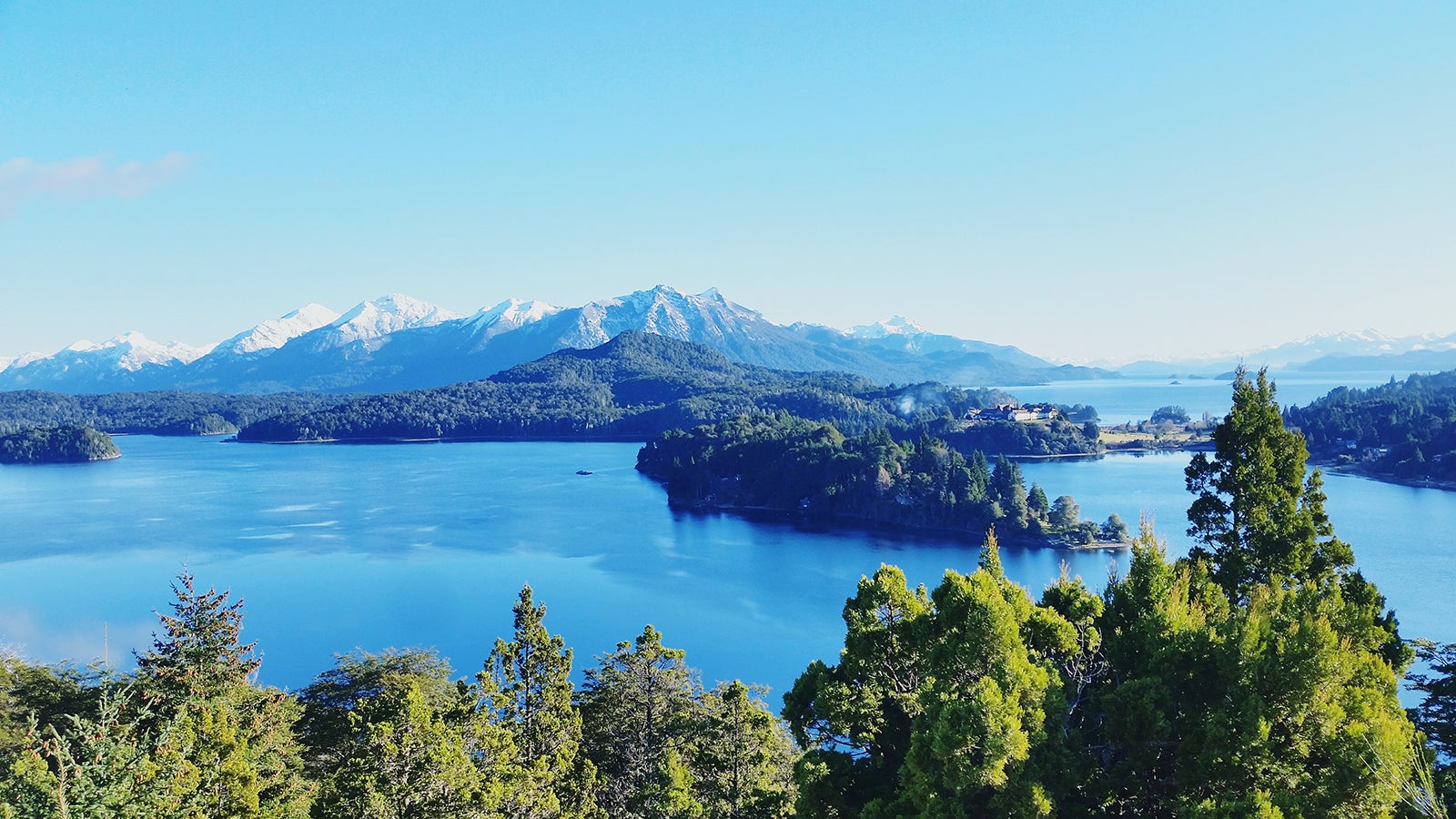
What to Do in the Valdés Peninsula and Chubut
Ringside whale-watching seats are the main draw at Valdés Peninsula , a UNESCO World Heritage Site on the Atlantic coast, and boats depart daily between June and November from Puerto Pirámides to spot the southern right. Known for their white callosities and so-called sailing technique (playfully raising fins in the air), this whale comes here to mate and calve. Wildlife fans can also observe seals, sea lions and orcas, while ostrich-like rhea and guanaco (a relative of the llama) roam the terrain.
Nearby are Welsh-founded settlements Puerto Madryn and Trelew. The latter is a small-town outpost harboring Hotel Touring Club, today a café, where you can see the room where Butch Cassidy holed up, and the MEF Paleontology Museum , which houses 17,000 fossils and remains of titanosaur, the world's largest dinosaur. Argentina's most-populated penguin colony, Punta Tombo, is also nearby, as is Gaiman, where the Welsh character remains strong and there are an array of teahouses.
Argentinians flock here for summer vacation in January and February, when average temperatures reach 80 degrees; visitors numbers also peak in July during whale-watching season.
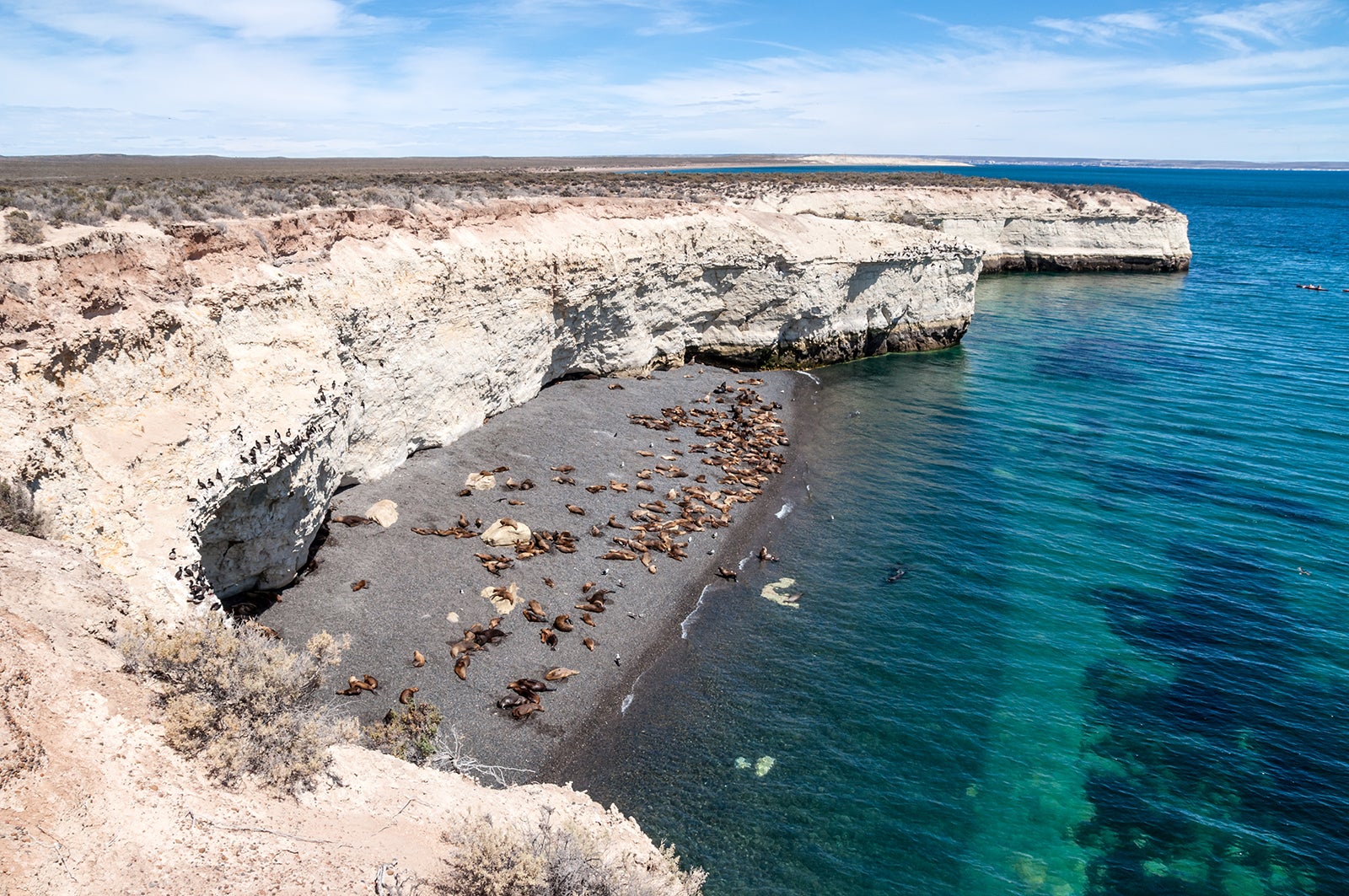
What to Do in Los Glaciares National Park, Santa Cruz
Watch it, snap it, patiently await for a rupture to fall, kayak near it, even scale it — there's little doubt that the vast, electric-blue Perito Moreno Glacier in Los Glaciares National Park is breathtaking.
Many glaciers are retreating due to climate change , but Perito Moreno keeps advancing, its light-blue 240-foot-high face and three-mile-wide behind slowly feeding Lago Argentino. If a selfie with this frozen behemoth onboard a catamaran isn't enough, consider taking an icy hike on top of it (crampons provided). The glacier has been a UNESCO World Heritage Site since 1981 and is located near El Calafate.
Other glacial showstoppers in the national park include Spegazzini, Upsala and Viedma. Take a boat excursion to enjoy all four, disembarking at Onelli Bay for a short hike through the forest and a different perspective.
Summer (January to March) is peak season with average temperatures reaching 64 degrees. Daylight can last 17 hours. Spring and autumn mean cooler weather, but fewer selfie sticks.
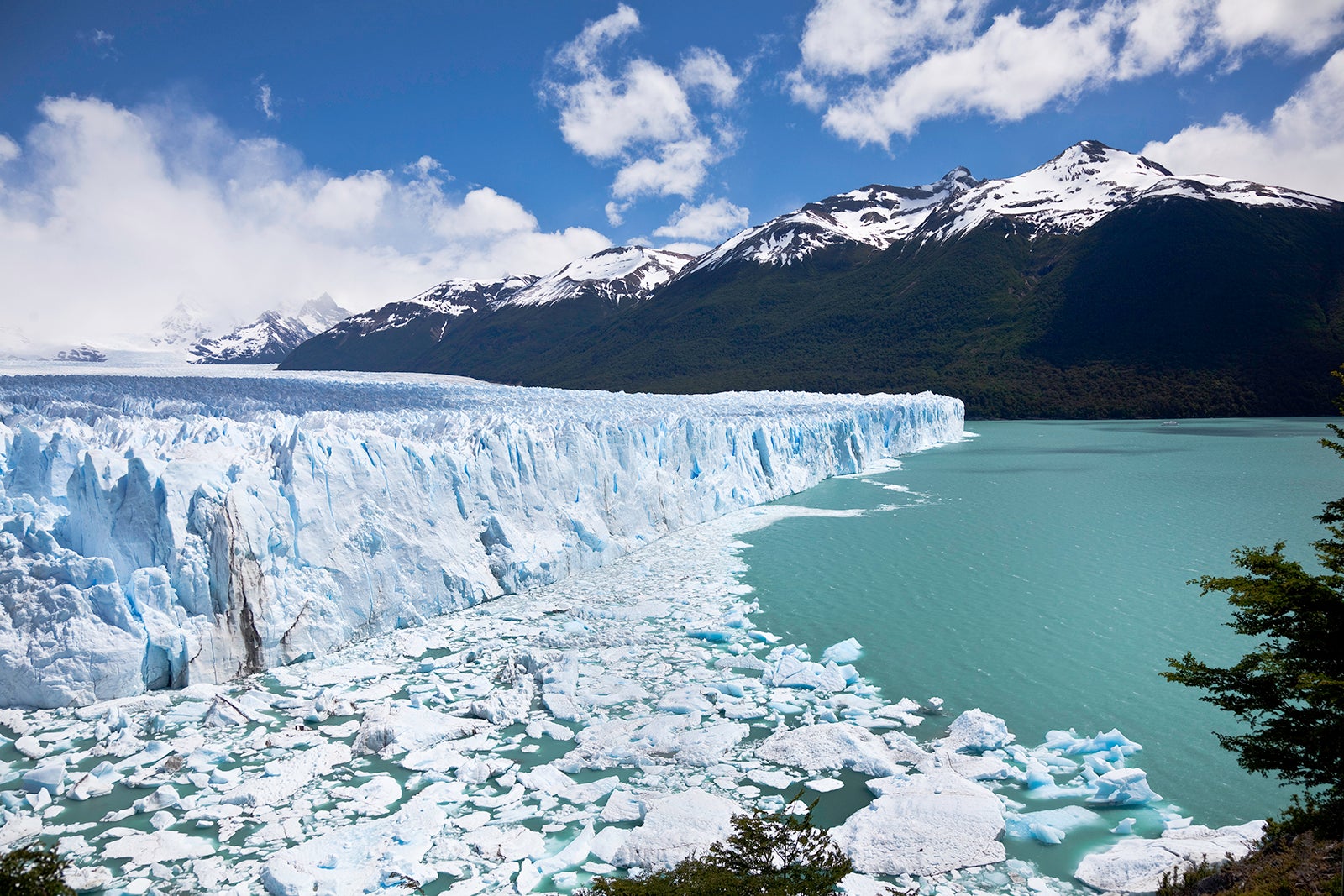
What to Do in Ushuaia and Tierra del Fuego
Flying over snowy, meringue-like peaks and down the Beagle Channel to arrive at Ushuaia — a 3.5-hour flight from Buenos Aires — is thrilling. This is, after all, the most southerly city on the planet, where four seasons in one day are the norm and you're at the whim of Mother Nature. Nestled on the shores of the legendary strait, whose icy waters were traversed by the nomadic Yaghan indigenous people 10,000 years before Charles Darwin, modern-day Ushuaia (pronounced: Oohs-why-ah) offers wilderness and nature with a touch of contemporary trading outpost.
This is actually the end of the world, so the weather is usually chilly. Visiting in summer (January to March) is peak season and brings top day temperatures of 60 degrees, making it ideal for hiking in Tierra del Fuego national park and spotting guanaco and sheldgeese. To glimpse maritime fauna such as sea lions, imperial cormorants, dolphins and pygmy right whales, circumnavigate the red-and-white Les Eclaireurs lighthouse in the Beagle Channel. Between October and April, a visit to Isla Martillo provides plenty of wobbly, flightless comedy, when Magellanic and King penguins turn this island into a colony.
For an unforgettable sea-to-plate dining experience, book into Puerto Pirata, a tiny four-table eatery a 90-minute drive from Ushuaia, where you sail out into the Beagle Channel with fishermen to haul in centolla (king crab) before it's prepared fresh just for you. Other great restaurants back in town include Kalma and Chez Manu for fine dining and Volver for seafood.
Ushuaia is a jumping off point for cruise ships on South America tours, but it's also the jump-on point for ships navigating Cape Horn (September to April) and Antarctica expeditions, (November to February).
- Skip to primary navigation
- Skip to main content
- Skip to primary sidebar
- Skip to footer
Green Global Travel
World's largest independently owned Ecotourism / Green Travel / Sustainable Travel / Animal & Wildlife Conservation site. We share transformative Responsible Travel, Sustainable Living & Going Green Tips that make a positive impact.
The 20 Best Things to Do in Patagonia (South America)

Disclaimer: This post may contain affiliate links. All hosted affiliate links follow our editorial policies .
[Updated 10/28/2019) When people ask me what is the most beautiful place I’ve ever visited, Patagonia is the first place that comes to mind. My trip to Ladakh, India is also up there, and so are the Faroe Islands . But for me, Patagonia travel ultimately has to be the winner.
But when you search for Patagonia on Google, it’s the famous clothing company that dominates the results. Patagonia, South America– which encompasses significant portions of Argentina and Chile– doesn’t even show up until you get more than halfway down the second page!
But to understand how truly underrated the Patagonia region is, just look at some of the most frequently asked questions people search for. “Is Patagonia a country?” “Where is Patagonia located?” “Is Patagonia a safe place to travel?” (All of which we’ll answer in the FAQ section below.)
Which is a shame, because the southernmost tip of South America is truly stunning. Taking a Patagonia trip reveals a sparsely populated land of seemingly impregnable granite mountains, pristine greenish-blue lakes, and mighty glaciers that will make your jaw drop with their sheer size and beauty.
There are tons of things to do in Patagonia, which is world-renowned as a haven for outdoor adventurers like us. But thankfully, the region has yet to fall victim to the rise in mass tourism .
If you love hiking, simply walk out of any town or village and you’ll likely find yourself in overwhelmingly gorgeous surroundings. Or you can head to Torres del Paine National Park , in Chilean Patagonia. There you can hike the 4-day long W Trail, which provides exceptional views of Grey Glacier .
The options for incredible Patagonia tours are endless. There’s rock climbing in the majestic mountains, viewing endemic wildlife such as Guanacos and Andean Condors, glacier hiking, exploring caves, and much more. In short, Patagonia truly is a place that you will never forget.
READ MORE: Tallest Mountains in the World (World Travel Bucket List)

FAQs ABOUT PATAGONIA TRAVEL
Is patagonia a country .
Patagonia is not a country, but a region in the southernmost part of South America. It encompasses approximately 1,043,076 square kilometers, or 402,734 square miles, in Argentina and Chile. This area includes the southern Andes mountains, deserts , pampas and grasslands, and coastal areas. It is bordered on three sides by the Atlantic, Pacific, and Southern oceans.
Where is Patagonia located?
Different people define Patagonia’s location in different ways. Most people consider the Colorado and Barrancas rivers the northern border of Argentine Patagonia, and the Huincul Fault the northern border of Chilean Patagonia. Some geographers include the southern archipelago of Tierra del Fuego as part of Patagonia, while others limit it to the mainland.
How do you get to Patagonia?
The simplest way to get to Patagonia is to fly into Buenos Aires, Argentina or Santiago, Chile. From there you may need to take a domestic flight into Punta Arenas or Puerto Natales, from which many organized Patagonia tours depart. Be aware that December to February is peak season, so you’ll want to book your flights at least 3 months in adance. Adventurous travelers may prefer to rent a car and take a Patagonia road trip, in order to stop and see the stunning sights along the way.
What’s the best time to visit Patagonia?
Patagonia is located in the Southern Hemisphere, so the region experiences winter in what you may think of as summer months (May to August) and summer in what you consider winter (December to March). Winters there are often brutally cold and windy, with up to 17 inches of rain/snow per month in some places. So it’s best to visit Patagonia in their summer, when it’s much warmer and drier.
Is Patagonia a safe place to travel?
Patagonia travel is safe in every possible way. Remember, this area is extremely remote and almost shockingly unpopulated. Patagonia’s population is less than 2 million, or about 5 people per square mile. From Patagonian deserts and mountains to glaciers that stretch for miles, this is a region of wide open spaces and very little of the crime that has plagued other parts of Latin America . In fact, Lonely Planet described it as one of the safest tourist destinations on Earth !
READ MORE: Trekking Chile’s Atacama Desert (The Driest Place on Earth)
PATAGONIA MAP
READ MORE: The 10 Best Mountains in the World (World Travel Bucket List)
PATAGONIA- ARGENTINA TOURIST ATTRACTIONS
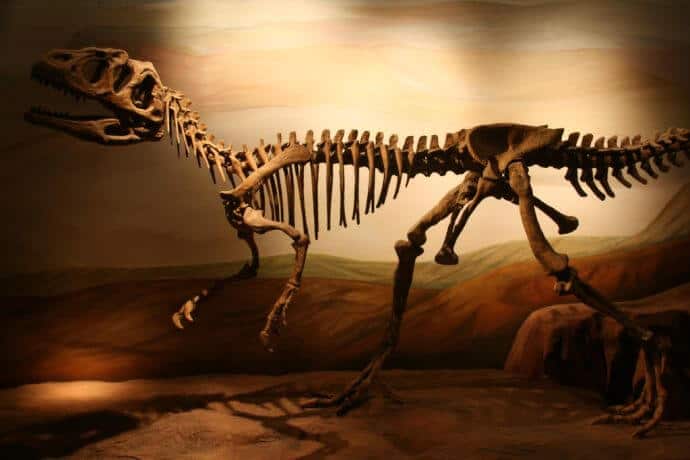
Visit the Egidio Feruglio Paleontology Museum
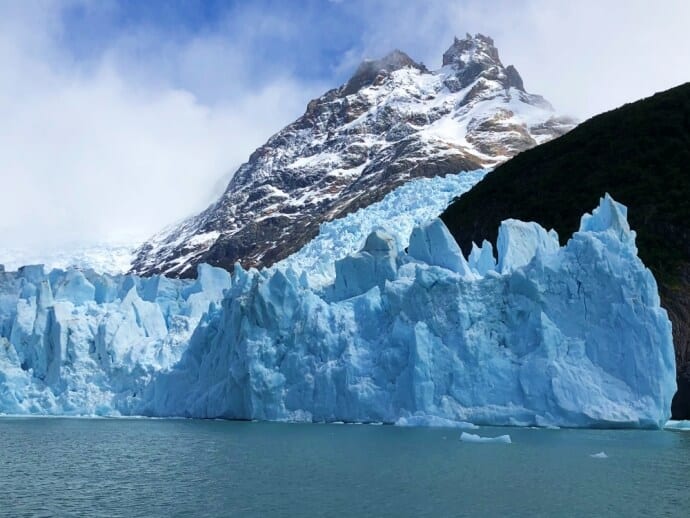
Take a Glacier Cruise on Lago Argentina
Taking a glacier cruise on Lago Argentino is sure to be a highlight of any trip to Patagonia. The boat passes oddly-shaped, bright blue icebergs on its way to the first stop, Upsala Glacier. At 10 kilometers wide, Upsala is the largest glacier in all of South America .
The boats don’t usually get too close, as the entire face of the glacier often calves (a.k.a. falls off) at the same time, creating an enormous– and dangerous– surge. Instead, you can soak in the panoramic view of the glacier from a safe distance.
The boat does stop close by one of the huge icebergs that resulted from this calving, and there are opportunities for photos with a bright blue iceberg behind you. The crew then chips off a large chunk of ice and chops it into ice cubes for drinks. So you can have a Scotch or Pisco Sour with an ice cube that is hundreds of years old.
The boat then sails to Spegazzini Glacier, which is smaller but much more stable, so you can get very close to its face. As you sail slowly past, the cliff of blue ice towers far above.
The glacier constantly cracks and rumbles as the ice shifts. If you’re lucky, you may even get to see part of the glacier fall off in a loud crash and a huge plume of water. This is truly nature at its most awe-inspiring! – James Ian at Travel Collecting
READ MORE: The Best Small Ship Cruises (World Travel Bucket List)

Cycle Through Llao Llao Municipal Park
The area of Bariloche offers many incredible trails and viewpoints, and you can find both in Llao Llao Municipal Park. One of the best hiking trails to take in the park is called Cerro Llao Llao.
This relatively short and easy hike includes walking mostly on flat surfaces and climbing for 20 minutes to the Cerro Llao Llao viewpoint. Not only does this unique spot offer breathtaking views over Llao Llao Municipal Park and Nahuel Huapi National Park, but it’s also a lot less touristy than some of the other scenic viewpoints in this area.
From here, you can either go back or continue your hike towards Villa Tacul, a quiet and secluded beach with crystal clear water.
For those who love cycling, you can also take the Circuito Chico trail, which is a 60-kilometer route that passes through the park and several other spots in the outskirts of Bariloche. If you’re inexperienced or just want some company, this trail can also be explored with an organized biking tour.
To get to the park, you’ll need to take bus number 20 from Bariloche and get off at the last stop. From there, you’ll have a short walk to the park’s entrance, where you can find a small visitor center that can provide you with a map. – Or Amir of My Path In The World
READ MORE: The Best Hiking Trails (For Your World Travel Bucket List)
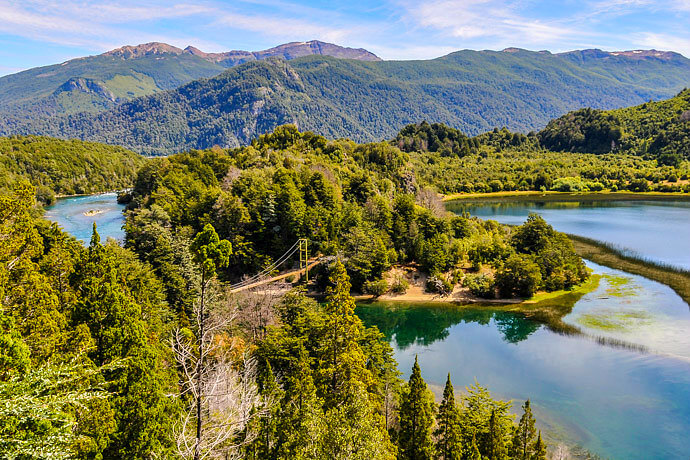
Explore Los Alerces National Park
Los Alerces National Park ( Parque Nacional de los Alerces ) is one of the most beautiful and underrated national parks in Patagonia. It’s located in Argentina’s Province of Chubut.
The main feature of the park (which also gives its name) is the alerce , a large evergreen tree that can live for a very long time. One of the oldest trees you can see, “El Abuelo” (grandfather), is 2,600 years old.
Hiking in the national park is a wonderful experience. There are several beautiful lakes to see, such as the large Lake Futalaufquen and Cisne Lake, Menendez Lake, and (our favorite) the small Green Lake. All these lakes are interconnected through river systems such as the Los Arrayanes River.
There are great viewpoints in the park from where you can contemplate some of the glaciers in the surrounding mountains.
There are quite a few self-guided paths in the park with signs that tell you a lot of information about the flora and fauna in the area. You can also combine walks with boat excursions.
The best way to get to the park is to take the official bus from Esquel. Most travelers skip this national park in Patagonia, since it lacks the awesome landmarks such as the Perito Moreno Glacier or the peaks around Chaltén.
Nevertheless, it’s very worthwhile spending a few days hiking in the pristine forests of Los Alerces National Park . -Gábor Kovács of Surfing the Planet
READ MORE: The 40 Best Backpacks for Travelers

Ski Martial Glacier
If you’re visiting Patagonia between June and October, one of the most high-octane things you can do is to go skiing. And what outdoor adventure could be more adrenaline-pumping than skiing down a glacier?
Martial Glacier is a popular Argentina tourist attraction all year round, drawing dozens of enthusiastic hikers almost every day. Even in the warmer months, the glacier is still a delight to witness. So are the spectacular views from atop the glacier, looking out over the surrounding Tierra del Fuego archipelago.
The glacier itself lies at the very top of a ski resort, so it’s essentially the starting point for some advanced ski slopes. There are 2 main slopes that run back down from the top of the ski lift. They are both south-facing, and the downhill winds often make these runs cold, yet exhilarating.
The main run is roughly 30 meters wide, but you’ll also find possible backcountry, off-piste skiing opportunities. However, these should really only be attempted with a guide. Either way, the entire experience of being at Martial Glacier is incredible, and skiing it makes for an unforgettable trip!
If you can, be sure to stay at the modern ski lodge they have, which is located not far from the base of the lift. –Bradley Williams of Dream Big, Travel Far
READ MORE: Climbing Nigardsbreen Glacier, Norway
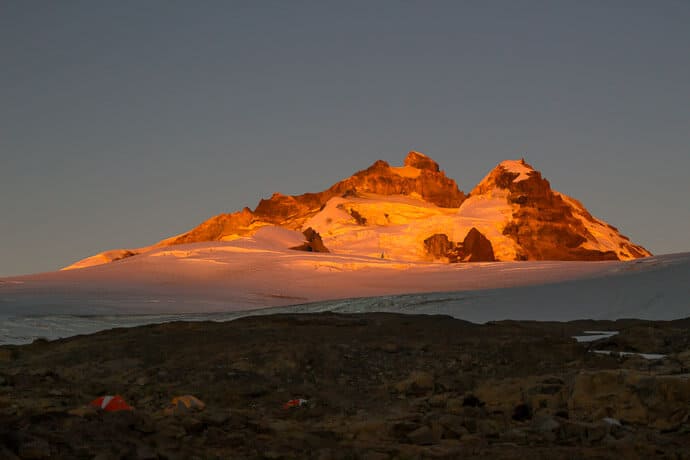
Trek to Monte Tronador
Monte Tronador is located on the border between Chile and Argentina in an area known as the Patagonian Lake District. The starting point for the trek into the mountains is from the ski resort town of Bariloche, in Argentina.
In the summer months the skiing is replaced by hiking on well-marked trails, which can be picked up just a few kilometres out of the town. The trek to Monte Tronador leaves from the Pampa Linda guest house .
If the full-day trek to Glacier Alerce and Refugio Otto Meiling is too far for your liking, there’s an option to go horseback riding for the first part of the trek.
The path winds through dense woodland before breaking out of the tree line. From here the path is clear but rugged, and the end goal of Monte Tronador can be seen ahead. The trek takes a minimum of five hours ,and a one-night stay in the mountain hut is the easiest way to complete the trek safely.
There are then two options: You can either return to Pampa Linda or continue across Glacier Alerce with a guide, and then follow Paso de Las Nubes to the glacial lake of Lago Frías, spending a night in Refugio Rocco. – Suzanne of Meandering Wild
READ MORE: How to Choose Responsible Horseback Riding Tours

Sail Near Perito Moreno Glacier
If you’re going to do just one thing in Argentina, make it a visit to Perito Moreno. It’s the most famous Patagonia glacier, and one of the most popular Argentina tourist attractions.
Standing in front of the glacier, watching chunks of massive blue ice fall into the waters of the lake below was an experience that literally moved me to tears. It was one of those times when I experienced the force of nature at its most powerful, mighty, and resilient.
Perito Moreno is one of the few ice fields that has withstood global warming. As a result, it is not retreating, it’s actually advancing. Glaciers are dynamic entities, pushing their way through the mountains. Calving (ice falling into the lake) is a totally normal phenomenon.
There are various ways to get close to Perito Moreno: You can walk on the glacier, sail near it, or simply watch it from the viewing platforms nearby. – Margherita Ragg of The Crowded Planet
READ MORE: The Best Mountains in the World (World Travel Bucket List)
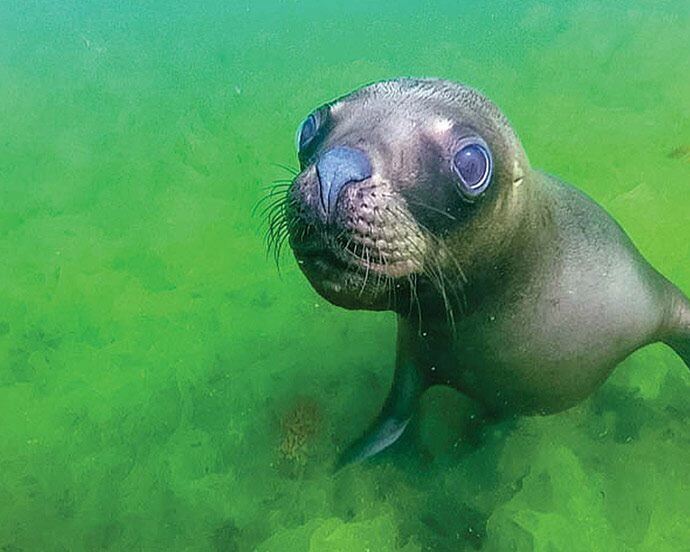
Snorkel with Sea Lions in Reserva Loberia de Punta Loma
When it comes to watching wildlife , not many people think of heading to Argentina. But Patagonia is teeming with wildlife, both on land and in the sea.And for a lot of the best animal encounters , there’s no need to join expensive package tours because it’s easy to manage do-it-yourself itineraries in the area.
For a memorable marine experience, head to the Reserva Loberia de Punta Loma, the provincial reserve located less than 10 miles southeast of Puerto Madryn. It’s an easy drive for doing a Patagonia road trip , or a quick 30-minute taxi ride from the city.
From the point, it’s possible to see lots of sea lions playing in the waters of Golfo Nuevo or lounging on the shore. But for a truly immersive experience, why not snorkel with these playful, curious creatures?
Because Loberia de Punta Luma is a protected nature reserve, your time in the water is limited to 20 minutes. Only a certain number of boats can be in the area at the same time, so booking an organized tour for this adventure is a must. For those that are certified, it is also possible to go Scuba diving with the sea lions. – Christina Wagar of Wandering Wagars
READ MORE: Swimming with Galapagos Islands Sea Lions

Walk on Viedma Glacier
If you travel to Patagonia, you simply can’t miss the opportunity to do a glacier hike. And while Viedma may not be as well-known as the nearby El Chalten, it’s still well worth a visit.
Perito Moreno is the most famous glacier in Patagonia, but hiking it tends to be a bit pricey and quite crowded. Viedma is honestly just as spectacular to see as Perito Moreno, but with only a handful of tourists around.
Once you arrive at Viedma, you’ll strap your crampons on, grab a harness and an ice axe, and follow your guides as they make their way up the glacier’s edge, around deep-blue crevasses and pinnacles.
Once you’re out on the glacier, you may be able to try your hand at ice climbing. Also, if you get a chance, be sure to enjoy a glass of Scotch or Bailey’s Irish Cream with the purest (and probably oldest) ice you’ll ever have! – Margherita Ragg
READ MORE: Patagonia Flowers in Torres del Paine National Park
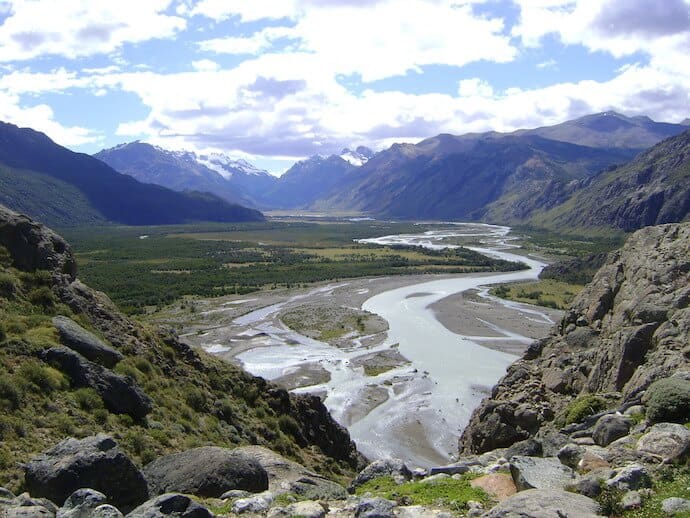
Hike around El Chalten
If Torres del Paine is the hiking capital of Chilean Patagonia (and it is), then El Chalten is the go-to place on the Argentinian side.
Everything around El Chalten seems to cater to adventure travelers, with loads of hiking maps, shops selling mountaineering and camping gear, and several hotels with spas to relax those weary limbs.
We recommend two hikes specifically. The first one is Laguna de los Tres, a day-long hike weaving down a valley and then up to the laguna, where it’s possible to enjoy a great view of Cerro Fitzroy, one of the iconic Patagonian mountains.
The hike is fairly strenuous, but doable by just about anyone with a reasonable fitness level. The trail is popular and well marked. If you get thirsty, you can just fill your water bottle at one of the many streams running parallel to the trail.
The second hike is Laguna Torre, which is a little shorter than the hike to Laguna de los Tres, but no less beautiful. It ends at a gorgeous lake with a spectacular view over the saw-toothed profile of Cerro Torre’s summit. – Margherita Ragg
READ MORE: 60+ Cool Camping Gear Reviews

Go Whale Watching Around Peninsula Valdés
Peninsula Valdes is the main sight on the Atlantic side of Argentinian Patagonia, and it is truly a must-see for wildlife lovers.
Between May and November, the coastal area off Puerto Madryn is a breeding ground for Southern right whales , and seeing these endangered whales is practically guaranteed.
Orcas also travel these waters, and often get right up onto the shore in order to hunt for sea lions and seals on the beach. It’s a spectacular sight that you may be lucky enough to experience on a whale-watching tour of the area.
However, in Peninsula Valdes wildlife can also be seen away from the coast. You’ll be able to spot iconic Patagonian wildlife such as Guanacos, Rheas (a small ostrich-like bird), Maras (a cross between a large guinea pig and a hare), and Dwarf Armadillos. -Margherita Ragg
READ MORE: Whales in Antarctica

See Magellanic Penguins at Punta Tombo
Punta Tombo– a narrow rocky strip on Argentina’s central coastline that stretches around 2.2 miles (3.5 kilometers) into the sea– is home to the largest colony of Magellanic penguins in all of Latin America.
The beaches are wide with a gentle slope and lots of shrubs and burrows, which makes it an ideal place for Penguins to make their nests. This explains why there are so many penguins here– around 500,000 mating pairs– and why Punta Tambo was declared a protected wildlife conservation area in 1979.
You can visit Punta Tombo and walk amongst the penguins on trails and boardwalks, which is one of the most memorable things to do in Patagonia. You can’t help but being charmed by their personalities, which are curious, but quite shy. They look up to study you, tilting their heads from one side to the other as they take you in. It’s absolutely adorable!
Magellanic penguins are only around two feet tall, which is about half the height of their King and Emperor penguin cousins in Antarctica. They gather in Punta Tombo from mid-September to mid-April to nest, mate, breed, and moult (shed their feathers).
Between April and September, they migrate to the warmer climates of southern Brazil. There they remain on the water the entire time, even when sleeping, until they head back to Punta Tombo to start the circle of life once again. -Stefan and Sebastien of Nomadic Boys
READ MORE: The Adorable Penguins of Antarctica
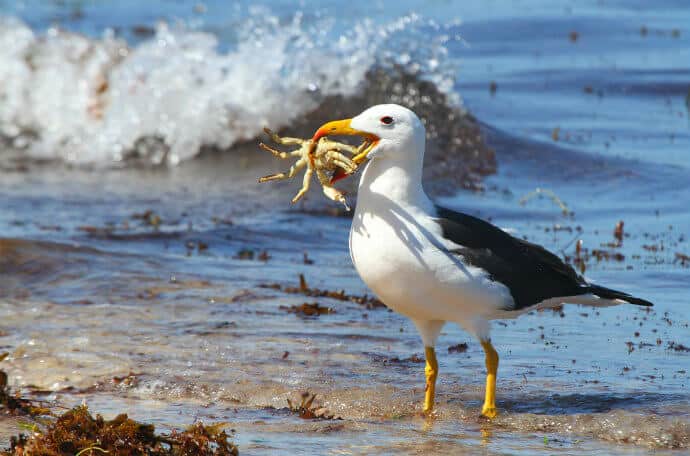
See Patagonia Wildlife in the Beagle Channel
If you’re an intrepid adventurer who has made it all the way to Ushuaia, Argentina, you won’t want to miss the opportunity to explore the famous Beagle Channel. The town is aptly called El Fin del Mundo , or the end of the world, because it is the southernmost city on the planet.
You can explore the Beagle Channel by getting on a boat and sailing into the open water, just as Charles Darwin did on his ship the HMS Beagle , for which the channel is named. Beagle Channel boat tours leave the docks in Ushuaia, sail past the historic Les Eclaireurs Lighthouse, and travel in and around some of the local islands.
Along the way, you’ll have the chance to see many different types of wildlife , including the sea lions at Sea Lion Island, colonies of black and white cormorants, giant albatross, and– depending on the timing of your trip– even a colony of Patagonian penguins!
Some boat tours also include time for a mini-trek on one of the Beagle Channel islands , which is a great way to learn more about the plants and less-visible types of Patagonia wildlife.
If you can, head out into the Beagle Channel in the morning of your first day in the area. If your tour is cancelled because of Ushuaia’s quick-changing weather and water conditions, you’ll have a chance to get rebooked for the afternoon or next day and not miss this must-do Patagonia tour! -Jackie Sills-Dellegrazie of The Globetrotting Teacher
READ MORE: Ushuaia, Argentina: The End of the World
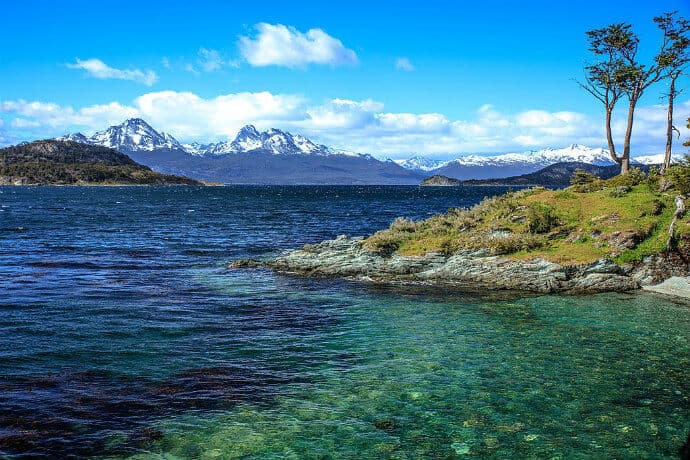
Visit the Tierra del Fuego Archipelago
The southernmost Argentina tourist attraction is the islands of the Tierra del Fuego, beyond which there is only Antarctica .
Located across the Strait of Magellan, the archipelago is divided fairly equally: Argentina controls the eastern half of Isla Grande de Tierra del Fuego, while Chile controls the western half as well as the islands located south of the Beagle Channel.
These “islands of fire” have been inhabited for at least 10,000 years, and were named after the fires of natives spotted from the sea during Ferdinand Magellan’s 1520 expedition. These indigenous people were ultimately displaced during the Patagionian sheep farming boom of the late 19th century.
Today, Tierra del Fuego remains a wild, windswept land, with dwarf lenga forests and some plants that don’t exist anywhere else on Earth. It includes the true southern tip of South America, Cape Horn, which can be isited on a 3-day cruise out of Ushuaia (where most Antarctica cruises depart).
The archipelago is teeming with wildlife, including Whales, Dolphins, Sea Lions, Guanacos, and a variety of Penguins and seabirds. We also did a day trip to Estancia Harberton, where we explored more Fuegian nature and learnt about the life of Patagonian pioneers. – Margherita Ragg
READ MORE: 60 Weird Animals Around the World
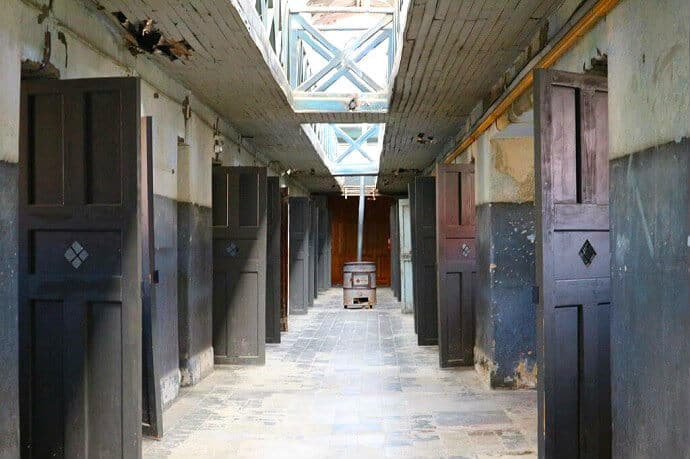
Visit the Museo Maritimo y del Presidio
You’ll be surprised by the amount of things to do in Ushuaia, the town at the end of the world. One of the most interesting is a visit to the Museo Maritimo y del Presidio , or Maritime Museum and Old Prison complex.
The prison is modeled after Port Arthur Prison in Tasmania, Australia . This is where the most brutal criminal offenders in Argentina went to live out their sentences, away from the general population.
The prison was constructed in 1846 with almost 300 cells, and closed in 1947 amid widespread rumors of prisoner abuse. The prisoners were put to work creating infrastructure, including a popular tourist attraction known as the Train at the End of the World, which runs through Tierra del Fuego National Park (another Ushuaia-area gem).
Today the attraction recreates what conditions were like during the prison’s existence. History buffs will enjoy the stories and scandals from this distant, isolated region in the 1800s, with wax figurines helping to tell the tale.
The Museo Maritimo part of the complex houses ship models, antique maps, and maritime artifacts. The exhibits tell the story of early explorers like Ferdinand Magellan, who navigated these waters while seeking routes between the oceans and researching the area. There is also an exhibit dedicated to penguins and, more incongruously, a doll museum.
Entrance fee to the entire complex is currently the equivalent of about US$20. The museum is open from 10 am to 8 pm. – Talek Nantes of Travels with Talek
READ MORE: The Top 10 Living History Museums in America
PATAGONIA CHILE TOURIST ATTRACTIONS
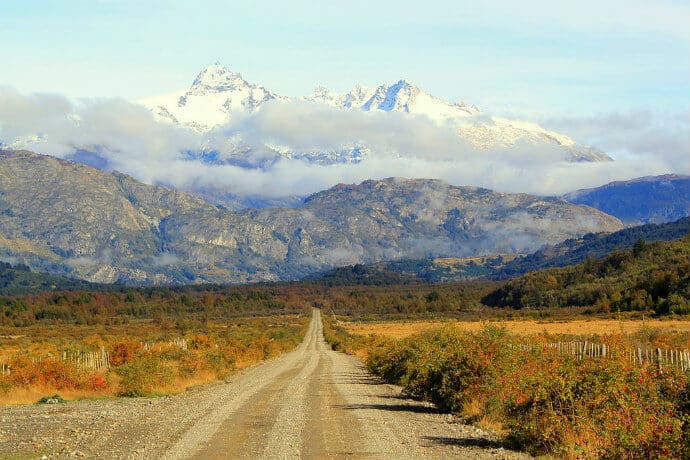
Drive the Ruta 40 or Carretera Austral
The Ruta 40 stretches through Argentina, over 3000 miles from the Bolivian border at la Quiaca to Rio Gallegos in the Santa Cruz province. It travels all across Argentine Patagonia, including the mountain and lake paradises of Bariloche and El Bolson and the Perito Moreno.
The Ruta 40 isn’t the quickest way to travel the region: it’s a long and winding road, most of which is unpaved. But it offers beautiful Patagonia mountain views and a true feel of adventure along the way.
The Chilean Patagonia counterpart is the Carretera Austral, an incredibly scenic road that runs 770 miles from Puerto Montt to Villa O’Higgins. This road was built by Pinochet in order to connect remote communities, and travels through thick forests , past fjords, glaciers, and mountains.
Some points of interest along the Carretera Austral include Queulat National Park (which is home to stunning glaciers) and the unlucky town of Chaiten (which is close to glaciers and the Futaleufu River, one of the best white-water rafting locations in South America). – Margherita Ragg
READ MORE: The World’s Best Road Trips (World Travel Bucket List)

Hike Cerro Castillo National Reserve
Chilean Patagonia is an amazing region for hiking enthusiasts, with dozens of multi-day trekking routes and hundreds of day hiking trails offering incredible scenery.
Cerro Castillo National Reserve is off the beaten tourist path compared to more famous places like El Chalten or Torres del Paine. As a result, there are significantly less people there. The reserve offers two hiking routes– a day hike to Laguna Cerro Castillo, and a 4-day trek through a large portion of the park. Both routes are well-marked and relatively easy to follow.
The day hike starts and ends in Cerro Castillo village. It’s a 7.5-mile (12-kilometer) return route that takes hikers 2952 feet (900 meters) up to the Mirador Cerro Castillo, then back down to the village. Depending on your hiking pace, it takes about 7-8 hours to complete the round-trip hike.
The multi-day trek is 31 miles (50 kilometers), so you’ll need four to five days to complete it. This is an unguided hike of moderate difficulty, starting at Las Horquetas and ending at Villa Cerro Castillo.
The reserve itself has very little infrastructure. There are four established campsites with basic facilities– no shops, restaurants, or accommodations whatsoever inside. So those who decide to do the multi-day hike will have to bring their own camping gear and food.
The scenery in Cerro Castillo is stunning, with hanging glaciers, turquoise lakes, lush green valleys, indigenous forests, and breathtaking views. We’ve spent a lot of time trekking in the region, and Cerro Castillo was one of our favorite places in Patagonia. -Campbell & Alya of Stingy Nomads
READ MORE: The Best Hiking & Walking Shoes for Travel
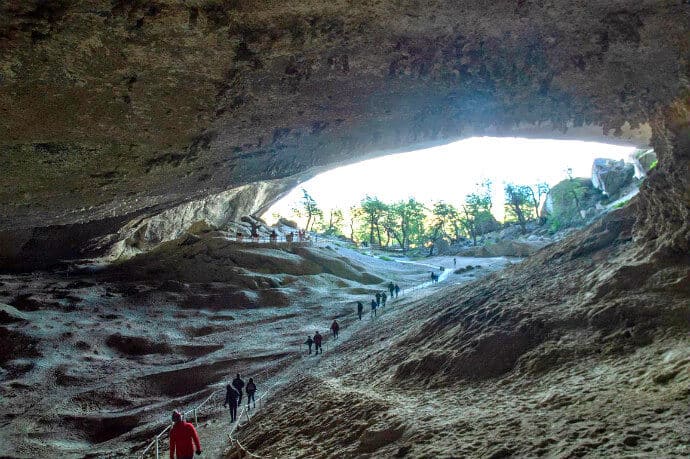
Explore the Archaeological Site at Milodon Caves
If hiking in Patagonia is not your thing, or you’re tired after finishing your W-trek in Torres del Paine, the Milodon Caves near Puerto Natales offers a great opportunity for a half-day trip full of history.
The Milodon Caves is an active archaeological site , with new finds occurring fairly regularly as the excavation of the site progresses (mostly ancient tools, firewood, and animal bones).
There is one bigger and 2 smaller caves, all of which were formed by erosion of a glacier at the end of the Ice Age. In the late 19th century, the 10,000-years-old remains of a Giant Sloth (a.k.a. the Milodon) were found here. Evidence suggest that these caves were also inhabited by humans later on.
The area around the Milodon Caves is yet another gem of Patagonia Chile. All three caves are connected by a short walk, and there is a lookout point at the top of the largest cave. So everywhere you walk, you get a wonderful view on the surrounding peaks.
The caves are located about 20 kilometers from Puerto Natales, and easily accessible via the main road if you’re taking a road trip. If you don’t have your own car, there are numerous tour operators that include the attraction as part of a guided Patagonia tour. – Tereza Letalova of Czick On The Road
READ MORE: The Top 10 Caves in the World (World Travel Bucket List)

Visit the New Parque Nacional Patagonia
A scattering of Guanaco graze on the pampa grassland in front of the park’s visitor’s centre. Occasionally a ñandu (a.k.a. Rhea, a relative of the Octrich and Emu) shuffles into view. If you glance at the sky above, you might well spy an Andean Condor. On the trails that wind through thickets of southern beech that blush red in fall roams the king of Patagonia, the powerful Puma.
Parque Nacional Patagonia is one of Patagonian Chile’s newest national parks. It was opened in 2018 as part of the epic land donation by Kristine Tompkins (the widow of North Face founder Doug Tompkins).
Lying south of Coyhaique on a stretch of the Carretera Austral that is infrequently visited by tourists, the park promises dazzling landscapes that have been “rewilded” back to their natural state. There’s also well-considered infrastructure, including campgrounds, a restaurant, and a luxury lodge .
In the center of the park (known as Valle Chacabuco) there are five hiking trails. These range from short day hikes to longer routes such as the Lagunas Altas, which passes between lakes of glacial hues.
For the most intrepid adventurers, you can cross through the mountains into the northern sector of the park, Jeinimeni, on a four-day hiking trek. It’s an incredible experience, and you’re practically guaranteed not to see a single other hiker along the way. – Steph Dyson of Worldly Adventurer

Hike in Torres del Paine National Park
Torres del Paine arguably offers the best hiking in Patagonia, and easily ranks among the best tourist attractions in Chile. The most famous trail here is the W, which is named after its shape, as it weaves in and out of valleys that allow you to get close to glaciers and mountains.
The highlights of the national park include Grey Glacier, Valle Francés, and the granite peaks of the Torres del Paine massif, which can be reached on foot after a strenuous ascent on a sandy moraine.
Most people just hike the W when visiting the national park, even though there’s many more things to do in Torres del Paine. You can hike the Fauna Trail (which provides close-up views of Chilean wildlife such as Guanacos and Andean Condors), visit the prehistoric Milodon Cave, and go canoeing or kayaking in one of the park’s numerous glacial lakes.
But don’t let the majestic mountains, amazing animals, and glistening lakes distract you from noticing the little things along the way. Patagonia flowers may be small by comparison, but they’re equally dazzling in their color and variety! – Margherita Ragg
Looking to travel to Patagonia South America?
Check out the following services we use!
DollarFlightClub or Airfarewatchdog to find a cheap plane tickets.
Booking.com or Agoda to find a hotel deals.
Viator for a stellar day tour.
Lonely Planet for Travel Guides.
World Nomads for Travel Insurance.
Rental Cars.com for Car Rentals .
TrustedHousesitters we’ve found great pet sitters to watch our house and love on our two dogs!
Looking for essential Travel Gear? Check out these great options!
The Best Travel Clothes for Women & Men
The Best Travel Shoes
The Best Vegan Boots for Women & Men
The Best Backpacks for Travelers
Plastic Free Products for Travelers
Cool Camping Gear
Best Camping Tents for Families
About the Author
Green Global Travel is the world's #1 independently owned ecotourism website encouraging others to embrace sustainable travel, wildlife conservation, cultural preservation, and going green tips for more sustainable living.
We've been spotlighted in major media outlets such as the BBC, Chicago Tribune, Forbes, The Guardian, Lonely Planet, National Geographic, Travel Channel, Washington Post and others.
Owned by Bret Love (a veteran journalist/photographer) and Mary Gabbett (business manager/videographer), USA Today named us one of the world's Top 5 Travel Blogging Couples. We were also featured in the 2017 National Geographic book, Ultimate Journeys for Two, for which we contributed a chapter on our adventures in Rwanda. Other awards we've won include Best Feature from both the Caribbean Tourism Organization and the Magazine Association of the Southeast.
As Seen On…

Join the 300,000+ people who follow Green Global Travel’s Blog and Social Media
- 2.1 Western Patagonia
- 2.2 Eastern Patagonia
- 3 Other destinations
- 4.1 Geography
- 4.2 Culture
- 5.1 By plane
- 6.2 By train
- 6.3 By thumb

Patagonia is a region in southern Argentina .
Regions [ edit ]
Cities [ edit ].

The most important cities and towns from north to south:
Western Patagonia [ edit ]
- -38.951833 -68.059194 1 Neuquén – The largest city in Patagonia and the cultural centre of the Upper Río Negro valley, a modern city with good river beaches, about 260,000 inhabitants.
- -40.761647 -71.644764 2 Villa la Angostura – A lake side town opposite from Bariloche with access to National Park Los Arrayanes and the 12-km trail to the famous Bosque Arrayanes.
- -41.095 -71.506111 3 Colonia Suiza – A picturesque village with Swiss origins near Bariloche.
- -41.15 -71.3 4 San Carlos de Bariloche – A busy tourist destination and ski resort with 100,000 inhabitants, located in a stunningly beautiful landscape in the Southern Andes at the shore of the Nahuel Huapi lake inside the Lake District with many popular national parks nearby.
- -41.966667 -71.533333 5 El Bolsón – A small hippie town (founded in the 1970s) in a mountainous valley about 120 km (75 mi) south of Bariloche. There's a twice weekly outdoor flea market, and nearby are many decent hiking opportunities, like Lago Puelo .
- -42.9 -71.316667 6 Esquel – In the North-West of Chubut, a ski resort with about 40,000 inhabitants and a popular steam train.
- -43.083333 -71.466667 7 Trevelin – The traditional center of Welsh settlement in Patagonia, with tea rooms, souvenirs, and the whole nine yards
- -49.331408 -72.886129 9 El Chalten – Often called the capital of trekking, an impressive and inexpensive must-see town bordered by glaciers of the surrounding Parque National Los Glaciares with the popular Mount Fitz Roy and Cerro Toro, as well as the largest glacier of Argentinia, the Viedma Glacier.
- -50.337778 -72.26 10 El Calafate – A popular and very touristy destination with access to the famous Perito Moreno Glacier , though a little over-commercialised and not much hiking.
Eastern Patagonia [ edit ]
- -40.8 -63 11 Viedma – The capital of the Río Negro Province in the east with the El Cóndor beach resort, along Ruta 3 between Bahía Blanca and Las Grutas.
- -40.733333 -64.95 12 San Antonio Oeste – A port city with the popular Las Grutas beach resort town, as well as the picturesque Playa Las Conchillas and Playa Piedras Coloradas nearby.
- -42.772967 -65.03661 14 Puerto Madryn – A tranquil city and gateway to the Valdes Peninsula nature reserve and the penguin colony Punta Tombo , with a good beach and a well known diving destination; about 100,000 inhabitants.
- -43.253333 -65.309444 15 Trelew – Gateway to the region with an airport, south of Puerto Madryn and close to Valdes Peninsula .
- -45.866667 -67.5 16 Comodoro Rivadavia – At the Atlantic coast, a busy city located between colourful hills and beaches, with about 200,000 inhabitants and Argentina's petrol industry centre.
- -49.306953 -67.729785 17 Puerto San Julián – At the east coast, notable as the winter camp for Magellan's round the world expedition.
- -51.623333 -69.216111 18 Rio Gallegos – South-east before Tierra del Fuego, travelling hub to reach Ushuaia and Tierra del Fuego .
Other destinations [ edit ]
- -42.5 -63.933333 1 Valdes Peninsula – Near Puerto Madryn, an important nature reserve at the Atlantic coast (whales, sea lions, dolphins, penguins) which was listed as a World Heritage Site by UNESCO in 1999.
- -50 -73 2 Los Glaciares National Park – In the South-West, with the Perito Moreno Glacier near El Calafate , as well as Mount Fitz Roy , Cerro Torre and the Viedma Glacier near El Chaltén .

The Lake District near San Martin de los Andes , Villa la Angostura , San Carlos de Bariloche , El Bolsón , and Esquel (from north to south):
- -41 -71.5 5 Nahuel Huapi National Park
- -42.066667 -71.616667 6 Lago Puelo
- -42.8075 -71.898889 7 Los Alerces National Park – A world-heritage national park
Understand [ edit ]
The region is bordered in the north by the Cuyo and Pampas regions, by Chile's part of Patagonia in the west and by the Atlantic Ocean in the east. South of it lies the archipelago of Tierra del Fuego , the Land of Fire.
Geography [ edit ]
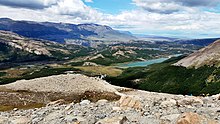
The enormous terrain is divided into two sub-regions. The West, with the southern Andes , is a green and humid area with woods, beautiful lakes and glaciers in the southern part. Here, most major tourist attractions like the Nahuel Huapí and the Los Glaciares National parks are located, and there are also South America's premier ski resorts. It is an outdoor sports paradise, with many options for walking, trekking, mountain-biking, paragliding and rafting. In the North, a transition region to the dryer Central Andes, the beautiful Pehuén or Araucaria woods can be visited. The climate of this region is relatively cool and rainy, but much sunnier than the Chilean side of the Andes. Above an altitude of 1000 m, snow is common in winter.
The East, with the Meseta , is a rough and windy steppe landscape that covers around 80% of the area. Its most well-known attractions are the beaches of Río Negro province, with the warmest water temperatures in Argentina, and the nature reserve on Valdés Peninsula in Chubut province. There are little known but very beautiful areas like the Chubut river valley, the colourful petrified woods and the enormous lakes around Sarmiento, the Chocón and Piedra del Águila reservoirs in Neuquén and the bays and mountains surrounding Comodoro Rivadavia. The climate is temperate, with surprisingly hot summers in the North and more temperate temperatures in Santa Cruz, cool to cold winters with almost no snowfall and many windy days, above all in spring.
Culture [ edit ]
Patagonia was one of the last regions of Argentina to be colonized by Europeans; though the all of the coast was visited by Magellan's circumnavigation already in 1520. Most cities date from the early 20th century. Mainly in the Andean region, rural indigenous people from the Mapuche nation still preserve their traditions, although their language is barely spoken today. From time to time there are conflicts between indigenous settlers and land owners, but tourists are usually not affected.
In some areas, traditions of immigrant groups had a strong influence on architecture, cuisine and festivals. Among people of European origin, besides from Italians and Spaniards making up the majority of the Argentine population, the most important groups are the Welsh in Chubut province, the English in Río Gallegos and the Germans in the area around Bariloche. Neuquén hosts a strong community of Chilean origin, and Comodoro Rivadavia is home to a large immigrant group from Bolivia.
Read [ edit ]
- Patagonia: A Cultural History , by Chris Moss – An overview of the indigenous narratives, travel writing, literary works and films of Patagonia.
Get in [ edit ]
By plane [ edit ].
The biggest airports in the region are the Bariloche ( BRC IATA ) and the Neuquén airport ( NQN IATA ), with flights to several Argentine destinations. For the Atlantic region, the Trelew airport ( REL IATA ), near Puerto Madryn ( PMY IATA ) and Comodoro Rivadavia ( CRD IATA ) offer the best connections.
El Calafate ( FTE IATA ) is served by Aerolíneas Argentinas, Aerochaco, LADE Airlines, and LAN Argentina. Also Río Gallegos ( RGL IATA ) has an airport, this airport is served by Aerolíneas Argentinas, LAN Chile and LAN Argentina.
By car [ edit ]

National Route 40 borders the Patagonian Andes from north to south, connects the region with Mendoza province and is a major tourist route. Chilean Route 255 (this road comes out from Route 9) crosses into Argentina becoming Route 3 , the most important connection of the Atlantic coast, connecting it with Buenos Aires and other major Central Argentine cities. More routes in this region include the east-west connections Route 22 , 23 , 25 and 26 and Provincial Route 5 in Santa Cruz, connecting Río Gallegos and the Los Glaciares area.
By bus [ edit ]
In Argentina many travellers usually travel by long distance buses. These trips are much more longer than travel by plane, but can be much cheaper, too. For example travel from Buenos Aires to Neuquén takes about 16 hours, but by plane the trip takes about 2 hr. Check this the Argentinian bus company's website for example, to check prices or schedules. It is recommended to buy the ticket two or three days before the trip (at least) to get a better price for it.
Get around [ edit ]
The best connections are alongside Ruta Nacional 3 at the Eastern side of Patagonia. In the South Andes, there are pretty good short- and mid-distance connections, but there is no line going directly from the northern part around Bariloche to Los Glaciares.
Beware that in the summer buses are often full, you should book some days in advance (above all around Christmas, New Year, January 15 and January 31).
By train [ edit ]
There is a fairly well-maintained night train service connecting Viedma, San Antonio Oeste and Bariloche. All other long-distance passenger service are suspended.
By thumb [ edit ]
Once you are sufficiently south in Argentina and Chile it is easy and safe to hitch-hike. Save money on bus travel and hitchhike your way up and down Ruta 40 or Ruta 3. However, a tent is advisable due to the large distances, lack of budget accommodation and sometimes rare traffic. If you don't have a tent, try to start hitchhiking really early in the morning so you don't arrive after nightfall. New places seem much more interesting and welcoming in the daytime. Always have a backup plan, the weather in Patagonia can be strenuous.
Most often you will be picked up by truck drivers that are bored and are trying to stay awake; they usually want to talk. As a woman, try not to fall asleep when hitch-hiking and be careful, even if it is Patagonia.
See [ edit ]
- Near Puerto Madryn are the penguin colonies of Punta Tombo and Camarones .
- -44.914197 -65.547371 1 Pinguinera Cabo Dos Bahias . Instead of the ridiculously overpriced Punta Tombo National Park, head here for an equally good experience and meeting with the penguins, for free. ( updated Jun 2018 )
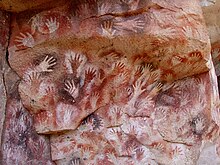
Also, along the main routes on the east and west coast the following interesting sights can be found:
Do [ edit ]
- View the Patagonian Ice Sheet from an airplane or nearby mountain.
Eat [ edit ]
In Patagonia, there are plenty of unique and delicious things to eat. As in all of Argentina, beef is important, but particular to the area is the cordero , lamb, which is of a unique flavor (supposedly because the Patagonian lamb eats a mixture of herbs found only in Patagonia) especially when grilled in the typical parrilla (grill).
- Dulce de leche – Similar to caramel and made by adding sugar to milk and cooking it, is used on nearly all desserts, including facturas (pastries eaten for breakfast or tea, or to accompany mate, filled with dulce de leche, dulce de membrillo, crema pastelera, roquefort, or many other things), alfajores (traditional cookies that consist of tiny biscuits stuck together), and many other Argentine desserts.
Drink [ edit ]
- Mate (pronounced MAH-tay) – A bitter tea, is drunk very frequently. Adding sugar is not rare because of its bitter taste. Other things are commonly added, including milk, sugar, lemon or orange rinds and cinnamon sticks.
Go next [ edit ]
- Chile – Many people cross between Chile and Argentina in Patagonia, or even go back and forth depending on the sights and travel options.
- Tierra del Fuego – The very south of Argentina, though if you travel overland you still need to travel through Chile.
- Articles without Wikipedia links (via Wikidata)
- Has custom banner
- Has mapframe
- Maps with non-default size
- Has map markers
- Airport code pages missing
- Outline regions
- Outline articles
- Region articles
- Bottom-level regions
- Has Geo parameter
- Articles Geo different to Wikidata
- All destination articles
- Articles with Wikipedia links related to but different to article
- Pages with maps
Navigation menu
12 unmissable hikes in Patagonia: wonder at the pristine wilderness
Nov 16, 2021 • 10 min read
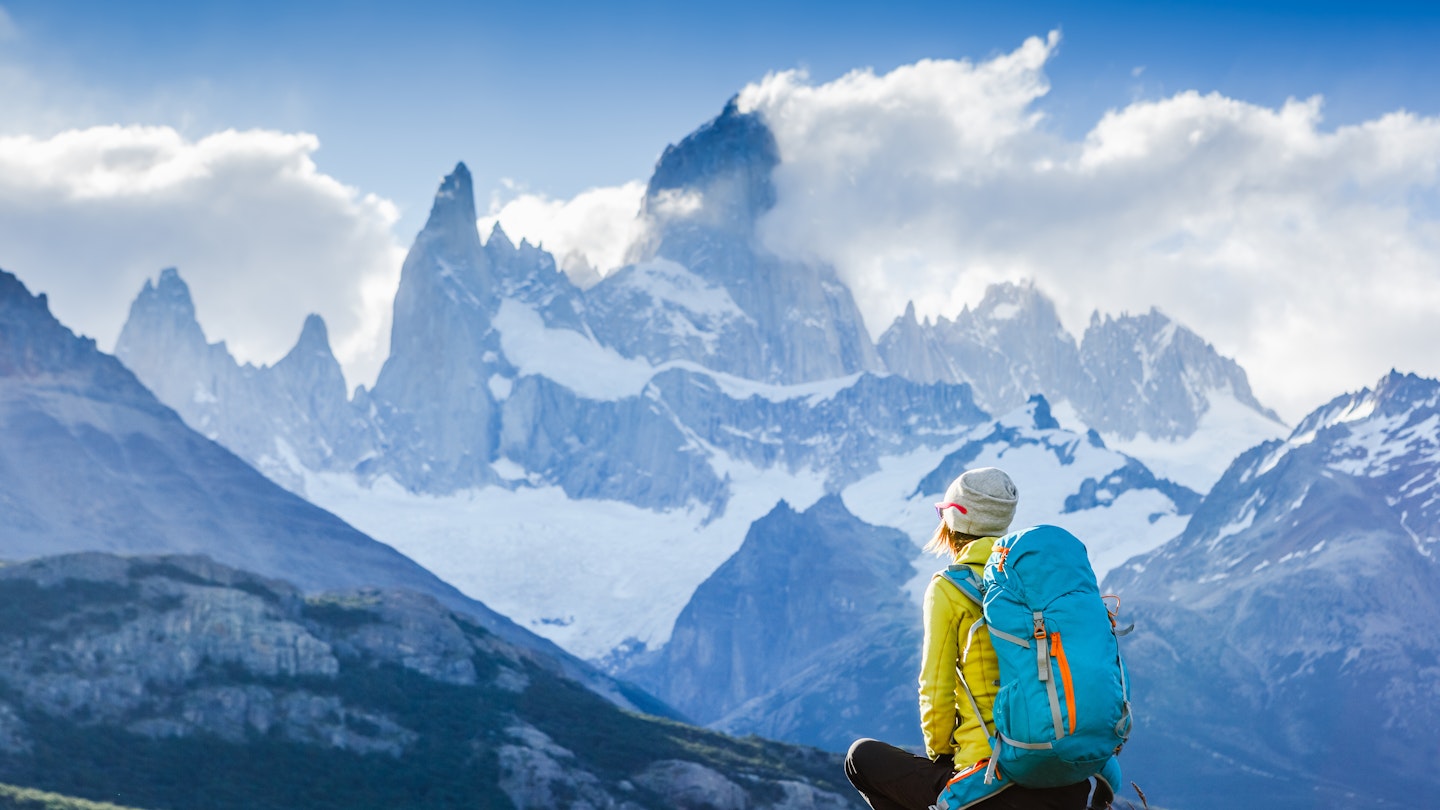
From short walks to multi-day treks, there are many inspiring hikes to choose from in Patagonia © Olga Danylenko / Shutterstock
The name “Patagonia” typically conjures up visions of endless pampas (grasslands) and southern cowboys, but there is so much more to the region than that. Covering a massive chunk of southern Chile and Argentina , this unique 402,734 sq mile region is a patchwork of diverse terrains and microclimates that challenges and surprises hikers of all abilities.
Criss-crossed by glacial rivers and streams, alternately covered in scrubland and ancient woodland, and dotted with myriad ice-melt lakes ranging from pale blue to navy, Patagonia bristles with mountain ranges (particularly on the Chilean side) and glitters with glaciers. Whether you’re looking to rough it on multi-day treks through pristine wilderness, hike from hut to hut in epic national parks , exert yourself on varied day treks before returning to the comfort of your boutique guesthouse, or just stretch your legs beneath the shade of Chile’s and Argentina’s oldest trees while road-tripping along Chile’s Carretera Austral , Patagonia has a great deal to offer.
Trekking in Patagonia and Tierra Del Fuego (included in this list of hikes) is largely confined to the peak and shoulder seasons of November to late March. If hiking off the beaten track, make sure someone knows your proposed route, take a tent sturdy enough to withstand the famous Patagonian wind – La Escoba de Dios (God’s Broom) – and all the supplies you’ll need . During any hike, all-weather gear is a must (since you may experience four seasons in one day!). Accommodations must be booked many weeks in advance for the December to February high season.
Here are 12 of the region's very best hikes.

The "W", Torres del Paine National Park (Chile)
Best overnight hike
46 miles (74km) one way, 3–5 days, moderate
The shorter of the two multi-day treks that Chile’s iconic Torres del Paine National Park is known for, this trail is shaped like the letter "W" (hence the name). You take a boat across Lake Pehoé, hike through woodland along the banks of Lake Grey to the icy monolith of Glacier Grey before retracing your steps. You then pass along the shores of glacial Lake Nordenskjold, and climb steeply up the French Valley for an up-close look at Los Cuernos – the park’s bell-shaped mountain range. A final stint through scrubland, across hills and up the Ascencio river valley brings you to the trident peaks of Las Torres. You can either camp en route at designated campsites, go from refugio (bunk hut) to refugio , or even glamp along the way. Due to Torres del Paine’s immense popularity, all accommodations and camping spots have to be pre-booked months in advance. The "W" is best hiked west to east if you’re camping, so that you’ll have used up most supplies before tackling the steep ascent to the granite towers.
Laguna de Los Tres, Parque Nacional Los Glaciares (Argentina)
Most scenic and most challenging
15.5 miles (25km) round trip, 8–10 hours, moderate
Only accessible on less windy days, this is the most scenic and challenging of all the day hikes around southern Argentina’s compact trekking capital of El Chaltén . The well-marked trail ascends through ñire (small southern beech) woodlands from the north end of El Chaltén’s main street, past the turquoise Laguna Capri, and across boggy terrain to Camapamento Poincenot, popular with climbers. A steep, exposed trail zigzags up the mountain side to the glacial lagoon, where you get excellent bonus views of Cerro Fitz Roy (11171ft/3405m) – the mountain resembling a jagged tooth. Dip your feet in the water and see how quickly they lose all feeling!
Lagunas Altas Trail, Parque Nacional Patagonia (Chile)
Easiest to access
14.2 miles (23km) loop, 8 hours, moderate
The most easily accessible trail in Parque Nacional Patagonia , due to its location near the entrance to the park this invigorating leg-stretcher is stupendously scenic. Climbing a forested ridge from the Westwind Campsite near the visitors center, the trail passes several tiny glacial meltwater lakes as you cross open terrain. You’ll find that your jaw drops open more than once during the hike at the all-encompassing views of the northern Patagonian ice field, Chacabuco Valley and the Jeinimeni Mountains en route.
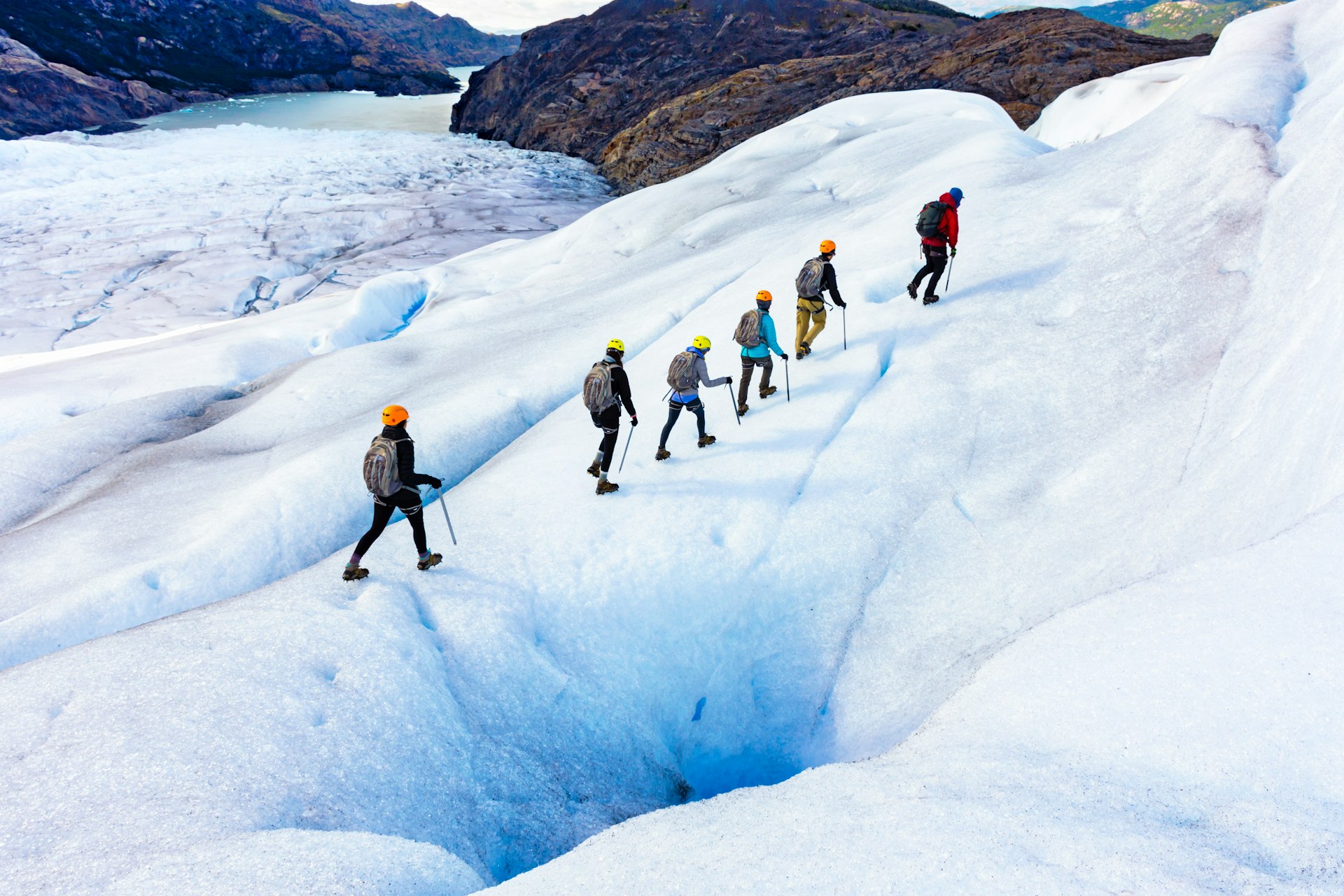
The "Circuit", Torres del Paine National Park (Chile)
Best long-distance trek
68 miles (110km) loop, 6–10 days, moderate
If you have more time to spare, hike the loop-shaped Circuit, the longest trek in Torres del Paine, trekked in a clockwise direction. Incorporating the "W", this spectacular loop gives you unique views of the backs of Los Cuernos and Las Torres – the park’s two mountain ranges – from remote back country. The terrain is never boring, as you climb partially-forested hills en route from the Serón campsite to the Dickson campsite and refugio , enjoying views of Lake Paine and Lake Dickson along the way, and taking boardwalks across boggy sections. This first half of the hike is where you’re most likely to come face to face with one of the park’s many mountain lions.
From Refugio Dickson, you enter dense southern forest with its thickets of giant wild rhubarb and ferns, with glimpses of waterfalls through the trees. The highest and most challenging part of the trek is the weather-dependent crossing of the John Gardner Pass (4002ft/1220m) between the Los Perros Campsite and Refugio Grey. Once you reach the top, the Glacier Grey icefield opens up below you like a vast, frozen river. As with the "W", you can either camp all the way, or go from refugio to refugio .
Los Alerces Trail, Parque Nacional Pumalín Douglas R. Tompkins (Chile)
Best easy hike
0.5 mile (700m) loop, 30 minutes, easy
Alerce trees are the giants of Patagonia. Growing up to 148ft (45m) in height and living for up to 3000 years, and used for making southern Chile’s unique shingled roof tiles, they were cut down almost to extinction by colonists in the late 19th and early 20th centuries and now have protected status. Off the Carretera Austral, some 7.7 miles (12.5km) south of the Caleta Gonzalo car ferry landing, this wonderful interpretive trail passes through a particularly impressive grove of these millennia-old skyscrapers of the forest.

Laguna Torre, Parque Nacional Los Glaciares (Argentina)
Best hike with icebergs and glaciers
13.6 miles (22km) roundtrip, 6–8 hours, moderate
Another excellent day hike from El Chaltén, this trail takes you from the south of town through the Fitz Roy river valley. Passing a small hydroelectric station, you climb through lenga and ñire woods to reach the Mirador Laguna Torre, with views of glaciers beneath the Adela mountain range, Cerro Torre, Mt Fitz Roy and the granite "needles" popular with rock climbers. Crossing an alluvial plain bisected by the glacial Fitz Roy river, you pass the partially sheltered De Agostini campsite before skirting the iceberg-filled Laguna Torre to reach Mirador Maestri, overlooking the Grande glacier.
Laguna de Los Témpanos, Parque Nacional Queulat (Chile)
Best hike in Parque Nacional Queulat
1.2 miles (2km) return, 1 hour, easy
If you do just one hike in Parque Nacional Queulat , off Chile’s Carretera Austral in northern Patagonia, make it this one. From the main car park, after crossing the hanging bridge high above the raging Ventisquero river, you may have to brave the perpetual rain. Expect to beslapped in the face with moisture-laden ferns as you make your way through dense forest and damp undergrowth along this straightforward trail to a splendid glacial lagoon – but it’s well worth it. From the banks of the lagoon, you get uninterrupted views of the Ventisquero Colgante – a hanging glacier across the lagoon, filled with car-sized chunks of calved ice. The frequently inclement weather, and the park’s remoteness, means you’re likely to have it all to yourself.
Volcan Chaitén Crater Trail, Parque Nacional Pumalín Douglas R. Tompkins (Chile)
Best all-encompassing view
2.7 miles (4.4km) round trip, 3 hours, moderate
In 2008, the eponymous volcano in northern Patagonia staged a surprise eruption and buried half the town of Chaitén under mud and ash. This relatively steep five-hour round-trip trek starts near Puente Los Gigos, off the Carretera Austral, north of the now-rebuilt town. Following the eruption path of the volcano, the trail gets progressively more barren the higher you get. Your reward at the top is the all-encompassing view of the still-smoking crater and the surrounding forest.
Dientes de Navarino Circuit, Navarino Island (Chile)
Best demanding trek
33.2 mile (53.5km) loop, 4–5 days, difficult
On Chile’s southernmost permanently inhabited territory (across the Beagle Channel from Tierra del Fuego), this demanding trail loops around the jagged pinnacles of the Dientes de Navarino mountain range. Requiring camping wild and excellent navigation skills, it’s best done in a clockwise direction with at least one other companion. The trail cuts across bare stony plateaux, skirts glacial lakes, traverses boggy lowlands, and crosses exposed mountain passes, with highlights including expansive views of the Beagle Channel from Cerro Bandera and Paso Virginia (near the beginning and end of the trek, respectively). Watch your footing on the steep, rapid descent from the latter pass.
Lago del Desierto – Chile trail (Argentina/Chile)
Best hike that crosses an international border
12.4 miles (20km) one way, 6–8 hours, moderate
In recent years, this cross-border trail connecting tiny El Chaltén in southern Argentina to Chile’s equally tiny Villa O’Higgins has gained in popularity with adventurous hikers (and cyclists). Best done from Argentina to Chile (as that avoids a relentless uphill slog), it involves taking a boat across the pristine Lago del Desierto, some 23 miles (37km) north of El Chaltén, getting stamped out at the Argentine border post, then trekking through hilly, dense woodland until you reach the sign welcoming you to Chile, where the narrow trail becomes a broad, forest-fringed gravel road. It then winds its way down to Lago O’Higgins, to the tiny border post of Candelario Mancilla. From here, you have to catch another ferry across Lake O’Higgins/San Martin. During high season, when ferries across both lakes are more frequent, you can time the hike so that it’s doable in a day; otherwise you may have to camp at one or both border posts.
Avilés Trail, Parque Nacional Patagonia (Chile)
Best hike for camping wild
29 miles (47km) one way, 3–4 days, difficult
Connecting the eponymous forest lake in the Reserva Nacional Lago Jeinimeni (accessed from Chile Chico) with the Casa Piedra campsite in the scenic Avilés Valley in Parque Nacional Patagonia further south, this is a serious off-the-beaten-track endeavor that requires organizing transfers to and from the trailheads in advance and ample wilderness trekking experience. While the terrain is only moderately demanding, the trail through the valley is rudimentary and minimally marked, there are multiple river crossings and you have to camp wild, bringing all your supplies with you.
Cabo Froward (Chile)
Most remote
45.3 miles (73km) round trip, 4 days, difficult
The goal of this adventurous hike is to reach Cape Froward – the southernmost mainland point on the continent of South America. Starting at the trailhead some 56 miles (90km) south of Punta Arenas , the trail mostly hugs the coast, meandering along wind-battered cliffs, traversing boggy undergrowth, and passing the San Isidro lighthouse. Unless you’re an experienced wayfarer, it’s best to join a guided hike with Erratic Rock from Puerto Natales , as the trek involves fording narrow, deep rivers at low tide and camping wild. The trail isn’t well-marked in places.
You might also like: Chile's best hikes and treks through extraordinary landscapes The best hikes in Argentina: from ice fields to rainforest trails I went on a solo trip to Patagonia (and I loved it)
This article was first published Apr 1, 2014 and updated Nov 16, 2021.
Explore related stories

Jan 8, 2024 • 11 min read
From Andean treks to whale watching off Patagonia, here are the top things to do in Argentina.

Feb 8, 2023 • 4 min read
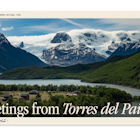
Feb 7, 2023 • 5 min read
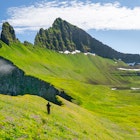
Dec 6, 2022 • 10 min read
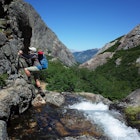
Nov 28, 2022 • 6 min read
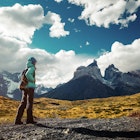
Oct 5, 2022 • 6 min read
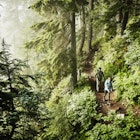
Jul 29, 2022 • 15 min read

Dec 13, 2021 • 11 min read
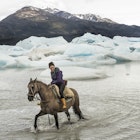
Dec 3, 2021 • 10 min read
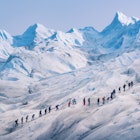
Oct 28, 2021 • 6 min read
Patagonia Itineraries for One Week to One Month
08/31/2019 by Kristin Addis 98 Comments
So you want to visit Patagonia, but have a limited amount of time to work with? No problem, because there’s still a way to see the highlights even in limited time.
I traveled through Patagonia from February through March and took it slowly, trying to explore as much of the region as possible while working simultaneously. Some people I met had even longer in Patagonia than I did, but most were on shorter trips and had to pick and choose what they saw.
That got me thinking about what I would have prioritized had I been working with less time, and with that in mind, I put together three different Patagonia itineraries for those with one week, two weeks, or one month to travel with.
(Note: If you have more time and want to retrace my journey, start with the archives or Bariloche in the Argentina guide and follow the chronological blog posts, all of which have directions and advice.)
This information is for those who want to self-guide their own tour of Patagonia, since I’m all about independent travel and take tours only when they offer a glimpse into something I can’t access or understand as well on my own.
As Patagonia is all about the outdoors, these itineraries prioritize hiking and camping, two must-dos in Patagonia. Before you go, be sure to read my camping and packing guides before you go as well, because certain weather-resistant equipment is essential when in Patagonia, even during their summer!
One week isn’t a ton of time in Patagonia, but if you maximize it right, you can hit many of the highlights.
This itinerary is packed to the brim and will have you constantly on the move. If you want to take it a bit easier, I have some alternative suggestions at the bottom of the itinerary to help you pick and choose how much you want to see and move around. If you can swing it, though, don’t miss Torres del Paine National Park!
Here’s a map with all of the important stops for one week in Patagonia:
Fly into El Calafate from Buenos Aires (or do this itinerary in the reverse and fly into Punta Arenas if you’re already in Chile).
Take 3-hour shuttle directly to El Chalten ( order ahead of time if high season). A ticket should cost you AR $600. Here are some of the bus companies available and their schedule:
- Chalten Travel everyday at 8AM, 1PM, and 6PM
- CAL-TUR everyday at 8AM, 1PM, and 6PM
- Tasqa everyday at 7:30AM, and odd days at 6PM
(Click for places to stay in El Chalten ).
Day 2:
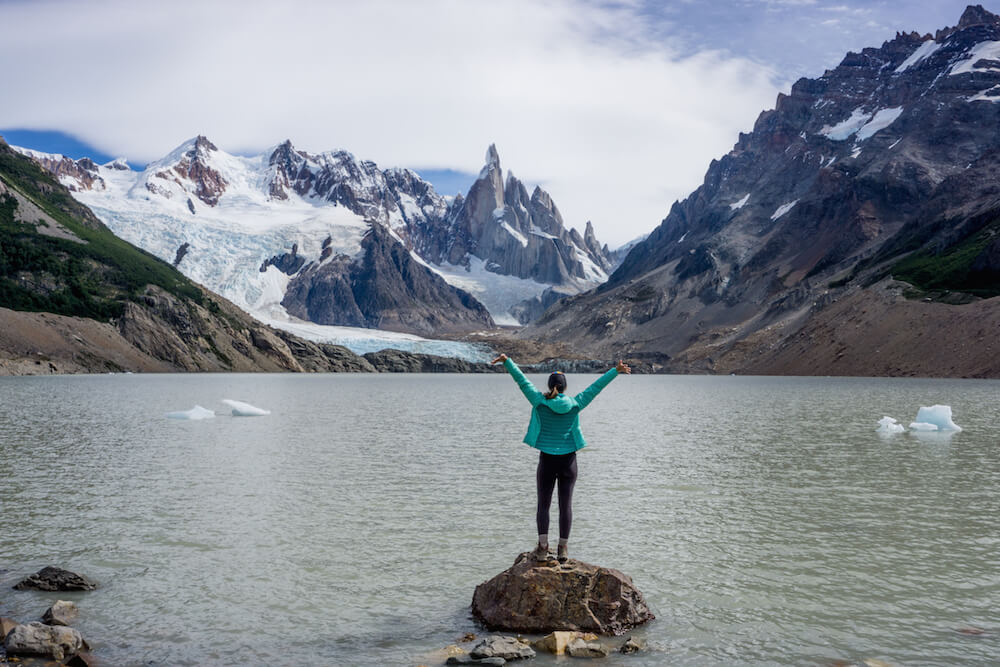
Hike to the Cerro Torre – an 18km, easy hike to one of the most dazzling rock formations in the park.
Dinner at B&B burgers or order Cordero Patagonico (local lamb on a spit), dessert at Domo Blanco ice cream.
Day 3:
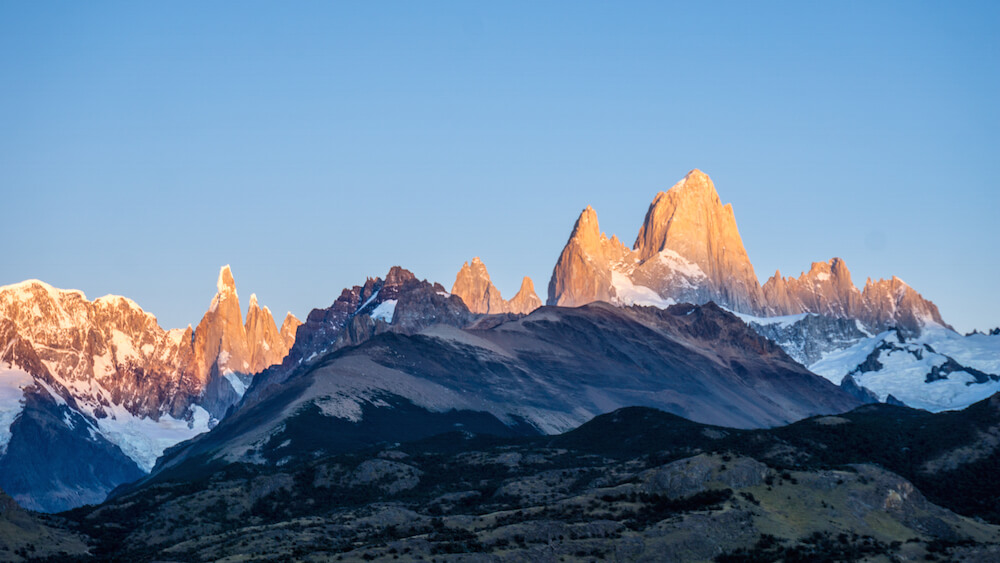
Wake up before sunrise and hike to the Condor Lookout, 20-minute hike.
Hike from town to the Fitz Roy, dinner in town.
Day 4:
Early morning bus to El Calafate. Again, a ticket costs AR $600, and here are the bus companies available and their schedule:
- Chalten Travel everyday at 7:30AM, 1PM, and 6PM
- Tasqa everyday at 6PM
( Click here for places to stay in El Calafate ).
Buy onward ticket to Puerto Natales. Bus ticket should costs about AR $1100 – AR $1300
Check in and visit the Perito Moreno Glacier. If in a duo or group, it’s cheaper and more convenient to order a taxi for a flat fee. Ask your guesthouse to call for you. Otherwise, busses depart from the bus terminal in town from 8am to 4pm.
Early AM bus to Puerto Natales (the journey takes about 5 hours). Book bus to Torres del Paine National Park at the bus terminal following AM (book ahead if high season).
( Click for where to stay in Puerto Natales )
Day 6:
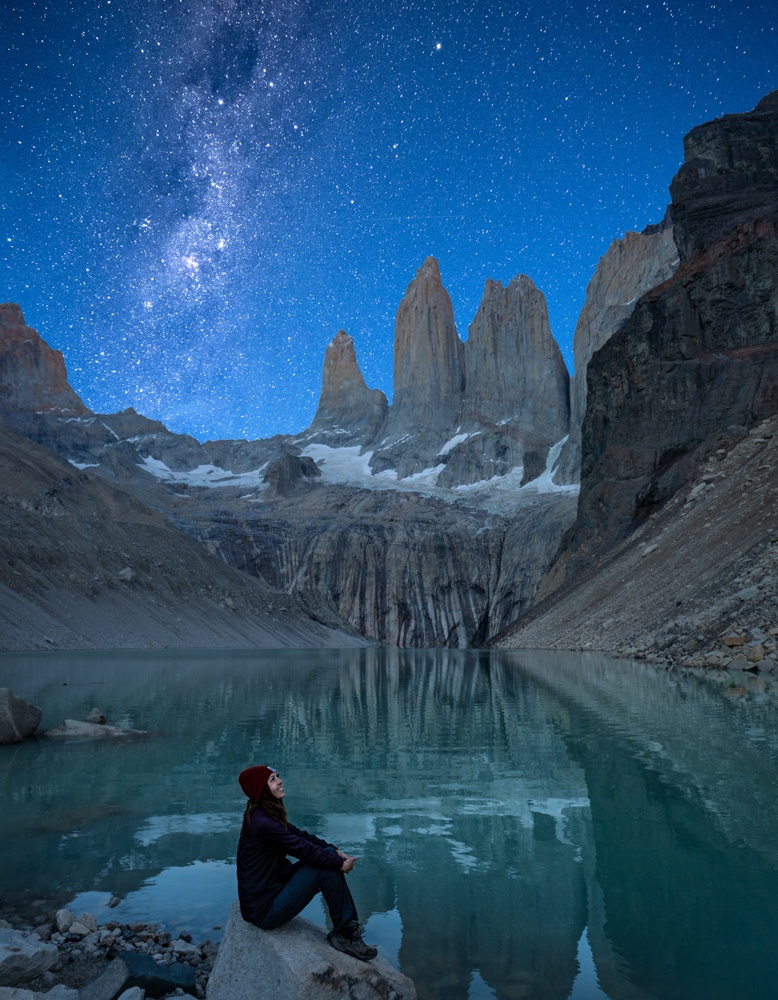
Early AM bus to Torres del Paine National Park. The journey should take less than 2 hours. Alight at Hotel Las Torres² and hike up to the Torres. Hike back down to take the bus back to Puerto Natales in the afternoon (note: this is a challenging hike to do in one day, consider taking a horse partway if needed).
Full Paine tour departing and returning to Puerto Natales. Bus next AM back to El Calafate and fly out from there, keeping in mind that the border crossing will take time.
*Optional changes:
- Stay in El Calafate and take a day tour to Torres del Paine to see the highlights without traveling onward to Puerto Natales. Spend more time in El Chalten to make it less rushed.
- Stay at the Hotel Las Torres , which includes tours (like the Full Paine and horse transport partway up to the Torres in Torres del Paine) and transport to and from El Calafate when you choose the all-inclusive package.

First Name:
Here’s a map with all of the important stops for two weeks in Patagonia:
Fly into El Calafate from Buenos Aires (or do this itinerary in the reverse and fly into Punta Arenas if you’re already in Chile).
Take 3-hour shuttle directly to El Chalten ( order ahead of time if high season). A ticket should cost you AR $600. Here are some of the bus companies available and their schedule:
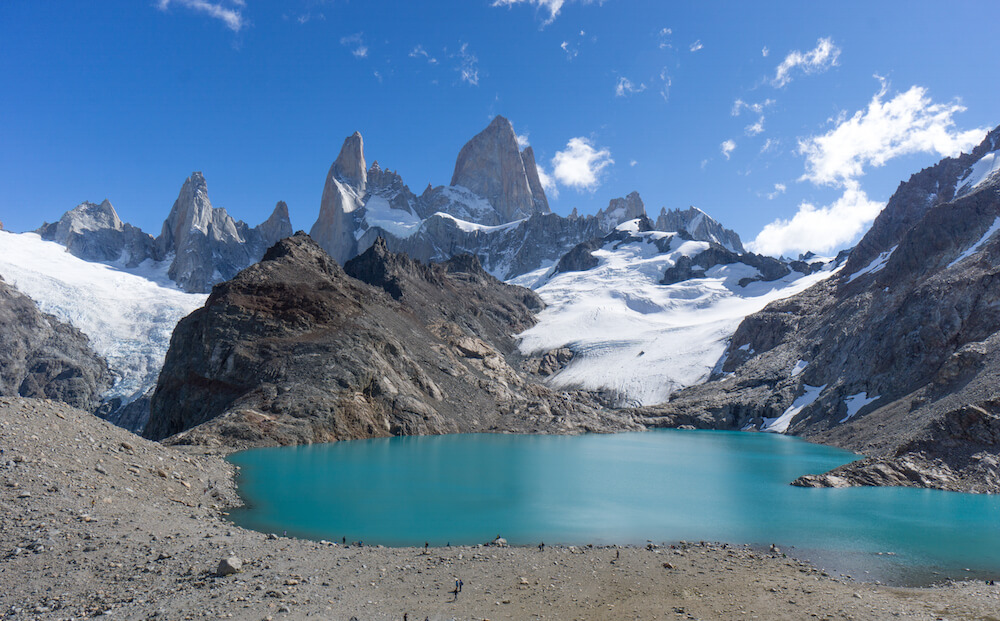
Rent in the town or carry your own camping gear up to the base of the Fitz Roy and explore the surroundings. Spend the night camping.
Hike to the base of the Fitz Roy, come back down and pack up your tent, and then hike to the Cerro Torre. Either camp at the base of the Cerro Torre or walk back into town (it’ll be a long day!) for the night.
If back in town, wake up before the sun rises and check out the Condor Lookout for the sunrise on the mountains, the famed rocks from the Patagonia brand label.
Bus in the afternoon to El Calafate. Again, a ticket costs AR $600, and here are the bus companies available and their schedule:
( Click here for places to stay in El Calafate ). Buy onward ticket to Puerto Natales.
Day 5:
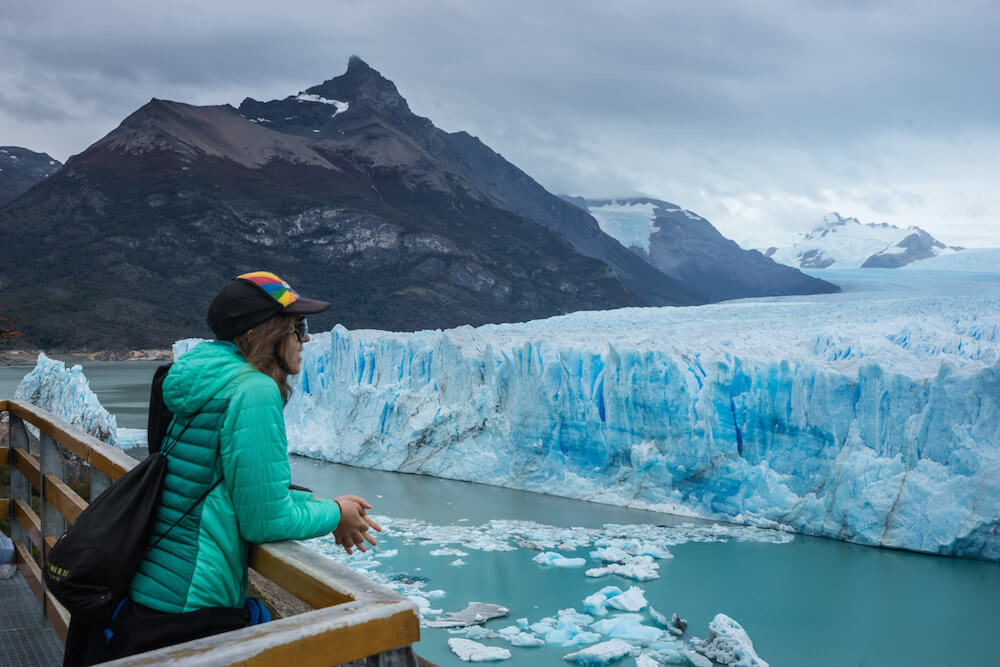
Visit the Perito Moreno Glacier. If in a duo or group, it’s cheaper and more convenient to order a taxi for a flat fee. Ask your guesthouse to call for you. Otherwise, busses depart from the bus terminal in town from 8am to 4pm.
Early AM bus to Puerto Natales (the journey takes about 5 hours). Use the time in the afternoon to rent camping gear if needed, stock up on food, and get ready to hike the W trek, a 5-day trek in Torres del Paine National Park ( Everything you need to know to prepare is listed here ). Purchase bus tickets from the bus terminal ( or online ) for the first bus out the following morning.
Days 7-12:
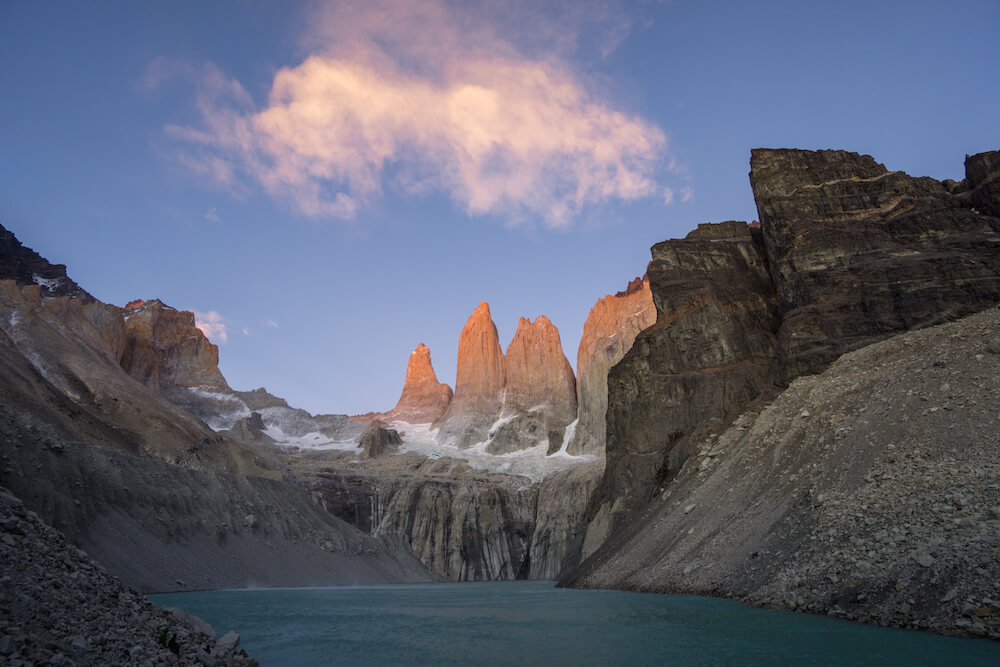
Take the bus from Puerto Natales to Torres del Paine National Park in the morning (bus departs from 7AM to 11:30AM, and journey should take less than 2 hours). Trek the W in Torres del Paine, including Glacier Grey, the French Valley, and the Torres. When finished on day 5, take the bus back into Puerto Natales.
Take a bus to Punta Arenas and visit the Penguins in the afternoon or early the next morning. Fly out of Punta Arenas to Santiago.
- If you want to do the full circuit in Torres del Paine, which is an excellent trek and a great choice, skip the penguins and shave off a day or two in one of the other spots. It will take about 8 days to hike.
You have a whole month in Patagonia? Applause! This is enough time to do some of the treks that others don’t often do who are on tighter schedules and want to see the highlights. The lesser-known places in Patagonia are some of the most magical, so with that in mind, this itinerary prioritizes the lesser-known areas along with the more popular ones.
Note: This can be just as easily done in the reverse.
Days 1-4:
More Active: Fly into Bariloche, Argentina, and pick an overnight hike. Two enjoyable ones I tried were the Cerro Tronador and Refugio Frey.
( Click here for great places to stay in Bariloche ).
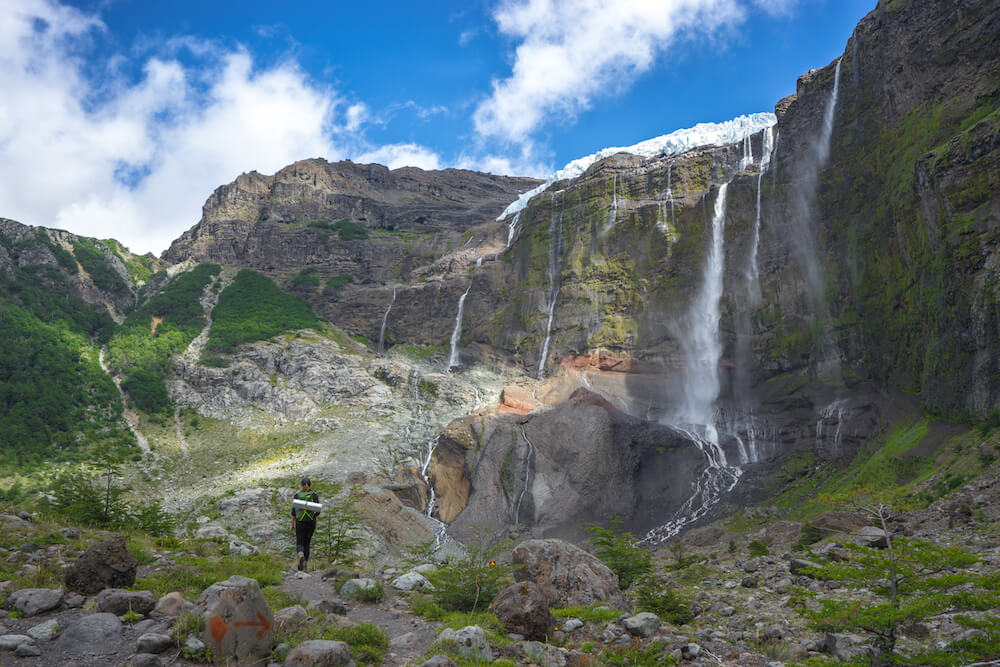
Less Active: Take the bus from town and do a shorter hike to the Cerro Campanario and drive the Route of the 7 Lakes.
Check out my Bariloche guide for the specifics on all of the hikes, how to navigate the area, and where to stay and what to eat.
This is where the path can change significantly from the usual highlights which are in both of the one and two-week itineraries, or go for something different. Take a look at the above to see what the usual popular suspects (and rightfully so!) and decide if they deserve a lot of time, because the alternative is a lot of parks mostly locals visit and know about, and it’s pretty darn cool.
Travel down the Carretera Austral, South America’s most remote road, via private rental car (fastest), hitchhiking , or busses (which are infrequent and ever-changing, so leave a time cushion when using this method). It’s also possible to bicycle, but this would most likely take up the entire month.
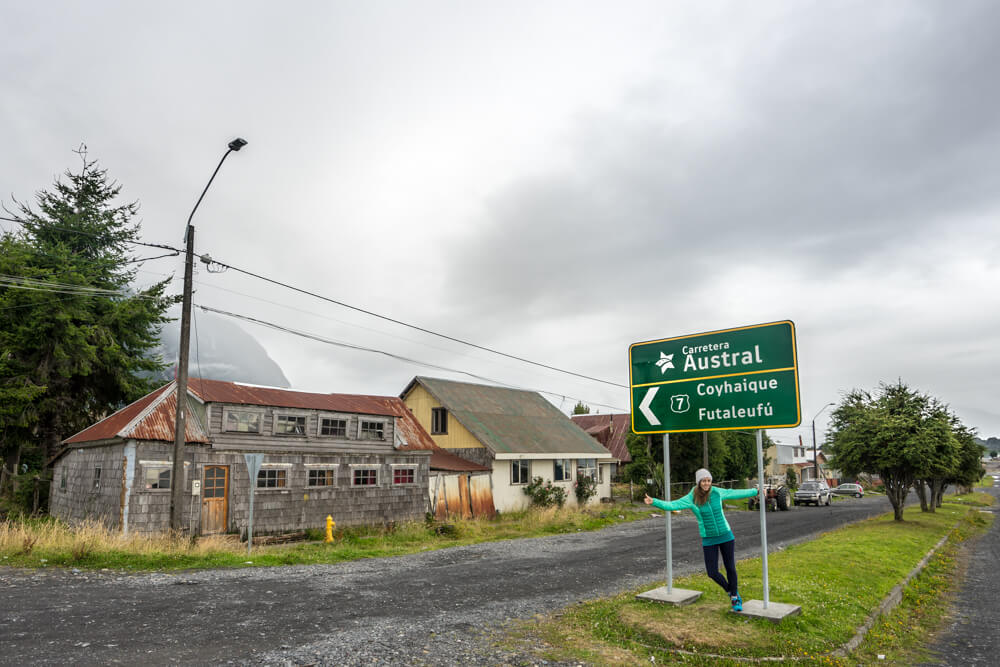
Sights (Click the links for photos and info on each):
- Puyuhuapi to see the Queulat hanging glacier
- Villa Cerro Castillo to do the day hike
- Puerto Rio Tranquilo for glacier trekking and the amazing Marble Caves
- Villa O’Higgins for the boat ride past the O’Higgins Glacier and over to Argentina
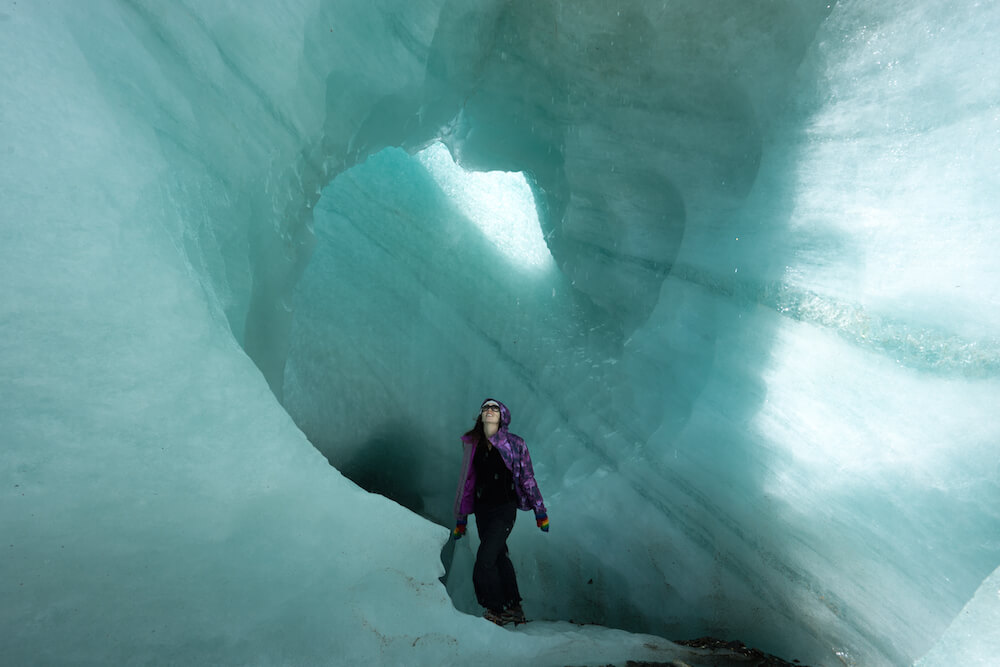
Days 16-18:
Walk from Chile into Argentina.
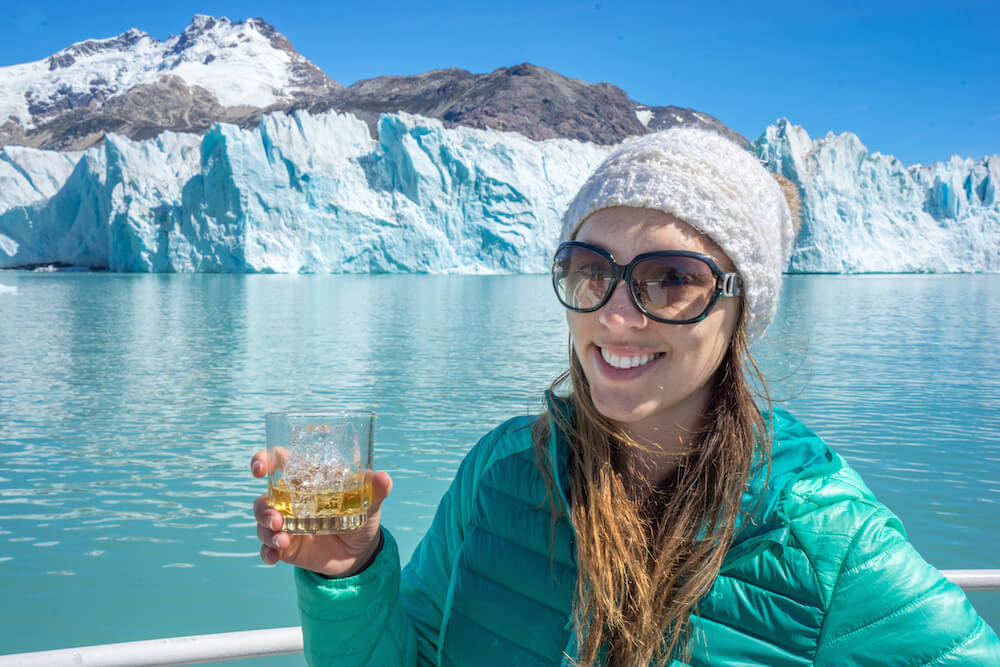
It’s a total of 22km and you’ll be in no-man’s land for most of it. One of the coolest trails in Patagonia. (Note: You can often hire horses to carry the bags, but it’s not possible to book ahead. In case you have to carry all of your stuff, pack light! Suggestions here. )
Days 19-21:
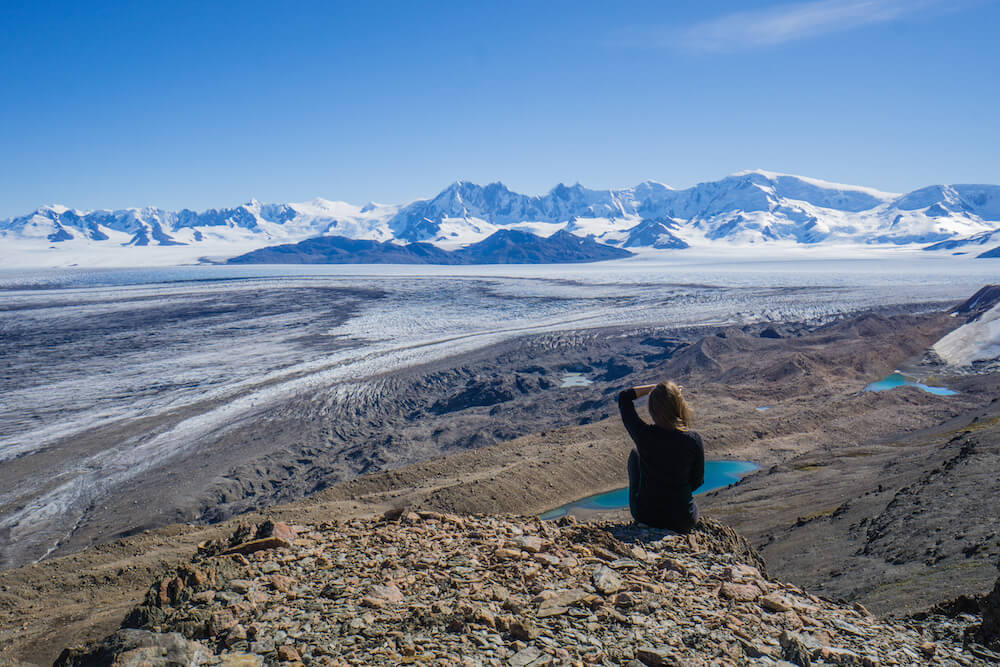
Do day hikes around El Chalten to the Fitz Roy and Cerro Torre , or if you want a challenge and to devote more time to this, check out the Huemul Circuit . While it’s one of the toughest hikes in the area, it’s also one of the least-trekked and most impressive with sweeping views of the Southern Patagonian Ice Field.
Days 22-30:
Depending on how much time you have left, make your way through El Calafate to Puerto Natales and gear up for Torres del Paine .
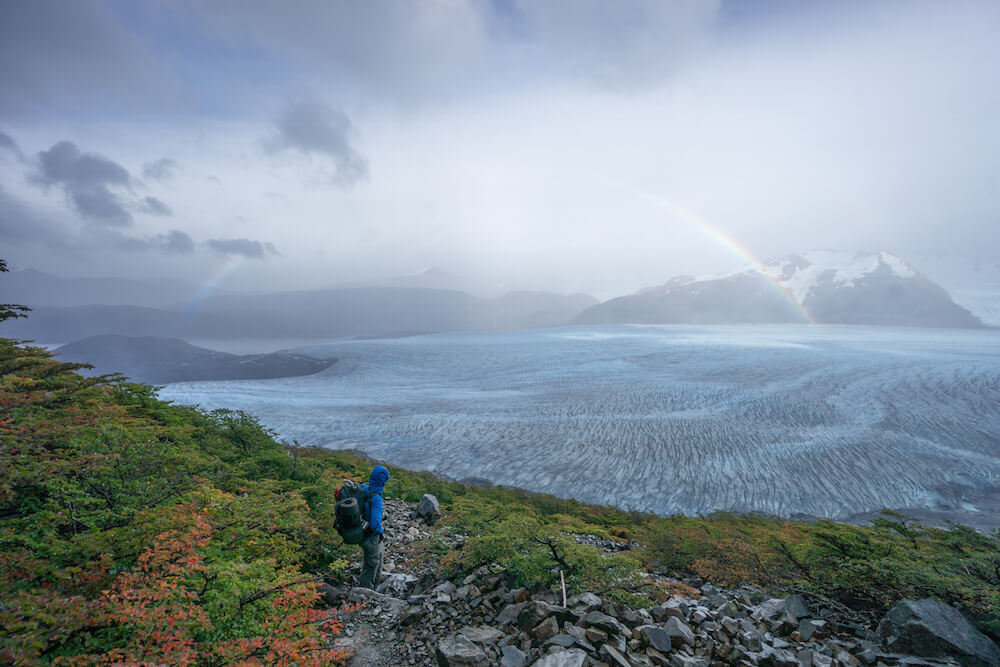
Choose to do the full O circuit or the W, depending on time.
Regardless of the amount of time you have or how much of a hiker you are, the good news is Patagonia is so full of incredible things to see, you can’t really make a bad choice in regards to what to see.
You can, however, make a bad choice regarding prep, so make sure you bring the right gear and clothing along with you!
Patagonia is a beautiful and rugged place. Enjoy every moment of it!
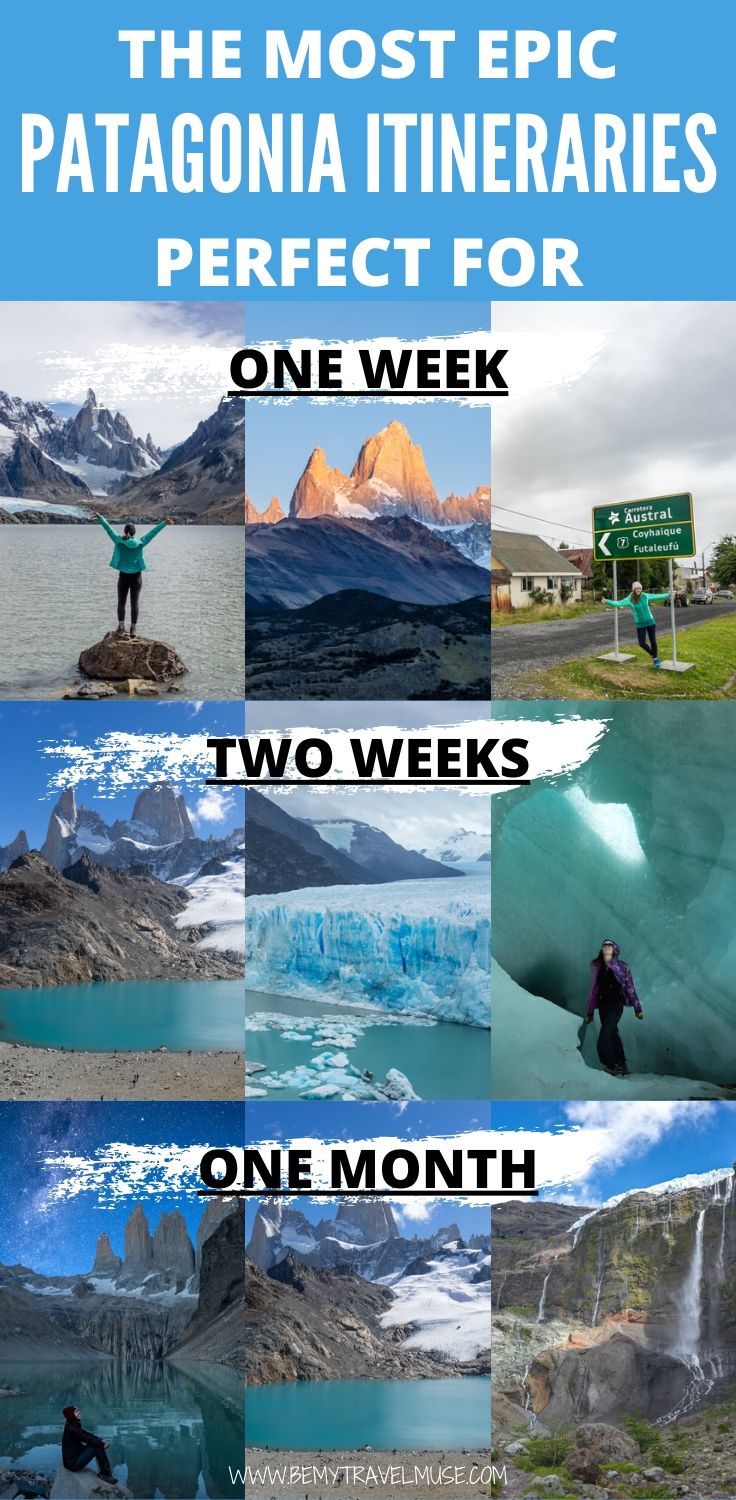
About Kristin Addis
Kristin Addis is the founder and CEO of Be My Travel Muse, a resource for female travelers all around the world since 2012. She's traveled solo to over 65 countries and has brought over 150 women on her all-female adventure tours from Botswana to the Alaskan tundra.
Leave a Reply Cancel reply
Your email address will not be published. Required fields are marked *
Save my name, email, and website in this browser for the next time I comment.
subscribe to our newsletter
This site uses Akismet to reduce spam. Learn how your comment data is processed .
08/31/2016 at 9:53 pm
Thank you so much for this post! Patagonia has been at the top of my bucket list for a long time, and I’ll admit I was a bit stymied on how to visit and what to see. You make the planning process a lot easier for me 😀
Crystal says
09/29/2016 at 11:21 am
Just booked my almost 3 week trip to Patagonia and a friend tipped me off to your blog – excellent info! One question though – everything else I’ve read regards Puerto Natales as the base camp of Torres del Paine, with Punta Arenas for penguin sightings. Yours seems to indicate the opposite. Why do you prefer Punta Arenas over Puerto Natales for the base camp? It seems like the bus to PA from El Calafate would be much father than to PN.
Kristin says
09/29/2016 at 12:18 pm
Wow you are totally and completely right! I never could get those two straight in my mind. I was confusing the two constantly (and still do, clearly). It’s kind of like when I look at a 24-hour clock and without fail I will read “15:35” as 5:35pm rather than 3:35pm. Ugh! Thanks so much for saying something and I’ve fixed it in the itinerary now!
09/30/2016 at 4:52 am
Thanks so much for letting me know! I was quite confused haha 🙂
Cristina says
10/01/2016 at 8:42 pm
If you are going hiking to Torres del Paine I would recommed you to first go to Punta Arenas to buy the food its a 10 minutes drive from the airport. Puerto Natales its really expensive compare with Punta Arenas, from there you can take a bus to Puerto Natales and buy Argentinian pesos believe me you dont want to use an ATM in Argentina they charge you around 10 dollars for use in addition of what your bank charge you
10/06/2016 at 9:43 am
Or just get Charles Schwab and they will refund the ATM fees. How current is your info? The black market for Argentinian pesos is dead now
10/05/2016 at 7:22 pm
Hi Kristin,
My wife and I are trying to plan a trip using your 1 week schedule as a guideline because we will be doing something like 7-10 days. For the one week trip, would there be camping or does this plan on staying in hostels or hotels?
We want to do some camping but I was not sure if it was part of the plan or if the plan is more stay in a city and do hikes from the base.
Thanks, Matt
P.S. My wife loves your site.
10/05/2016 at 7:24 pm
Thought I should add that I like your site too.
10/06/2016 at 9:28 am
You can camp if you want to! These aren’t cities, per se. They are tiny towns and all have campsites. You can also do overnights out on the trails – there are campsites all over the ones in El Chalten, for example.
10/06/2016 at 8:56 pm
Thank you for the response. I took a little bit of the 1 week and 2 week itinerary notes and came up with a plan in el chalten for some camping on trails and some staying in town. It’s good to know that camping close to town is also an option.
I really liked the pictures of the glacier hike you did in chile but don’t think we can make it there in our timeline. Did you hear much about the glacier tours for the glacier by El Calafate?
10/07/2016 at 11:08 am
I also went to Perito Moreno in El Calafate and you don’t need to take a tour unless you want to. You can bus in, then hire a taxi for a fixed rate who will take you and wait for you then bring you back to town when you’re done. It’s a better option as long as there are 2 or more of you. It was super impressive!
10/29/2016 at 7:20 pm
Hi Kristin!
Thanks for the great post! I am a female solo traveler and will be heading to Argentina in January. I was originally planning on 19-20 days in the Patagonia, but am considering shifting some things around to only spend 16 there. A friend of mine recommended spending a weekend in Punta Del Este to get some beach time in (should be fun over NYE). I will be in Buenos Aires studying Spanish for the month prior to going to the Patagonia, so I have some flexibility on when I go to the Falls. I will have everything I need to hike before flying south so I won’t need to spend a day preparing before hand. However, if you think this schedule will be too rushed, I could go to Iguazu earlier in trip and possibly skip punta del este, which would give me several more days in the Patagonia. What do you think?
Day 1: Fly Calafate (5am flight), bus Torre Del Paine Day 2 – 9: O circuit Day 10: Relax Day 11: Bus Calafate Day 12: Big Ice Trek Day 13: Early Bus to El Chalten, day hike Day 14: Day hike Day 15: Day hike Day 16: Bus Calafate, Fly Iguazu Day 17: Falls- Brazil Day 18: Falls Day 19: Falls Day 20: Fly BA
Also, I plan to camp the whole time in the Patagonia except for two days at the end of the O circuit, in which I’ll stay in a hotel. Do I need to reserve a spot at a free campsite if I am carrying all of my gear?
Thank you!! -Ash
11/01/2016 at 2:32 pm
Give the O a solid 8 days, and that’s if you’re fit. Otherwise that looks pretty good to me! Yes if this is in January definitely book ahead of time as it will fill up.
Graham Neray says
11/25/2016 at 4:47 pm
My wife and I are going to Patagonia for our honeymoon in the last 2 weeks of December. We are using your 2-week itinerary as a rough guide: flying into El Calafate, then straight to El Chalten for 2 days, then back to El Calafate for 1.5 days, then to Puerto Natales as a launching point to Torres del Paine to hike the W trek for 5 days. After that, we have about 5 days left and we’re debating what to do: 1. Go up north to Bariloche and/or Puerto Rio Tranquilo; or 2. Go down south to Ushuaia, maybe stop in Punta Arenas on the way.
After we do (1) or (2) above, we need to get back to El Calafate, where we fly out of in order to head home.
We are more into hiking vs. tourist attractions; being on our own vs. being with the crowd. It’s a bit hard to tell how doable it is to get from Puerto Natales to either of those destinations. Which do you think we should do – (1) or (2)? Are both feasible in terms of travel? If so, how would you recommend we get from Puerto Natales to (1)/(2)?
Thanks in advance for you advice!
11/26/2016 at 12:07 pm
I would give El Chalten more time instead of trying to book it to one of the other spots. Puerto Rio Tranquilo can take a while, but you can fly into and out of Bariloche. Why do you need to go back to El Calafate from there? I assume you’re flying in and out of Buenos Aires?
11/30/2016 at 3:02 pm
12/02/2016 at 8:52 pm
This is so helpful! I am going to Chile with my boyfriend in March. We want to send 4-6 days camping or hiking in the patagonias. We will becoming from Santiago and flying into Punta Arenas. Would you suggest we spend the whole time in Torres del Paine hiking and camping here or try to make it to El Chaltén as well. my concern is it will be hard to get from Chalten back to santiago the flights are expansive and 5 hours. Thanks for your help
12/04/2016 at 9:05 pm
I’d pick one spot with only a few days or you’ll be rushed and stressed.
12/04/2016 at 4:11 pm
Thanks for this, Kristin! I have fourteen days with two travel days and am struggling to choose between northern and southern Patagonia. Which do you think? Or is there a way to see some of both in that time? Kelly
12/04/2016 at 9:04 pm
You could do Bariloche for a bit then fly down to El Calafate. I think down south is more impressive.
01/03/2017 at 7:45 am
so helpful thank you! How much money would you suggest budgeting for the one-week itinerary (buses, meals, lodging, any entrance fees)?
01/03/2017 at 10:38 am
Here’s my breakdown: https://www.bemytravelmuse.com/patagonia-trip-cost/
Kristen says
01/06/2017 at 6:57 am
Thank you for posting such helpful information! We’ll be spending 7 nights (6 full days) between El Calafate and El Chalten. We’re planning to just do a day tour of Torres del Paine from El Calafate as we won’t have enough time to do a long hike. But, would you recommend we spend a night at Hotel Las Torres to give us another day in the park?
We are also debating if we should spend more time in El Calafate vs. El Chalten. Do you prefer one over the other?
Thanks again!
01/09/2017 at 12:29 pm
Definitely prefer El Chalten over El Calafate, by far! I think another day in the park is a good idea too if you can do it. It’s so beautiful.
02/17/2017 at 1:26 am
You might have more success in Chile when you’re getting ready to do the Torres del Paine circuit. The backpacker accommodation are used to keeping bags there and didn’t charge me to do so.
03/01/2017 at 10:59 pm
I didn’t do anything but the glacier and didn’t love the town either. It’s really touristy!
There could be hikes I wasn’t aware of, though. If you find some please let me know!
03/02/2017 at 8:04 am
Great site! Thanks for all the information…
I may have missed it in the comments or actual post but, Do you have a general budget for the iteneraries?
03/02/2017 at 10:30 am
Got it here: https://www.bemytravelmuse.com/patagonia-trip-cost/
10/19/2017 at 5:48 am
I’ve a very short period of time on this trip. From 29th oct to 1st nov. I’m thinking to fly to Punta Arenas. 1st day do day tour trekking to the base Torres,
2nd day, Will do full day (easy hike) tour Torres Del Paine.
Do you think we re really need to get a tour for my second day? Both tour exclude the park entrance fee. Do you think I need to pay twice for both day or one time?
3rd day Will take a bus from Puerto Natales to El Calafate.
4th day May I know if I’m going to the Perito Moreno by myself, NO tour, how much is the boat ride? I heard it’s a must and impressive.
10/19/2017 at 2:50 pm
1st day looks good, the second day I would do a full paine bus tour to see the beautiful and iconic stuff in the park. Most of it would require multiple days to trek to otherwise. They usually return you to town as well. I don’t know about the park entrance fee. I’d ask the tour company that you book with.
I also don’t know how much the boat tour is, I didn’t do one.
Danilo says
10/27/2017 at 1:48 am
You only pay once to Torres del Paine National Park Fees, when you leave the park the first day saves the ticket and will serve you for the next day
04/05/2017 at 9:11 pm
We are a couple 61 and 58 who travel with our 20 year old son. We are big hikers but thinking would prefer not to camp and carry all the needed gear. (Backpack camping gets less appealing as we get older.) Staying in hostels/private rooms with an occasional nice hotel. Say 80% hiking and 20% culture/small town tourism. We would rent a car when it makes sense to be time efficient. No hitch hiking, bus is fine if it goes where/when we want. Thinking 3 weeks including travel time. Probably looking for a little more granular trip planning advice than you give away on your blog (but not to the booking level). Suggestions on travel reading…Loved reading about your trip and watching the video’s.
04/08/2017 at 11:17 am
Hey Scott, I wrote everything about my trip and everything I know on here! I gave it all away! 🙂 Since I didn’t rent a car I don’t have that info but it is a bit expensive, I do know that, but probably worth it for your trip. Where you go and how you spend that time will depend on how long you want to devote to each place and that’s something you’d have to decide for yourself, but El Chalten seems like a perfect fit given it has plenty of day hikes. You might like Steve’s guidebooks as well: http://amzn.to/2oNLn7R , http://amzn.to/2nrWFyf
05/16/2017 at 1:34 am
Hi, loved your article huge help for planning my trip! Just wondering where your opening photo is from? Thanks
05/16/2017 at 2:41 pm
The Huemul Circuit: https://www.bemytravelmuse.com/huemul-circuit-argentina/
06/10/2017 at 2:33 am
Thanks for asking. Torre just means ‘tower’ so it’s a name that a few rock formations down there have. However thank you for calling my attention to it because I think that only the one in Argentina has a ‘cerro’ in front of it. These names are endlessly confusing for me! Made a change in the post now to reflect that.
The reason why I suggest flying into Puerto Natales is the airport in Punta Arenas is much smaller and probably super expensive if it’s even doing flights atm since they only do in high season, but check with SKY airlines to make sure. The demand is high to get to Torres del Paine lately so maybe they’re doing more flights.
El Calafate is just the most logical place to fly into because it’s in the middle, between Torres del Paine and El Chalten, plus you have the perito moreno glacier there and lots of day trips to Torres del Paine too. That said, you will pay a lot more to fly from Santiago into El Chalten because flights within the country are reasonable but as soon as you cross a border they tend to triple. Can you fly into Buenos Aires from Canada instead? It’s also a super cool city!
Connie says
06/12/2017 at 10:10 am
Hi Kristen:
Thank you so much for you detailed reply. Yes Buenos Aires is in my plan but it turns out flying to Santiago from Canada is much cheaper than flying to Buenos Aires. That’s why I thought I can see the Patagonia on the Chile side before heading to Buenos Aires. And yes the names are very confusing to me and thanks for clarifying. I guess you meant hiking in the Torres del Paine on Day 7 instead of hiking to the Cerro Torres? I have approx 3 weeks (more or less) for my trip to South America and here’s my tentative plan:
1) Fly into Santiago, stay there for 4-5 nights. 2) Fly to Buenos Aires, then fly El Calafate on the same day (is it possible?) 3) Stay in El Calafate overnight take the shuttle bus to El Chalten next AM. 4) Hike to the Cerro Torres next day 5) Condor Lookout next day 6) Day tour to the Torres del Paine 7) take a shuttle back to El Calafate next day and fly back to Buenos Aires on the same day (possible too?) 8) Stay in Buenos Aires for 4-5 nights 9) fly back to Santiago and then fly back to Canada
Is this a realistic plan? In a nutshell my plan is in about 3 weeks I would visit Santiago, El Chalten, and Buenos Aires. Santiago will be my base for flying in and out of South America. I’m just unsure if I should attempt the above itinerary or do Santiago –> Buenos Aires –> El Chalten instead. Would you mind sharing your 2 cents?
Many thanks again.
06/13/2017 at 12:22 am
Looks good! If you can psych yourself out enough to do Condor and Fitz Roy on the same day then do. I have no idea about the flights that just depends on what’s available. Have fun! Let us know how it goes for you.
06/13/2017 at 6:29 pm
HI Kristin:
Haha thanks for the tip about Condor and Fitz Roy! I’ll definitely keep that in mind if I’m not super tired from moving around. (I’m relatively fit but flying up and down and moving around is another story.) Will definitely keep you posted if I eventually make it there.
Thank you so much for all your posts – very helpful and reassuring for a fellow female traveller who loves to go solo. You’re definitely one of my fav travel bloggers.
10/09/2017 at 2:46 pm
Hi Kristin:
So I did make my trip happen and I’m leaving for South America soon! (Peru and Argentina – I gave up Chile because I caught a super cheap flight deal to Peru by fluke.)
I have a random question I hope it’s the right place to ask you here: I just bought Pacsafe bag protector, after reading your travel resources on your blog. In your experience, do airlines accept the protector for check-in backpacks?
Many thanks, Connie
Imogen says
07/26/2017 at 6:27 am
Have enjoyed reading your blog. I’m an Aussie solo female traveller planning a trip to Patagonia mid Nov – mid Dec. I’ll have a month.
I have a couple of questions:
– Were there lots of people on the route from O’Higgins, boat ride and hike to El Chalten? ie if I’m travelling solo will there be people to hike with? If I fly into Bariloche I’d be keen to take that route, but reading different posts some people say it’s v isolated, so I was just wondering what you think.
– I’m keen on the Huemul Circuit: would you recommend organising it with a guide/group rather than doing it solo? The river crossing with the harness and that steep drop look fun but not sure I want to do that on my own!
– Have you been down to Ushuaia? Would you recommend it? I was maybe thinking of flying into El Calafate and out of Ushuaia instead of exploring further north.
Thanks Imogen
07/26/2017 at 8:47 pm
Not that many from O’Higgins but it’s more of a dirt road than a treacherous hike and you might meet people at the farm or in town before you even go. I would not do the Huemul circuit solo but I wouldn’t do a guide either because I usually prefer to go at my own pace. I would look for people at hostels in town and see if they want to come 🙂 I have not been to Ushuaia sadly.
Anonymous says
07/28/2017 at 10:03 pm
Thanks Kirstin
Yeah, I think I’ll be fine. Reading more about the Carreterra Austral – I get the feeling I won’t be the only one doing the crossing 🙂
It’s good to see there are still places you can hitch-hike! My last hitch-hiking adventure was around Newfoundland in 2009. I had THE best time.
Just booked the trip – from Esquel to Ushuaia for a month. Very excited.
Cheers Imogen
Attila says
08/06/2017 at 7:00 am
Your site is pretty amazing. It gives me many ideas to plan our holiday. We are planning to do some trekking in Patagonia late November – early December (I hope not too cold) this year. We will try to do something like you wrote in your one-month-itinerary. It sounds amazing as we are relatively experienced trekkers and looking for remote areas to avoid the crowd but still don’t want to miss the typical Patagonian landscapes. I’m little bit worried about the costs, though. We will be on low budget because the flight from and back to Europe takes a lot of money.
We would really love to take this car trip on the Carretera Austral, but I think a car rental could make the whole trip too expensive. If we hitchhike or wait for busses it could take too long and there is a great risk that we have to skip some beautiful treks or we miss our flight back.
What do you suggest? Do you know any car rental companies that allow us to pick up and drop the car in different places? In which cities would you rent and return the car? I thought about Puerto Montt and O’Higgins. Do you know the approx. daily rental cost? Are there any other costs like tunnels or ferries between these cities?
After we dropped our car and we are already in Argentina: Which is the best way to travel between El Chaltén and El Calafate and how to get from there to Torres del Paine?
Thank you in advance! Attila
08/06/2017 at 7:05 pm
You’re right that it will be expensive to rent a car on the Carretera Austral, especially if you drop it off in a different location than you pick up. I don’t have any idea how much since I didn’t do it or where you can drop off but these are tiny towns so options are probably pretty limited. There are buses now and then but they aren’t daily and sometimes they are full when they pass by. Unfortunately that’s just how it is, though you can bypass the Carretera Austral and take a bus through Argentina down to El Chalten instead. The bus directions are noted in the itinerary for how to get from place to place, including TdP. When I didn’t hitchhike I took buses. Have fun!
Bhavna says
09/12/2017 at 8:00 pm
I am also a female solo traveler. Just started travelling solo couple years ago. I am planning to go for 2 week trip in Patagonia. I was wondering if it is possible to do multiple day hikes in Torres Del Paine from a hotel in that region. I am not a camp person so not planning to do O or W trek. Not planning to rent a car either. Are there buses from hotels that go to TDP park?
Thanks, Bhavna
09/12/2017 at 10:26 pm
In that case I’d suggest staying at a hotel within the park. The Hotel Las Torres is great. The hotels aren’t cheap, but otherwise, you’d kind of have to learn to be a camp person. It’s not so bad!
09/17/2017 at 4:22 am
Hello, I was planning to do Patagonia on my round the world trip- I’m a 25 year old solo traveller- however since it is going to be my first time there I don’t think I’ll be able to manage hiking or camping by myself? Any ideas on how to keep costs lower when travelling there? I’d like to have a guide for hikes:-\ I haven’t gone camping before and the idea of being left alone somewhere intimidates me. Tours even independent ones are crazy expensive – so if I follow the 2 week itinerary you’re mentioning above how easy i s it to find someone to hike with etc?
Thanks, Kate
09/17/2017 at 6:18 am
Honestly there were so many other people on the trails that I mention in the 2-week itinerary, you won’t be alone at all. I also made friends with plenty of people in town and during the hikes, which was a pleasant part of the journey! I was there with Steve, but I met a solo female traveler who had hitchhiked all the way down the Carretera Austral (mentioned in some of my other Patagonia posts and in this one in the longer itinerary) and I kept running into her, having meals with her, and camping with her. The trails are really obvious so I don’t personally believe a guide is necessary. You can always show up and see what you think!
RE Flores says
09/30/2017 at 2:29 pm
Kristen, how did you handle airline tickets from Buenos Aires to El Calafate? After I booked, I noticed some text about fares applying only for residents. Will I need to pay extra at the airport? Thanks!!!
10/01/2017 at 2:12 pm
I didn’t have any issues, personally, when I did the reverse.
mohit verma says
10/16/2017 at 2:50 am
On the off chance that you are going climbing to Torres del Paine I would recommend you to first go to Punta Arenas to purchase the nourishment its a 10 minutes drive from the airplane terminal. Puerto Natales its truly costly contrast and Punta Arenas, from that point you can take a transport to Puerto Natales and purchase Argentinian pesos trust me, you dont need to utilize an ATM in Argentina they charge you around 10 dollars for use moreover of what your bank charge you
Anne Weiss says
10/20/2017 at 7:51 pm
This is great information! We are considering a 1-2 week trip with our young adult daughters. Can you give me any sense of what kind of costs we could expect for these itineraries? Also is it possible to do it without any camping if we don’t want to haul a full pack? Thank you!!
10/21/2017 at 1:22 am
Here you go! Some campsites do have tents set up that you can rent but most will not https://www.bemytravelmuse.com/patagonia-trip-cost/
MATTHEW KATZ says
11/09/2017 at 6:28 am
Good Afternoon Kristin,
I have a long trip not at all planned in Patagonia and I’m looking for some advice. I’m flying into Puerto Arenas and then doing the O circuit at Torres del Paine.
I am on my own and after the Torres del Paine trek I have around two weeks. Do you think it is worth making my way up the Carretera Austral or is that not quite enough time? What would you advice in terms of renting a car in the area? Thanks,
11/09/2017 at 6:40 am
Hi Matthew,
I spent two weeks doing it myself. It would be hard if you hitchhike but if you rent a car it could work out well! I didn’t rent a car myself but I found this forum and this looks like good advice: https://www.tripadvisor.com/ShowTopic-g294291-i1357-k10066750-Renting_a_car_to_drive_Carretera_Austral-Chile.html
11/14/2017 at 6:54 am
Thanks for the response! Where did you finish/start your trip, Puerto Montt?
11/14/2017 at 7:03 am
Bariloche then took a bus to Puerto Montt from there, yes!
Solo D says
12/03/2017 at 7:34 pm
Hello – I am a solo female traveler that will be going to Patagonia. I will have my own sleeping bag and tent and carry my own food and plan to do the O circuit at Torre del Paine. What size back pack do you recommend? I really like the feel of the Osprey Aura which is 50L but not sure if it may be slightly small (maybe a 55 or 60L would be better). Really trying to keep light weight. Thanks for your help and post. Very helpful.
12/04/2017 at 3:58 am
That’ll be too small because you really want to be able to fit everything inside your pack in case there’s rain, plus there are very heavy winds and anything hanging outside of your pack just makes you easier to blow over. My 75 liter was just barely big enough. For the O you need 8 days of food and that’s what takes up the space.
Bryan Lenz says
01/23/2018 at 11:16 am
I just discovered your blog as my wife and I are considering a Patagonia adventure next winter…you’re a rockstar!
A few questions for you if you don’t mind… -Do you think we can fit the W track into a 10 day “greatest hits” of Patagonia itinerary? …Or is it worth it for that length of trip? -My wife isn’t too keen about camping, but we’re in Patagonia, right?! I’m thinking the “pre-set” camping options might be our best bet with prepared dinners and showers. I’m not wanting to drop $300-$500/night for a hotel. Is that a good option? -How did you handle laundry while trekking?
Any insight would be appreciated. Thank you!
01/24/2018 at 4:25 am
Hi Bryan, – Sure, the W can be as short as 5 days – I love camping so it seems like a waste to me to spend the money on the dinners and showers but I do understand not everyone is like me. Seems like a good compromise! – LOL, brace yourself: You wear the same thing every day and then change into your other pair of clothes every night so that you’re not drenched in sweat in your sleeping bag. Then each morning you have the fun task of putting the cold wet clothes back on. If you’re carrying all of your gear you kind of have to do that. No laundry. I’m totally serious.
01/28/2018 at 9:59 pm
Hi! I am flying into Punta Arenas and flying out of there too. How would you adjust the one week timeline to fit that? Thanks!
01/29/2018 at 1:48 am
Skip Argentina and go to Magdalena Island to see the penguins!
Alina Ivanova says
02/03/2018 at 7:30 pm
My name is Alina and I’m one of your IG followers. I just wanted to say that I really enjoyed your Patagonia posts. I’m going there this November and was wondering if you could give me any recommendations? We are planning to spend around a week-week and a half hiking the W trail and maybe El Chalten or go to Fitz Roy. Are there any camping grounds other than the major ones like Italiano and camp Gray? I’ve read a lot of reviews and everybody is saying that it’s hard to book those sites. The reviews were kind of old though from like 2014-2016. I contacted the Vértice website and they recommended to get back to them in April. But that’s the only response I’ve got. I haven’t heard from Conaf or Fantasticosur. I’m also wondering if you took a boat trip to the Antarctica?
Thank you so much in advance! Any information would be greatly appreciated!
Best regards and happy travels to you!
I really enjoy your IG page
Alina Ivanova
02/07/2018 at 2:14 pm
I just wanted to say how happy I am to find your blog about Patagonia and that I really enjoyed it. I’m going there this November and was wondering if you could give me any recommendations? We are planning to spend around a week-week and a half hiking the W trail and maybe the O. Are there any camping grounds other than the major ones like Italiano and camp Gray? I’ve read a lot of reviews and everybody is saying that it’s hard to book those sites. The reviews were kind of old though from like 2014-2016. I contacted the Vértice website and they recommended to get back to them in April. But that’s the only response I’ve got. I haven’t heard from Conaf or Fantasticosur. I’m also wondering if you took a boat trip to the Antarctica? Is it worth doing if we only have 2.5 weeks in South America?
Thanks in advance! Any information would be greatly appreciated!
happy travels to you!
02/12/2018 at 4:23 am
I would have loved to go to Antarctica but haven’t yet. I don’t think you can squeeze it in if you only have an extra week and a half for it, though. I do know that these days you either have to book campsites ahead or, like I did, go after the high season. I went at the end of March and it was a good call. I think Italiano is a free campsite, no?
03/01/2018 at 1:41 pm
Oh I’m not sure about italiano. They haven’t posted the rates on either of the three websites. They r waiting for the end of this season and told me to get back to them at the end of April. I might be able to get three weeks off and try to stretch it into 4 in November so I can take a boat to Antarctica! I’m soooo excited about this trip. I can’t wait!!!
Thanks a lot for your reply. Stay safe. Great pictures from Asia by the way ???
03/03/2018 at 12:45 am
Let me know how it goes for you!
03/01/2018 at 1:40 pm
Oh I’m not sure about italiano. They haven’t posted the rates on either of the three websites. They r waiting for the end of this season and told me to get back to them at the end of April. I might be able to get three weeks off and try to stretch it into 4 in November so I can take a boat to Antarctica! I’m soooo excited about this trip. I can’t wait!!!
Brooke says
03/04/2018 at 5:47 am
My husband and I are planning a trip to Patagonia come this fall 2018. We are planning to do the W in Torres Del Paine. We are having a hard time finding out when we need to book our backpacking campsites or who to book with… Are you able to give us some information on this?
03/04/2018 at 6:17 am
Yes you can find the companies on this post. Book as early as possible! I think that might be in May. https://www.bemytravelmuse.com/torres-del-paine-circuit/
Morgan says
07/04/2018 at 11:08 am
Fantastic content!! You have a picture of you in an ice cave, looks to be glacier trekking on this article. Can you tell me what the name of that glacier or trek is, please? Thank you so much and keep dominating!
07/05/2018 at 12:43 am
Yassss that’s on the Carretera Austral in Chile 🙂 https://www.bemytravelmuse.com/exploradores-glacier-trekking/
07/13/2018 at 5:44 pm
As others have said, Kristin, your blog is super informative! Thank you for sharing your experience with us. I am going to Buenos Aires last minute, and booked an extra 10 days to hopefully go see Patagonia. I’m a veteran solo traveler, fluent Spanish. I would go by your one-week itinerary. But we’re talking about July 26- Aug 3. It’s winter!
I know you didn’t travel Patagonia in that season, but do you think that most things can be arranged once I get there? I figure it’s low season so (1) stuff shouldn’t be full, but (2) stuff might not run at all. Booking in advance is so hard from 7K miles away…and in a rush.
—> Do you think if I book a round trip flight to El Calafate, and hostel for the first night, I can sort things out once on the ground, even though my time is a bit limited?
Also, I’m a good hiker but not a mountaineer. —> From what you saw, do you think with winter conditions, I would just need a local guide anyhow? For example, I’m familiar with New Hampshire: totally fine in the summer, but in the winter people do actually die from avalanches and unstable snow even though you wouldn’t think 400-foot mountains would do that.
With much appreciation for your work, Tami
07/13/2018 at 11:18 pm
Hey Tami, even in high season I booked nothing ahead of time except for guesthouses, sometimes. Even then I often just showed up because so many aren’t online, or weren’t 3 years ago. I think you’ll be alright!
The other thing is the season. In winter most trails will be impassable or very difficult/dangerous. I’m guessing you can still go see Perito Moreno – no problem, but the hiking trails might not be as available. Could you also go to Bariloche? Driving around the lakes is awesome and gorgeous and I’m guessing that’s still possible. More on that here: https://www.bemytravelmuse.com/things-to-do-in-bariloche/
Teresa Beirio says
10/31/2018 at 8:35 am
I would like know the cost of a trip to Patagonia including Buenos Aires. Thank you
11/04/2018 at 12:38 pm
Totally depends on where you stay and how long you go for. More here: https://www.bemytravelmuse.com/patagonia-trip-cost/
Karen Stewart says
11/07/2018 at 12:00 am
Hi…I am doing research on a trip 4 women are doing into the Northern Chilean Patagonia area the last week of January.We are visiting a friend on the island of Chiloe and thought a side trip a doable. The plan is to fly into Balmaceda, pick up a rental vehicle and head off to see as much as we can. Thus far Glacier San Raphael, the marble caves (I have heard that you can kayak to them) and a hike or two in the Parque Patagonia. We have six and a half days. We do not plan to camp but hope to find relatively inexpensive accomodation and food on our travels. Two of our number will be flying out of Balmaceda to Santiago at the end of these days.
Do you have advice or suggestions re:this plan? Any other recommended sites. Etc. At this point other than the dates we are flexible.
11/09/2018 at 3:22 am
A lot of what you mentioned are places I didn’t visit, however I can confirm that you can find decently priced hospidajes if you don’t want to camp — it’s what I did.
Emily Rae Taylor says
11/20/2018 at 2:42 am
Firstly, your blog is freaking amazing!! I have loved reading all about yours trips so thank you for everything you’ve shared.
My husband and I are heading of on a ten month trip next year to South America and Europe. We love meeting new people and experiencing the local culture. We’re 28 and 29 and don’t mind roughing it a bit. We plan on flying in Buenos Aires, doing five nights there, then busing to Mendoza for four nights then bariloche for three nights with the possibility of more. We have a few set dates we need to be in places but are pretty flexible.
I have checked out your itineraries and am wondering how long we should stay in Bariloche for? At the moment we’ve got the three nights and thought we might do some overnight hikes…
Then I thought we would bus to El Calafate and El Chalten. How long would you recommend in El Calafate and El Chalten? We enjoy hiking and I love the look of all the holes you’ve posted so we’d hope to do some of them.
I’m also not sure whether we should cross the border into Chile and then back into Argentina or work down Argentina and then just go up Chile?
Anddddd… another question haha. Buses… did you book them when you got there or should we pre book them? I’m planning to try and book our accommodation before leaving due to peak time but can cancel for free if needed.
Anyway, so sorry for the mega long post!!!
Thanks again for such an awesome blog!
11/20/2018 at 2:54 am
Hey Em, Glad you like what you’ve found! If you want to do an overnight hike in Bariloche then 3 days might not be sufficient, unless you’re not including the hike in those days. You could spend a bit less time in Buenos Aires (but that’s coming from a girl who just doesn’t like cities much). You could fly down to El Chalten and save yourself some time, but not money, obv. Since you have ten months why not give yourself some flexibility and stay places for as long as you feel like it and leave when it feels right? You might end up doing that anyways. I spent about 6 days in each El Chalten and Bariloche, crossing between Chile and Argentina frequently, however I went down the Carretera Austral. You could stick on the Argentina side then bus over to Chile from El Calafate for Torres del Paine. That’s what I’d probably do in your situation. Enjoy!
11/20/2018 at 11:13 am
Thanks so much for your quick reply 🙂
Awesome. Yeah when we are in Bariloche that time doesn’t include the hike I just thought we could book a few nights, do some day hikes and figure out some over night hikes to do while we’re there.
You’re right, we were planning on seeing how we go but I was sure with peak time how much to book or do you think we’ll still be able to find accommodation in Jan and not stress too much about booking it prior.
And yeah due to our time we’re happy to bus as it’s cbeaper, are these easy enough to book as you go? Or should we book those early due to peak time?
Thanks for the suggestion of busing over too 🙂 was the Cerretera Austal another bigger hike?
11/21/2018 at 12:06 am
I tended to book the next ticket as soon as I knew I was moving on, which was a day or maybe 2 before, and that worked out well for me. It was in February – April which was not AS much of a peak time, but still high season. Hope that helps! The carretera is a long, gravel road spanning the more rural part of Chilean Patagonia. Far fewer people go there, and it’s amazing! https://www.bemytravelmuse.com/patagonia-hitchhiking-guide/
11/21/2018 at 12:14 am
Thank youuu 🙂 I’m sure I’ll have more questions as we plan more.
Nathan Goddefroy says
12/06/2018 at 3:02 am
Hi thanks for this awesome post, website,…
Do you have some tips how to book your campsides when you are doing a full month Patagonia experience?
Some website, prices, timings when to book,…
We will bring our own camping gear/food/…
12/06/2018 at 12:20 pm
Hi Nathan, you do need to book ahead for Torres del Paine but otherwise I showed up and found all of my accommodation in person. Torres del Paine info: https://www.bemytravelmuse.com/torres-del-paine-circuit/
04/30/2019 at 6:33 pm
Hi! Is it possible to get from Villa O’Higgins down to Torres del Paine/Puerto Natales without crossing into Argentina? Thanks!
05/01/2019 at 6:22 pm
09/17/2019 at 8:43 am
Hey Kristin, I am more of a silent reader normally, but since I love your tips and I’ll be going to Chile for 4 weeks mid october to mid november I am commenting. With your knowledge could you give me a thumbs up or down for this itinerary? 6-7 days Santiago, Valparaiso, maybe Pucon surroundings down to Purto Montt 7 days Puerto Montt – Coyhaique with a rental car (we can only afford it to this point) ~8 days Coyhaique – O’Higgins – Argentina – Punta Arenas (hitchhiking/ public transport) (I thought we’ll have plenty of outdoor/ hiking options before so no need for doing the W trek for example, maybe a day tour in Torres del Peine) ~6 days surfing/beach time in Pichilemu (after flying back north)
Esspecially for the Coyhaique – Punta Arenas part I am not sure if it is realistic to get there without stress in this time…
All the best! Chris
09/17/2019 at 4:32 pm
Hmm, I would give Santiago less time, give Puerto Montt almost zero time if you can, and give more time to the Carretera wherever you can, especially if you like backpacking. Looks pretty good, though!
10/12/2019 at 2:32 pm
Thanks for your help guide. Quick question – You recommend after Torres Del Paine going back to El Calafate before heading to Punta Arena the next day. Is there a reason you wouldn’t want to go directly from Puerto Natales to Punta Arena? Seems like you could save a few hours of traveling!
10/19/2019 at 12:07 pm
If you don’t care about seeing the Perito Moreno glacier than you could skip El Calafate. Most people want to see it, though!
If you don’t care about seeing the Perito Moreno glacier then you could skip El Calafate. Most people want to see it, though!
10/13/2019 at 11:20 am
On your two week Patagonia itinerary Day 12, you write heading back to Puerto Natales from the Torres del Paine before heading to Punta Arenas the next morning. There seem to be buses that can take you straight from the Torres del Paine to PUnta Arenas. Is there any reason why one would not do that (would save us a few hours of travel). We were hoping to make sure there wasn’t another reason. Thank you!
10/19/2019 at 12:06 pm
Hi Anna, as far as I know the buses always go to Puerto Natales first, but maybe they offer ones to PA during the highest season? If so, go for it. However since Puerto Natales is on the way to Punta Arenas, I don’t think it adds several hours to stop there, unless you’re mixing up the two places? I do that all the time, lol.
10/16/2019 at 12:59 pm
Really helpful post Kristen! Thanks for all the tips.
I’m so annoyed at myself as we’ve left it too late to do the W trek this November (unless guided and we don’t have that kind of money!) so I think we’ll try do your one week itinerary in reverse and fly into punta arenas and out of el calafate.
Might be a stupid question, but for the day hikes from el Chalten, I assume they’re easy to get to by bus/without a car i.e. getting to the starting point of cerro Torre, condor and Fitz Roy? Also is Fitz Roy ok to do on our own as I met another traveller who said she almost had a deadly experience hiking it!
Also if we just turn up to the Perito Moreno Glacier, can we do a glacier walk without pre booking/being on a tour and if so is it worth it?
Thanks so much!
10/19/2019 at 11:58 am
You can just walk to these trailheads from town. I guess for Fitz Roy, the trail up to the top is pretty steep and rocky. If it gets crowded, I could see it being difficult. I don’t think a guide will change that, it’s just the trail conditions.
I just showed up to Perito Moreno and self guided. It was great!
Patagonia Tours & Trips
Find the right tour package for you through Patagonia. We've got 369 trips going to Patagonia, starting from just 3 days in length, and the longest tour is 27 days. The most popular month to go is November, which has the most tour departures.
250+ Patagonia tour packages with 940 reviews
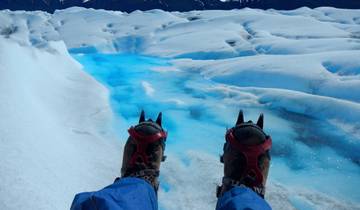
- Hiking & Trekking
- Christmas & New Year
9 Days Trekking to Discover the best of Torres del Paine & El Chalten, with a visit to Moreno Glacier @ El Calafate
This trip was amazing! Great communication with us and the tour was modified when we struggled to get our Chile visa - thankyou so much for the support! Argentina is an amazing place, everything flowed like clock work. Argentina has been our favourite country so far; amazing people (honestly happy and larger than life), the food is so tasty and the nature (you cant compete with Patagonia!). Left this tour incredibly happy and sad it ended. Highly recommended.
- 10% deposit on some dates Some departure dates offer you the chance to book this tour with a lower deposit.
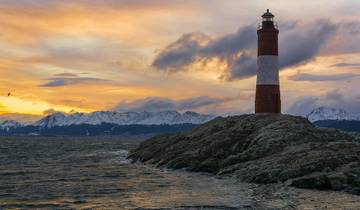
The End of the World (7 Nights)
I was really happy with my tour! The company had created a very nice itnerary and I could cover all good areas in Patagonia.
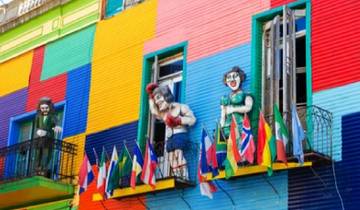
South American Landscapes - Argentina & Chile
My husband and I did the South American landscape tour, Argentina and Chile. It was Amazing!!!! The tour as is has a great itinerary but I had a few extra things I wanted to add. Wendy was able to add my excursions and arrange all the transportation. Everything was so well organized the rides and tours were always on time and always in contact with you. We loved our trip. Would definitely plan a trip with them again!!!
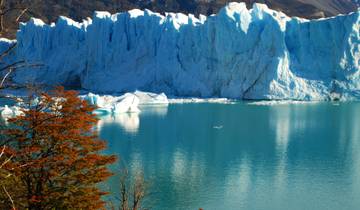
Patagonia Adventure Tour (15 Nights)
This is an epic adventure with excellent support from the HI Travel team where you witness the vastness of Patagonia and (almost) all it has to offer from epic scenery to incredible wildlife. Everything booked via the tour went to plan except for a few minor delays with buses but the team kept me informed and answered any questions almost immediately.

Argentina & Chile : El Calafate, Torre Del Paine W/local flights
Overall experience was good, there are a few places where they need to improve, then the trip will become perfect.

Ultimate Patagonian Adventure: 11-Day Journey from Santiago to Chilean and Argentine Patagonia.
- Book With Flexibility This operator allows you to rebook your dates or tours with them for free, waiving change fees.

Exploring the "Carretera Austral": A 6-Day Journey from Coyhaique City
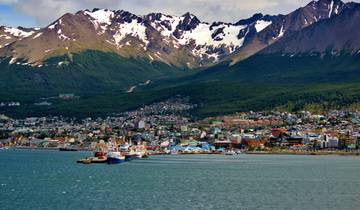
End of the Earth
Excellent adventure.Very good tour manager
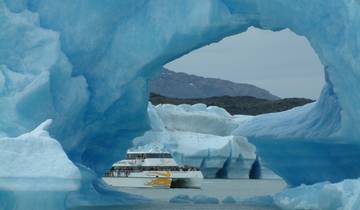
Exploring Full Patagonia Argentina & Chile
Great people and gorgeous natural sights!!

- Sightseeing
4-Days Discovery Puerto Natales & Torres del Paine
Excellent service, everything was so smooth eg, the pick up, comunication, transportation, the tour, hiking, meals and hotel. Over all, recommend to book with this tour.

- Wildlife Trekking
Patagonia: Torres Del Paine ‘W’ Trek – 5 Days
Tour was well organized, although for second day, probably due to unavailability of Refugio's, the scheduled trek was too long for me (32 km). Would have preferred more balance as the next few days were a lot shorter. Company handled our request for private transfer and also a change in Itinerary that we made during our trip with efficiency. Personal that accompanied us were very positive and professional. Had a very nice trip and would recommend.

Argentina & Chile: Amazing Patagonia - 13 days
Everything was really professionally done. The tour group was great at responding to questions. I just had one connection that was problematic because the pretrip itinerary indicated a different location for bus pickup as the actual physical ticket I received. hotels were top notch. All rides were on time. Professional and fun!

- Mountain Hikes
Patagonia Hiking
The G adventure tour is excellent. The trip was great because of excellent program and great CEO from G adventure. Starting from Buenos Arias, everything is planned and taking care of. We had excellent weather, a great group of adventure minded people. Val (our CEO from G adventure) communicated everything ahead of time and making sure everyone's needs were met. The sighs and hiking were great. Val reserved dinner for the group almost everyday so we could have fun after a hard day of hiking. All in all, a trip to remember.
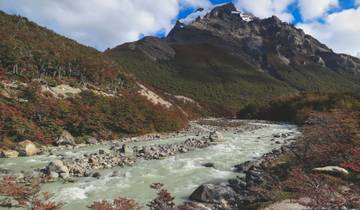
Argentina & Chile: Amazing Patagonia - 9 days
The tour overall was excellent - we saw & did everything we wanted to do. Only comments are to not book hosteria so far out of town that it's either a 10 minute taxi or a 45 minute walk to the centre eg Hosteria Koi Aiken in El Calafate. It would be wise not to put in tour notes that bus stations are within walking distance of most hotels because they are not. Also the address for your agent in El Calafate in the summary notes is incorrect but correct in the trip notes
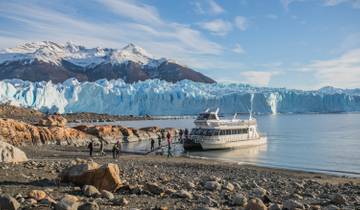

Land of Glaciers: El Calafate
Absolutely awesome. Everything.
Trips to Patagonia Reviews
Overall, I thought this was a pretty great trip package! The BIG highlights are of course Mount Fitz Roy and Laguna Torre (El Chalten), Glacier Perito Moreno (El Calafate), and Base Las Torres (Torres Del Paine, Chile). I personally thought the initial hike of the trip though (on the 2nd day) called Laguna Amarga was a little basic, short, and not overly fascinating or challenging and maybe could've been replaced with something else? But that said, we still saw some guanacos (llama-like animals) on the path and the bulk of the Los Torres park mountains in the distance during that hike. So I guess it was okay. In terms of the accommodations, I was very very pleased with the selection, especially the first and last hotels (in Puerto Natalas, Chile, and El Chalten, Argentina). They were all pretty bouge-y / snazzy looking places with nice amenities. I wish the hotel in El Chalten had better / faster wifi though. As a side note, I bought a cell data plan for Argentina and only had Edge (slower than 3G) in El Chalten and there were also no cell service on the bus rides / roads between cities. So better and faster wifi especially in this last location would've been nice. In terms of the flow, organization, and execution of the itinerary and this travel company, A+, I must say! Drivers there to pick you up from airport / bus and transfer to hotel, waiting for you with a name card in hand. Good communication from the tour companies if there was a change in itinerary for the following day. Hotels were well picked with breakfasts included. Final thoughts? Look, if you wanted to do all the above highlights for hiking in a more budget-friendly way, sure you can find a way to do it. You can buckle down, search the places, organize the accomodations, stay at cheaper hostels, pay for taxis as you go, organize the bus transfers, not have guides on the hikes and do them all solo, etc. Therefore, you might pay a hair bit more in taking this package than you would if you figured out and just did everything yourself, but you do feel like you're living in the heart of luxury once your done the hikes. And the views and open-air, scenic experiences of those hikes are pretty great, too! 4.5 out of 5 stars
Patagonia Tours starting in:
- Buenos Aires (76)
- El Calafate (44)
- Santiago (26)
- Ushuaia (25)
- Puerto Natales (25)
- San Carlos De Bariloche (22)
- Punta Arenas (17)
- El Chalten (11)
- Puerto Montt (10)
- Puerto Madryn (5)
- Group (249)
- Explorer (227)
- Family (200)
- Partially Guided (175)
- Personalized (170)
- Fully Guided (135)
- Active (131)
- Hiking & Trekking (99)
- Private (97)
- In-depth Cultural (74)
- Self-Guided (60)
- Custom (34)
- Ocean Cruise (17)
- Bicycle (10)
- Intl. Flights Included (9)
- 3 Day Tours (13)
- 7 Day Tours (118)
- 10 Day Tours (64)
- 2 Week Tours (53)
- 3 Week Tours (38)
- Spring 2024 (167)
- Summer 2024 (167)
- Fall / Autumn 2024 (257)
- Winter 2024 / 2025 (265)
- Spring 2025 (171)
- Summer 2025 (80)
- Fall / Autumn 2025 (94)
- Winter 2025 / 2026 (71)
- May 2024 (171)
- June 2024 (164)
- July 2024 (160)
- August 2024 (167)
- September 2024 (192)
- October 2024 (239)
- November 2024 (252)
- December 2024 (251)
- January 2025 (192)
- February 2025 (183)
- March 2025 (171)
- April 2025 (124)
- May 2025 (88)
- June 2025 (79)
- July 2025 (66)
- August 2025 (67)
- September 2025 (61)
- October 2025 (76)
- November 2025 (78)
- December 2025 (68)
- 10 Best Patagonia Trekking Companies (with 143 Reviews)
Travel Styles
- Budget (68)
- Luxury (10)
- Singles and Solo (270)
- For Couples (66)
- Seniors (164)
- Search Please fill out this field.
- Manage Your Subscription
- Give a Gift Subscription
- Newsletters
- Sweepstakes
- Destinations
- Central & South America
Bariloche Is Patagonia's Most Charming Town — Here's Everything You Need to Know to Plan Your Trip
Visit this beautiful Argentina escape any time of the year.
:max_bytes(150000):strip_icc():format(webp)/Jillian-Dara-2000-bdb4477b08f543a88d386977814c55b4.jpg)
In the southern part of Argentina, occupying the northern Patagonia region, the low-key mountain town of Bariloche hugs Nahuel Huapi, a startlingly crystalline glacial lake centered in the national park of the same name. Early in the 20th century, Swiss, German, and Austrian settlers decamped here, lured in by the invigorating alpine air and knee-buckling natural beauty. And today, European flourishes continue to abound in Bariloche, from the rustic wood chalets to the popularity of craft chocolate.
Thankfully, all these charms are well within reach for porteños , as the two-hour flights from Buenos Aires to Bariloche are as plentiful as they are affordable. Below, how to make the most of a visit to the alluring Patagonian destination.
Since Bariloche is one of those increasingly rare spots that transitions through four distinct seasons, there's never a bad time of year to visit. World-class skiing and snowboarding at Catedral Alta Patagonia (Argentina's largest ski resort) are the area's biggest draw — the peak winter season extends from July through September — but there are plenty of other ways to spend time outdoors.
For staggeringly expansive views of Lake Nahuel Huapi and the surrounding mountains and forests, take the chairlift, which runs all year long, up to the top of Cerro Catedral. Given the topographic diversity of Bariloche, hiking — Refugio Frey, Cerro Llao Llao, and Cerro Campanario are among the most popular treks — is a sublime way to pass the time. If you prefer a more leisurely pace, fish or horseback ride.
The actual town of Bariloche is easy to explore on foot and takes but a few hours. Start by strolling down La Calle Mitre, which is lined with lots of little shops for picking up souvenirs and chocolate. (Bariloche is considered the chocolate capital of Argentina.) Then, make your way to to the main square, centro cívico (civic center), and cathedral designed by Alejandro Bustillo for a dose of history and architecture.
Where to Stay
Selina bariloche.
If you're seeking a budget-friendly, yet well-appointed stay, book Selina Bariloche . From the accommodations — ranging from shared community rooms to private suites — to the light-drenched common areas, it's all about fostering bohemian, communal vibes. Tuck into local favorites (including empanadas, pizza, and medialunas ) at The Playground (the hotel's signature multi-purpose space), and kick back with cocktails and a live DJ set at the lounge downstairs.
Llao Llao Hotel
Centrally located in Nahuel Huapi and surrounded by unparalleled beauty everywhere you turn, Llao Llao Hotel is a stately 1930s resort featuring 205 rooms and suites, an 18-hole golf course, five restaurants, and a bevy of outdoor activities (like archery, mountain biking, and kayaking). Partake in local tradition by booking the "Llao Llao Tea" — imagine a sumptuous spread of custom-blended tea, indulgent sweets, and delicate sandwiches — hosted in the Winter Garden .
Where to Eat and Drink
Cervecería patagonia.
Though the local craft beer trend kicked off in the early 2000s, Cervecería Patagonia remains the most popular spot to kick back with brews and views. The regular offerings (such as the pale ale, Weisse, and porter) and specials are listed on the chalkboard, and while the kitchen's beer-friendly bites are no slouch, it's the golden, thick-cut fries you shouldn't miss.
Alto El Fuego Parrilla
Don't be fooled by the humble-looking house. Because inside, you'll discover one of Bariloche's coziest and most popular parillas , Alto El Fuego . Watch the chefs braid entraña (skirt steak) in the open kitchen before searing it to order and pairing it with one of hundreds of exceptional wines from the basement cellar.
La Cabrona Food Truck
Along Bustillo Avenue — one of Bariloche's main roads — you'll find the popular food truck La Cabrona . Run by Julieta Caruso, it whips up hearty, hand-held snacks, like burgers and bao buns stuffed with lamb, chorizo, and vegetables.
Specialty shops are all over town, but for the best, locals recommend Mamuschka . The bright, cherry-red cafe is stocked with hundreds of chocolate treats, from bark to bonbons, and there's a sit-down area in the back where you can sip hot chocolate or dig into ice cream.
El Boliche de Alberto
While there's no shortage of quality steaks at this ever-lively restaurant — reservations are a must — El Boliche de Alberto is just as dependable for toothsome, made-from-scratch pastas. As for what to order? Try the house Lasagna Alberto, generously layered with meat sauce, ham, cheese, and vegetables.
Related Articles
Voyages with Val
Patagonia, Argentina Itinerary- 5 Days

Planning on visiting the Argentinian side of Patagonia? There are so many things to do and so many sights to see, you will want at least 5 full days to explore the Patagonian mountain range from the mountain town of El Chaltén and take a day trip to Perito Moreno Glacier! I did the itinerary below as part of a guided tour, and could not recommend it enough! Our guide Carlos was great and the itinerary allowed us to see as much as possible with little worry or stress!
My trip to Patagonia was hosted, but I was not required to write this post and all my thoughts about Patagonia and our guided trip are my own.
Getting to Patagonia, Argentina

To get to Patagonia, Argentina from another country, you will likely need to take a flight to a major Argentinian airport such as Buenos Aires (EZE) and then take a regional flight to El Calafate airport (FTE) .
El Calafate to El Chaltén
From El Calafate, it is about a 2 hour 30 minute drive to the small town of El Chaltén which sits at the base of the Patagonia mountains. You can rent a car to get to Chaltén or take a bus ride between the two towns. Most of Chaltén is walkable, so there is not much need for a car once you arrive in the town.
Group Trip to Patagonia, Argentina

I went to Patagonia, Argentina as part of a group trip and I can’t recommend it enough! Especially if you book as a solo female traveler, I met so many amazing women and had so much fun exploring as a group!
Our guide was Carlos and I can’t imagine a better guide! He is extremely knowledgeable on the area, and was able to pivot our plans based on weather and conditions which is especially important in Patagonia, where the weather can change in an instant!
Day 1- Hiking to Laguna de Los Tres

- Distance: 13.7 miles
- Elevation Gain: 3,503 feet
- Difficulty: Difficult
Laguna de los Tres is a difficult trail to climb, but oh so worth it in the end! This is one of the most stunning lakes in Patagonia, and possibly the world, and must be on your Argentina itinerary!
You can start this trail from two trailheads, but the easier-to-access trailhead starts on the Sendero Monte Fitz Roy Trail which is located at the North end of the town of El Chaltén.
This is a loooong trail so start early make sure you have enough light, and limit the amount of time you are exposed to the sun in the morning!
Laguna Capri

At around 1.7 miles you’ll reach a fork in the trail and if you continue to the left, you’ll reach the shore of Laguna Capri.
This is a beautiful spot to take in the lake with views of Fitz Roy (Cerro Chaltén) , and also one of two spots on the trail with bathrooms.
Laguna de Los Tres

After Laguna Capri, the trail is flat for a few miles before it starts to ascend to Laguna de los Tres. About 5.5 miles into the hike, the trail becomes much steeper and gains over 1500 feet in 1.3 miles. This part of the trail is especially difficult so make sure to have lots of water and snacks to make it to the top.
When you reach the top, the sight that greets you is one of the most beautiful in Patagonia- Laguna de los Tres. When melted the lake is a striking blue, but it is also a sight to see frozen.
Day 2- Explore the Town of El Chaltén & See Condors

After a hard day of hiking on Day 1, spend Day 2 exploring the town of El Chaltén. There are so many cute shops and restaurants in town, and you can see mountains from all around.
Where to Eat in El Chaltén

Below are some of the best places we ate in El Chaltén, Argentina, all recommended by our guide!
- La Oveja Negra – This was my favorite place we ate in Argentina! Meats like beef, pork, and lamb are offered all throughout Argentina, but this place had the best in my opinion!
- La Nana – This is a cute cafe with great coffee, waffles, and homemade lemonade! We went here several times because it was so close to our hotel.
- La Birre Del Rancho – A tap house with delicious and large portions- this is the perfect place to grab a beer and burger after a day of hiking in Patagonia!
Mirador de los Cóndores

- Distance: 1.6 miles
- Elevation Gain: 426 feet
- Difficulty: Moderate
This is a short but scenic trail that starts at the Southernmost end of El Chaltén. It leads up to a great lookout of the town and Fitz Roy in the distance. Here you are very likely to see condors and eagles flying overhead.
Day 3- Via Ferrata
View this post on Instagram A post shared by Val | PNW Outdoors & Travel (@voyageswithval)
On Day 3 of your Patagonia itinerary, try something different! One unique thing to do in El Chaltén is to climb a via ferrata. Carlos booked us through Estancia Bonanza , and it was a fantastic experience!
If you don’t know, a via ferrata is similar to climbing, but you are hooked into a permanent metal cable on the mountainside the whole time and there are often metal rungs making it a bit easier than regular climbing.
This particular climb was very beginner friendly with a small zipline at the end to a viewpoint of the mountains.
Day 4- Laguna Torre

- Distance: 11 miles
- Elevation Gain: 1,643 feet
On Day 4, it’s time for another long hike to Laguna Torre . This one is still long but much easier than Laguna de los Tres.
The first two miles are a bit steep and end with a great view of the range and Cerro Torre, but after that, the trail is more even.

At the end of the trail is Laguna Torre a lake named for its central view of Cerro Torre. This makes for a beautiful view from the lake, made even more stunning by the glaciers floating in the lake.
Eat lunch at the lake before heading back. Carlos brought out wine at lunch which was perfect to enjoy with this view!
Day 5- Perito Moreno Glacier

You can’t visit Argentina without stopping by Perito Moreno Glacier ! It is about a 4-and-a-half-hour drive from El Chaltén, but only 2 hours from El Calafate which is where we stayed the night before.
It is about $30 per person to enter Parque Nacional Los Glaciares which contains the many boardwalks to view the massive glacier.

The unique thing about Perito Moreno is just how close you can get to it! Two and a half miles of boardwalks crisscross in front of the glacier at different heights, so no matter where you are, you are sure to get a good view of the glacier.
You May Also Like
- 7 Day Iceland Ring Road Itinerary
- 4 Day Oregon Road Trip
- Big Island, Hawaii Itinerary- 4 Days
SAVE IT FOR LATER

Leave a Reply Cancel reply
Your email address will not be published. Required fields are marked *
This site uses Akismet to reduce spam. Learn how your comment data is processed .
Spark Nomad

Patagonia Itinerary: 3 Best Travel Guides From Chile To Argentina in 2024
Where should you start your Patagonian adventure: Chile or Argentina? What should you absolutely not miss on your trip? We’re here to help you make the most of your Patagonia itinerary without missing a thing.
If snowcapped mountains, expansive glaciers, virgin forests, and igneous volcanoes appeal to you, you’re doing the right thing when choosing Patagonia.
Without a detailed Patagonia itinerary to your guide, you might get lost in Patagonia’s expansive land area. And with unpredictable weather conditions, you might have the most heartbreaking of experiences if your trip gets ruined without a planned itinerary.
Our Patagonia itinerary starts in Chile and ends in Argentina, or you can do it the other way around, making customizations according to your preferences. We will give you a comprehensive guide covering each step of your trip, including transportation, accommodation, and budget. Let’s dive in.
Table of Contents
Patagonia 10-Day Itinerary
Overview of the 10-Day Itinerary:
Day 1 : Flight from Santiago to Punta Arenas
Day 2: Penguin watching at Punta Arenas
Day 3: A boat tour of Lago Grey in Torres del Paine National Park
Day 4: Hiking the Mirador Valle del Frances in Torres del Paine
Day 5: Go to Torres del Paine and do the famous Las Torres hike
Day 6: Visit El Calafate, Argentina, for the Perito Moreno glacier viewing
Day 7: Short hikes in El Chalten : visiting the Chorrillos del Salto waterfall and the Los Condores and Las Aguilas viewpoints
Day 8: Laguna Cerro Torre hiking in El Chalten
Day 9: Mt. Fitz Roy/Laguna de Los Tres hiking in El Chalten
Day 10: Flight to Buenos Aires, Argentina
Our 10-day Patagonia itinerary starts in Punta Arenas (Chile) and ends in Buenos Aires (Argentina). The itinerary allows you to adjust and remove days at your convenience and add rest days wherever necessary. With a 10-day Patagonia itinerary, it also becomes easy to accommodate harsh weather if such situations arise.
While you won’t be bored on this itinerary, you’ll make the absolute most of your trip and see the highlights you can’t miss. I loved each one of these activities, and I can’t recommend them enough.
Day 1: Flight From Santiago to Punta Arenas
Many flights run from Santiago to Punta Arenas , ranging from 159,170 to 198,962 Chilean pesos/CLP (200 to 250 US dollars). You can choose from JetSmart, LATAM, or Sky Airlines; a non-stop flight takes 3 hours and 25 minutes.
Once you’ve flown from Santiago and reached Punta Arenas through one of these airlines, you can take the bus or taxi to Almasur or any other of the beautiful hotels of the city and spend a restful night there.
The quickest way to the hotel might be a taxi, which drops you at your destination in 15 to 20 minutes.
A night’s stay at the hotel of your choice includes amenities like free Wi-Fi, cozy and comfortable rooms, extensive buffet breakfast, free parking, access to the fitness center, and so much more.
Day 2: Penguin Watching at Punta Arenas
You’ve woken up fresh after a night’s stay at the hotel; now it’s time to get up and get going with the first task on your list. What’s more fun than visiting the colony of the little guys yourself at King Penguin Park ? Book a tour in advance, as this attraction usually sells out quickly during the high season.
If you have already seen the Magellanic Penguins at Isla Magdalena , this park has a large colony of King penguins, the world’s second-largest after the Emperor penguin. The price for a 1-day group excursion to the park starts at 103,000 CLP ($130). Have fun watching the King penguins going about their normal lives, swimming with their chicks, and playing!
Day 3: Exploring Torres del Paine: Boat Tour of Lago Grey or Starting the W Trek

Today you will visit the incredible Torres del Paine National Park , which hosts mountains, bright icy glaciers, and blue rivers.
Organize your hiking gear, book a cab, take a bus, and set off. We recommend booking a car or riding a taxi, which will take about 5 hours in normal traffic to cover the distance of about 217 mi (349 km) from Punta Arenas to Torres del Paine National Park.
Book a hotel for your stay at the park. You can choose from the many spacious, fully furnished, and budget-friendly hotels in Torres del Paine, and you’ll be good to go.
On your first day in Torres del Paine National Park, you will visit Lago Grey. Lago Grey, or Grey Lake, is one of the most iconic sites in the park. It is a beautiful 1,640 feet deep (500 meters) lake, surrounded by large attractive rocks, with waters honing huge icebergs detached from the Grey Glacier.
It’s the perfect place to kayak, canoe, take breathtaking photos, or enjoy the view.
Take a short walk through the woodlands to reach the lake’s shore while experiencing the park’s rich wildlife. Once you reach the shore, sail and enjoy the encumbered views in all directions.
Alternative plan:
W Trek. We opted for one of Patagonia’s most famous treks instead of doing the day trips below. A memorable hike through the mountains, the W Trek is a popular hiking trail in Chile’s Torres del Paine.
An important note is that it takes 4-5 days to complete the W Trek , so you’ll have to add a day to your itinerary. Alternatively, you can get it down to 3 days from the ferry to Camp Frances to Camp Chileno.
A quick tip is to plan your campsites at least 3 months in advance. We went in early November and booked our campsites in August.
Day 4: Hiking at Torres del Paine: Mirador Valle Del Frances
Mirador del Valle. Your first hike in Torres del Paine will be to Mirador Valle del Frances (the French Valley), where you must catch a ferry to get to the trailhead. The ferry trip would take about a half hour, and the hike would be about 7 to 8 hours long.
The hike might be challenging due to the significant elevation, but you will enjoy the outstanding views of the beautiful mountains, golden grass, green shrubs, and the silky green waters of the lake.
Day 5: Torres Del Paine: Las Torres Hike
Today we’re going to one of Patagonia’s top hikes, the Las Torres route , so remember to gear up wisely. Wear adequate clothing, don’t underestimate the weather, and pack well!
The hike is about 11.2 miles long (18 km), with a 2,953 mi (900 m) elevation, which should take about 6 to 9 hours to complete depending on how fit you are. Leave early to get to the trailhead on time.
It’s one of my favorite hikes we’ve done in Torres del Paine National Park. The view at the top lets you forget all the hiking you’ve done earlier that day.
After you’re done with your hike, you’ll pass by camping Chileno. You can stop for a rewarding drink before returning to your accommodation.
Day 6: El Calafate, Argentina: Perito Moreno Glacier Viewing

Book a car ride from your hotel, and you’ll reach El Calafate in about 3 and a half hours. You’ll cross Chile’s border and enter Argentina, covering a distance of about 157 mi (253 km). Just be sure to plan some extra time for border crossing, and don’t come around lunchtime, when they are often closed.
Once you’ve arrived, rent a car or take the bus (12,000 ARS & leaves in the morning and afternoon) to set off to Perito Moreno glacier viewing. This glacier is the third largest in Argentina. It can be explored through a boat tour where you will sail through Lake Argentino and visit the 5 famous glaciers, including Perito Moreno, or mini trekking during a guided day tour where you can pass the Magellanic Forest on your way home.
You can also opt for cruising or kayaking on the wonderful waters and have a grand time.
Day 7: Short Hikes in El Chalten: Visiting the Chorrillos Del Salto Waterfall and the Los Condores and Las Aguilas Viewpoints
Take a bus or a cab, and you’ll reach El Chalten from Calafate in about 3 hours. Upon arriving, book y ou r hotel , prepare your stuff, and get ready to hike. This corner of Patagonia is unique; you can spot it from afar through its tall mountains and icy glaciers.
El Chalten is perfect for trekking, hiking, horseback riding, and getting lost in nature’s beauty. The trek will lead you deep into a hillside, where you will find the Chorrillo del Salto waterfall.
You can also follow the trek to reach the Los Condores and Las Aguilas viewpoints, which are excellent places to view the mountain peaks and glaciers spread over the horizon.
How much hiking you do today will all depend on how you feel. We planned a ‘rest’ day right about here, where we only did 1 short hike and were too tired for anything else.
Day 8: Laguna Cerro Torre Hiking
Day 8 is for hiking the Laguna Cerro Torre , which offers one of the top hiking sites in El Chalten.
The trail in the national park is relatively flat, and the hike is long but should be doable. Get a map with hiking trails from an information center or your hotel and get hiking. Alternatively, download Maps.me on your phone to always have offline maps available.
Check the weather before you go. If the weather is cloudy and rainy, the visibility can be decreased.
Day 9: Fitz Roy/Laguna de Los Tres Hiking

It’s time to go on one of the most iconic hikes of Argentina, the Laguna de Los Tres trail, also known as the Fitz Roy hike , as you will have the said mountain and lake in the background as you trek. Rated as moderate to hard, the trail is a 15-mile (24 kilometers) round trip that takes 8 to 10 hours with an elevation gain of 2,835 ft. (864 m).
Remember to take your trekking poles, which will help you in the last few kilometers. Enjoy the panoramic views during the trail and wait for the heavenly view of the lake that comes at the end of it; you will be overjoyed.
You’ve had your fair share of fun and enjoyment, and now it’s time to return home. Book your flight from El Chalten to Buenos Aires , and you’re all set to take off.
Patagonia 3-Week Itinerary
If you have a little more time, this 3-week itinerary will give you just the right amount of space to add and adjust sites according to your preference, guaranteeing that you will visit some of the best sites in Patagonia.
Here’s a quick overview:
Week 1: Torres del Paine National Park
- Day 1: Fly from Santiago into Punta Arenas. Catch the flight from Santiago to Punta Arenas . LATAM, Sky Airlines, and JetSmart are the main airlines to consider. Use their Chilean website to book your ticket, which will be cheaper. Once you’ve reached Punta Arenas, make arrangements for your hotel lodging. You will spend your next 2 days watching Patagonian penguins on the Island of Magdalena . You can take the Melinka, a public ferry, at 8 a.m. on the coast of Punta Arenas for about 55,000 CLP ($80), and you’ll arrive in 2 hours.
- Day 2 : Punta Arenas to Puerto Natales – transfer to Puerto Natales, the Torres del Paine National Park gateway. Spend the day exploring the town and preparing for your trek.
- Day 3-7: Trekking in Torres del Paine – Spend the next 5 days trekking the W Circuit in Torres del Paine National Park. This is one of the most iconic treks in Patagonia, taking you through stunning mountain landscapes and past glaciers, lakes, and waterfalls. You’ll stay in refugios (mountain huts) along the way.
- Day 8: Relax in Puerto Natales – After your trek, take a day to rest and recover in Puerto Natales. Visit museums, try local cuisine, or relax by the water.
Week 2: El Calafate and El Chaltén
- Day 9: Puerto Natales to El Calafate – Transfer to El Calafate, a small town on the shores of Lake Argentino. Explore the town and visit the nearby glaciers.
- Day 11-12: Perito Moreno Glacier – Spend 2 days visiting the Perito Moreno Glacier , one of the most impressive glaciers in the world. You can walk on the glacier, take a boat tour , or just enjoy the views from the observation decks.
- Day 13: El Calafate to El Chaltén – Transfer to El Chaltén , a small town nestled in the mountains and known as the trekking capital of Argentina.
- Day 14-16: Trekking in El Chaltén – Spend 3 days trekking in the mountains around El Chaltén. The trails here offer stunning views of glaciers, lakes, and peaks, including the iconic Mount Fitz Roy.
Week 3: Tierra del Fuego and Ushuaia

- Day 17: El Chaltén to Ushuaia – Transfer to Ushuaia , the southernmost city in the world. Explore the town and visit the local museums and attractions.
- Day 18-19: Tierra del Fuego National Park – Spend 2 days exploring Tierra del Fuego National Park, which offers some of the most dramatic landscapes in Patagonia. You can hike , kayak, or take a boat tour to see the wildlife and scenery.
- Day 20-21: Beagle Channel and Departure – Take a boat tour of the Beagle Channel, which offers stunning views of the mountains and glaciers. Depart from Ushuaia and fly back home.
Patagonia – 1-Month Itinerary
If you have a month to explore Patagonia, you can delve even deeper into the incredible landscapes and culture of the region. Here’s a suggested itinerary for a 1-month trip:
Week 1: The Lake District and Northern Patagonia
- Day 1-2 : Bariloche – Fly from Buenos Aires into Bariloche and explore this picturesque town nestled in the Andes mountains. Enjoy stunning views of the surrounding lakes and mountains, visit local artisan markets, and sample some of the region’s famous chocolate.
- Day 3-4 : San Martin de los Andes – Take a scenic drive along the Seven Lakes Route to reach the charming town of San Martin de los Andes. Enjoy hiking, fishing, or kayaking in the nearby Lanin National Park, and take in the views of the Andes mountains and glacial lakes.
- Day 5-7 : Northern Patagonia – Head further south to explore the rugged landscapes of Northern Patagonia. Visit the Alerce Andino National Park to see ancient Alerce trees, hike in the mountains, and visit local Mapuche communities to learn about their culture and traditions.
Week 2: The Chilean Fjords and the Island of Chiloé
- Day 8-11 : Chilean Fjords – Take a scenic cruise through the Chilean Fjords, a network of narrow channels, inlets, and islands that offer breathtaking views of glaciers, mountains, and wildlife. Stop at remote villages along the way to learn about the region’s history and culture.
- Day 12-14 : Chiloé Island – Visit the Island of Chiloé, known for its vibrant folklore, colorful houses, and unique cuisine. Explore the island’s many churches, designated as a UNESCO World Heritage Site, and take in the views of the Pacific Ocean.
Week 3: Southern Patagonia
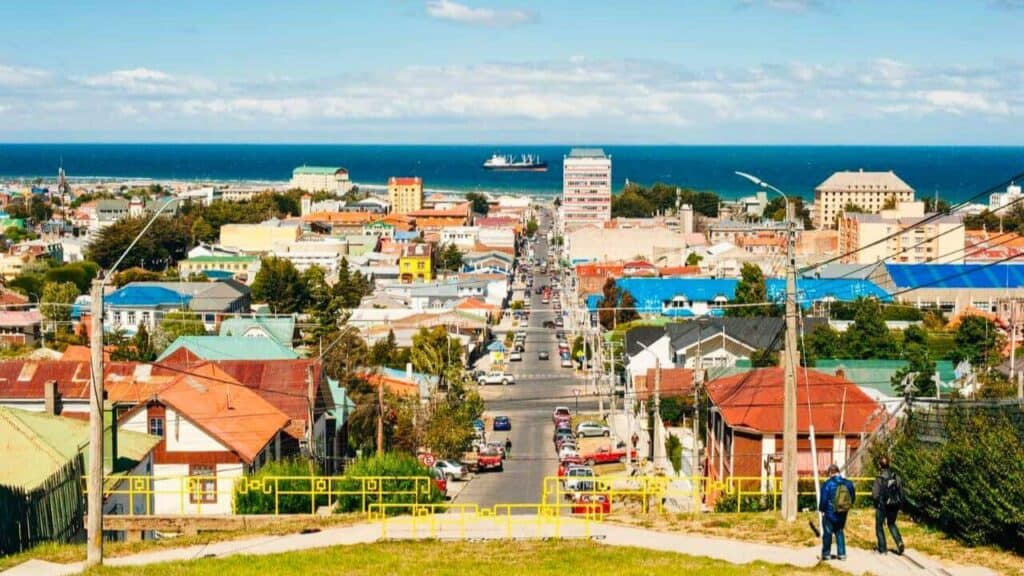
- Day 15-18 : Puerto Natales and the Última Esperanza Sound – Fly to Puerto Natales, the Torres del Paine National Park gateway, and spend a few days exploring the surrounding area. Take a boat tour of the Última Esperanza Sound to see glaciers, fjords, and sea lions.
- Day 19-21 : Tierra del Fuego and the Strait of Magellan – Cross the Strait of Magellan to reach Tierra del Fuego , the southernmost tip of South America. Visit the remote town of Porvenir, explore the Karukinka Natural Park, and take a boat tour to see penguins and other wildlife.
Week 4: The Argentinean Pampas
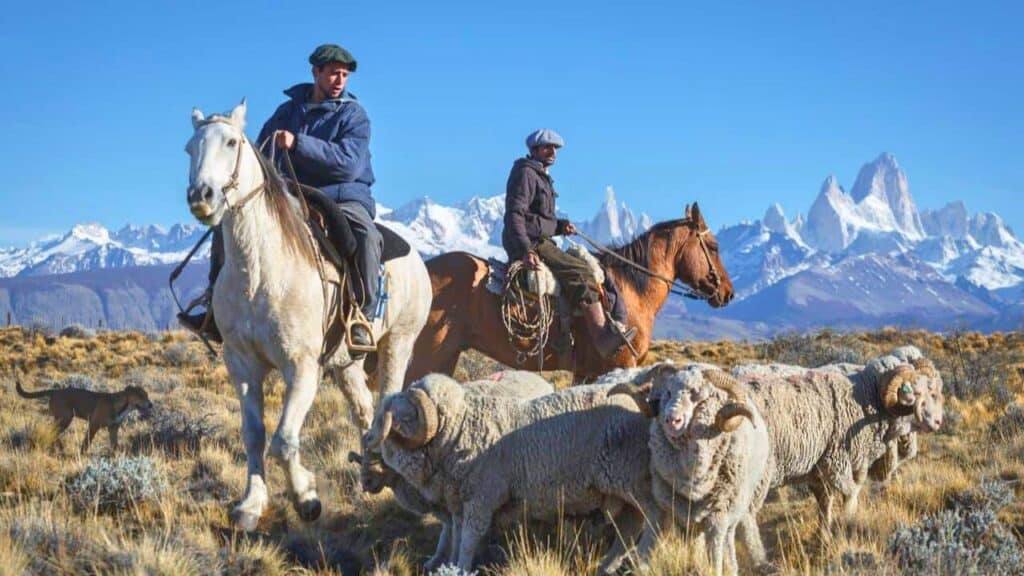
- Day 22-26 : Estancia Life – Visit a traditional estancia (ranch) on the Argentinean Pampas to experience the gaucho (cowboy) way of life. Enjoy horseback riding, cattle herding, and other outdoor activities, and learn about the region’s history and culture.
Day 22-26 alternative option : Visit Ushuaia, the “city at the end of the world,” located at the continent’s southernmost tip. Enjoy its beautiful snowcapped mountains and the waterfront views at Lapataia Bay .
For a taste of history, visit the city’s numerous museums: the Museum of the End of the World, Casa Beban, Maritime Museum, and Historia Fueguina. You can book any of the city’s lovely hotels while you spend your days exploring Ushuaia’s museums, restaurants, coast, and so much more!
- Day 27-29 : Buenos Aires – Fly to Buenos Aires , the cosmopolitan capital of Argentina, and spend a few days exploring the city ‘s many attractions. Visit historic neighborhoods like San Telmo and La Boca, attend a tango show, and sample some of the city’s famous cuisine.
- Day 30-31 : Departure – Fly back home from Buenos Aires .
Frequently Asked Questions (FAQs) – Patagonia Itinerary
How many days do you need in patagonia .
If you’ve got fewer things to do, your trip will be shorter, say 2 or 3 weeks will be enough. Patagonia’s weather is always unpredictable; you can never plan your trips to the T, so you need to reserve a few days extra in case things don’t go as you want.
If you want to make the most of it, we’d say a month should be it. Patagonia is an incredibly large area to explore.
If you wish to see most of Patagonia, including the most magnificent places like Perito Moreno Glacier, Torres del Paine, El Chalten, Bariloche , Ushuaia, and more, you need a minimum of 3 to 4 weeks for your trip.
How To Stay Safe In Patagonia During Your Trip?
When traveling through Patagonia, safety begins with preparation. Dress in layers and wear sturdy footwear suitable for hiking through rugged terrains and changing weather conditions. Always carry a detailed map and a compass or GPS, stay informed about the weather forecasts, and ensure someone knows your travel plans, especially if venturing into remote areas.
Additionally, consider protecting yourself with travel insurance such as SafetyWing , which can cover medical emergencies, trip cancellations, and other unforeseen incidents during your stay. Use the widget below to snag the perfect policy for your needs and travel with peace of mind knowing you’ve got your back covered, no matter what adventures come your way!
Is Patagonia Better in Chile or Argentina?
Size-wise, Argentinian Patagonia is the winner as a larger area offers more places to explore and visit. The small and more rugged Chilean Patagonia may have fewer sights, but it is no less beautiful than Argentinian Patagonia.
Both have spectacular wonders which are worth seeing.
What is the Best Month to Visit Patagonia?
Most people choose the summer months from December to February to plan their hiking trails because the weather is warmer, and the winds are much less wild. But the shoulder season from September to November and February to April are good too. Who would want to miss the chance to see captivating landscapes like the famous Grey Glacier or the pumas and guanacos from the wildlife?
Visiting Patagonia in any month can be an adventure in and of itself, so whichever month you choose, visiting Patagonia will be the best decision of your life.
Which Part of Patagonia is the Best?
This question is a tough one to answer since Patagonia has so many wonderful sights to offer, but our top pick would be the Torres del Paine Park, Chile. The park is located in the south of Chile, near Puerto Natales, and is a beautiful place to visit and explore. It has many attractions like lakes, rivers, hot springs, and glaciers.
The landscape is characterized by glacial lakes and massive snowfields with huge crevasses, making it very challenging to visit. It also offers excellent hiking, exploring opportunities, and other activities like climbing, kayaking, or rafting on its rivers.
Conclusion – Patagonia Itinerary
From a compact week-long trip to a longer-yet-still-incomplete monthly travel calendar (or even an extended stay), you can customize your Patagonia experience to suit your travel goals, preferences, and budget.
Do your research, ask your questions, weigh your options, and make decisions based on what is right for you. Patagonia beckons and your itinerary better be all set for your safety, pleasure, and adventure. Have fun as you plan!
Your Ultimate Travel Guide & Booking Resources
Skyscanner is my trusted ally for booking flights, guiding me to the perfect travel options while making the journey planning process a breeze with its user-friendly interface and extensive search capabilities.
12Go Asia is my ultimate travel companion in Asia, offering the best budget service platform for seamless booking of trains, buses, ferries, and flights, ensuring every adventure unfolds smoothly and effortlessly.
Booking.com is my ultimate lodging partner. It offers many accommodations worldwide and simplifies my travel experiences with its user-friendly platform and unbeatable deals.
Get Your Guide is my go-to for personalized travel experiences, enriching my journeys with unique tours and activities curated to my interests, making every adventure unforgettable and tailored to my preferences.
SafetyWing is my peace of mind on the go, offering comprehensive travel medical insurance with affordable plans and hassle-free claims, ensuring I can explore the world worry-free, knowing I’m protected wherever I roam.
LifeStraw Go Bottle is my trusted hydration companion for outdoor adventures, filtering water on-the-go to keep me safe and hydrated, ensuring every hike or travel experience is worry-free and enjoyable.
Related reads:
- 14 Best Things To Do In Pumalin Park – A Patagonia Travel Guide
- 22 Exciting Things To Do in Patagonia This Year
Founder of Spark Nomad, Radical FIRE, Copywriter
Expertise: Personal finance and travel content. I’m a full-time traveler, and I’ve been to 49 countries and 5 continents. Education: Bachelor of Economics at Radboud University, Master in Finance at Radboud University, Minor in Economics at Chapman University. Over 200 articles, essays, and short stories published across the web.
Marjolein Dilven is a journalist and founder of Spark Nomad, a travel platform, and Radical FIRE, a personal finance platform. Marjolein has a finance and economics background with a master’s in Finance. She has quit her job to travel the world, documenting her travels on Spark Nomad to help people plan their travels. Marjolein Dilven has written for publications like MSN, Associated Press, CNBC, Town News syndicate, and more.
Argentine Patagonia Travel Guide
Courtesy of George Pachantouris | Getty Images

Best Times To Visit Argentine Patagonia
The best times to visit Argentine Patagonia are October through November (springtime in the southern hemisphere) and December through February (summertime). During these months, the weather is mild, and spectators can view natural attractions in their full splendor. You should make your spring and summer travel arrangements far in advance since visitors flock to Argentina for the optimal hiking conditions. Pack layers to combat Patagonia's heavy winds (especially if you're planning a visit to Southern Patagonia ). January and February draw the largest crowds, but October, March and April are also good times for sightseeing, boasting sunshine and temperatures in the 40s, 50s and 60s.
Weather in Argentine Patagonia
Data sourced from the National Climatic Data Center
Find Flight and Hotel Deals
Navigate forward to interact with the calendar and select a date. Press the question mark key to get the keyboard shortcuts for changing dates.
Navigate backward to interact with the calendar and select a date. Press the question mark key to get the keyboard shortcuts for changing dates.
Popular Times to Visit Argentine Patagonia
Tourism volume is estimated based on in-market destination search query interest from Google and on travel.usnews.com in 2015-2016. Hotel prices are sourced from a sample of U.S. News Best Hotels rates through 2015-2016.
Explore More of Argentine Patagonia

Things To Do

Best Hotels

You might also like

# 2 in Best Places to Visit in Spring

# 7 in Best Places to Visit in July 2024

Chilean Patagonia
# 2 in Best Places to Visit in Central and South America in 2023
If you make a purchase from our site, we may earn a commission. This does not affect the quality or independence of our editorial content.
Recommended
The 18 Best Napa Valley Wineries to Visit in 2024
Lyn Mettler|Sharael Kolberg April 23, 2024

The 25 Best Beaches on the East Coast for 2024
Timothy J. Forster|Sharael Kolberg April 19, 2024

The 50 Best Hotels in the USA 2024
Christina Maggitas February 6, 2024

The 32 Most Famous Landmarks in the World
Gwen Pratesi|Timothy J. Forster February 1, 2024

9 Top All-Inclusive Resorts in Florida for 2024
Gwen Pratesi|Amanda Norcross January 5, 2024

24 Top All-Inclusive Resorts in the U.S. for 2024
Erin Evans January 4, 2024

26 Top Adults-Only All-Inclusive Resorts for 2024
Zach Watson December 28, 2023

Solo Vacations: The 36 Best Places to Travel Alone in 2024
Lyn Mettler|Erin Vasta December 22, 2023

26 Cheap Beach Vacations for Travelers on a Budget
Kyle McCarthy|Sharael Kolberg December 4, 2023

The 50 Most Beautiful White Sand Beaches in the World
Holly Johnson December 1, 2023

- South America
- A One Week Patagonia Travel...
A One-Week Patagonia Travel Itinerary

Discover the depths of Chilean and Argentinian Patagonia, from spotting penguins to scaling mountains and trekking through some of the most incredible surroundings. We’ve rounded up all the adventures you absolutely shouldn’t miss.
Day 1: punta arenas to puerto natales.
Start your week in the serene location of Punta Arenas, one of the closest Chilean towns to Antarctica. From there, take a ferry to Isla Magdalena, a very popular penguin spotting location in South America where penguins rule the island and approximately 60,000 breeding pairs come every year. You can then visit Bahia Inutil where the only colony of king penguins outside of Antarctica resides. After a day of watching these adorable penguins in their natural habitat, it’s time to press on to Puerto Natales.

Day 2: Puerto Natales to Torres del Paine

Day 3: Hiking in Torres del Paine
If you’re a keen hiker and want to hike the more advanced W or O trails, you will need to allow for a longer stay in the Torres del Paine National Park as they take between four to ten days (the W trail being the shorter of the two). If you’re on a tight schedule then today is the day to do the Torres hike ! Some hikers tend to start before sunrise to catch views of the three towers as the sun comes up. Once you’ve reached the creamy green lake and the humongous towering peaks, you can relax and take in your well-earned view. Why not treat yourself to a meal in one of the refugios or hotels after your hard trek?

Day 4: Pehoe Lake and Grey Glacier
Stroll around the stunning turquoise Pehoe Lake and if your legs are tired from hiking, you can take a boat across the lake to enjoy the surrounding waterfalls and magnificent vistas. Your last afternoon in Chile should be spent at Grey Lake where the huge Grey Glacier sits. It’s accessible via a boat trip or by hiking across the ice on a Bigfoot Patagonia excursion where all the necessary equipment will be provided. Enjoy your last evening in Chilean Patagonia before heading to Argentinian Patagonia!

Day 5: Torres del Paine to El Calafate
It will be best to get the earliest possible bus out of Torres del Paine and across the Chile-Argentina border as the queues can take a longer time later in the day. Once you have arrived at El Calafate , Argentina’s glacier capital, you can peruse the shops on the main street, go horseback riding and settle into your accommodation. Enjoy an evening meal at any of El Calafate’s various restaurants to fuel up for the next day’s adventures.

Day 6: El Calafate to El Chalten
El Calafate’s most impressive attraction is the Perito Moreno Glacier in the Los Glaciares National Park. Spend the day seeing the huge glacier from a number of angles and listening to the loud thuds of glaciers melting and hitting the water. You can also walk around the park’s paths, take a boat trip to the glacier or even go on an ice-trekking trip across it. Once you have experienced the grandeur of Perito Moreno, make your way to the sleepy rustic town of El Chalten , where you can stay in hostels, refugios or eco domes.

Day 7: Cerro Fitz Roy
Your final day should be spent hiking one of the most impressive trails at the Cerro Fitz Roy . While the first half of the hike is a pleasant walk through the forests to the glaciers, the last part of the trek is hard work. Once you complete the hike, you will be greeted with extremely beautiful vistas. If you can’t bear to tear yourself away, there are plenty more hikes as well as glaciers you can visit either by boat or by kayak around El Chalten.

Since you are here, we would like to share our vision for the future of travel - and the direction Culture Trip is moving in.
Culture Trip launched in 2011 with a simple yet passionate mission: to inspire people to go beyond their boundaries and experience what makes a place, its people and its culture special and meaningful — and this is still in our DNA today. We are proud that, for more than a decade, millions like you have trusted our award-winning recommendations by people who deeply understand what makes certain places and communities so special.
Increasingly we believe the world needs more meaningful, real-life connections between curious travellers keen to explore the world in a more responsible way. That is why we have intensively curated a collection of premium small-group trips as an invitation to meet and connect with new, like-minded people for once-in-a-lifetime experiences in three categories: Culture Trips, Rail Trips and Private Trips. Our Trips are suitable for both solo travelers, couples and friends who want to explore the world together.
Culture Trips are deeply immersive 5 to 16 days itineraries, that combine authentic local experiences, exciting activities and 4-5* accommodation to look forward to at the end of each day. Our Rail Trips are our most planet-friendly itineraries that invite you to take the scenic route, relax whilst getting under the skin of a destination. Our Private Trips are fully tailored itineraries, curated by our Travel Experts specifically for you, your friends or your family.
We know that many of you worry about the environmental impact of travel and are looking for ways of expanding horizons in ways that do minimal harm - and may even bring benefits. We are committed to go as far as possible in curating our trips with care for the planet. That is why all of our trips are flightless in destination, fully carbon offset - and we have ambitious plans to be net zero in the very near future.

Places to Stay
The best hotels in rosario, argentina.

Guides & Tips
Meet the graveyard cats guarding a cemetery in buenos aires.

The Best Resorts in Argentina

See & Do
The 10 best coastal cities in argentina.

Welcome to Villa Epecuén: Argentina’s Underwater “Town that Drowned”

An Evening in Argentina From Your Own Home

Meet the Argentine Songwriter Who Defied Dictatorship With Children's Songs

The World’s Greatest Travel Experiences for 2022

The Photographer Recreating 120-Year-Old Images of Patagonia

The Best Guided Trips & Group Tours in Argentina

The Best Hotels in Ushuaia, Argentina, for Every Traveler

The Best Bed and Breakfasts in Argentina
Culture trip spring sale, save up to $1,100 on our unique small-group trips limited spots..

- Post ID: 1668704
- Sponsored? No
- View Payload
Classic Hikes of Patagonia
15 days | trek past glaciers, mountains and waterfalls on these classic hikes of wild south america.

Travel from the heaving streets of Buenos Aires to the remote wilderness of Argentina and Chile on this 15-day trekking tour. Hike to the clear waters of Laguna de Los Tres and see a glacial lake surrounded by jagged peaks when you explore Laguna Torre. Spend a few days deep in the wilds of Torres del Paine National Park, hiking past glaciers and watching rhea birds and pink flamingos preen in front of a snowy mountain backdrop. Finish up with a lagoon hike in Ushuaia and a night in Buenos Aires – the perfect end to an active adventure through the wilderness of South America. If you’re looking to tick off all the classic hikes of Patagonia (and then some!) – this trip is perfect.
Trip overview
- Witness Argentina’s Perito Moreno Glacier and listen to the symphony of thundering ice cracking along the 30 km-long expanse of electric blue. This is one of the few glaciers left that isn’t shrinking!
- Spend three days camped among the peaks of Chilean Patagonia – a great opportunity for a true digital detox. Sleep under an untouched sky and witness vast, ever-changing landscapes by day.
- Trek past the most beautiful waterfalls and glaciers of Torres del Paine National Park with your trip leader, and spot wildlife like guanacos, flamingos, foxes and rhea birds along the way.
- Explore Laguna Esmeralda – arguably the best hike in Tierra del Fuego National Park. Near Ushuaia (The End of the World), this is the nation’s only park with an ocean coastline.
- Begin and end your trip with time in bustling Buenos Aires – the perfect place to reconnect with the urban world after a remote adventure in the wild. Try local Argentinian food, dance the tango and hit the nightlife!
- This is a hiking trip, you should come prepared as the fitter you are, the more enjoyable all the hikes will be.
- Please read the packing list carefully and bring all essential items with you. Your suitability to the weather in Patagonia is an important factor to consider before you travel. Be prepared for all elements – rain, wind and extreme cold.
- The three-day camping adventure in Torres del Paine National Park is one of our favourite parts of this trip but remember facilities will be more basic on this part of the tour than others. We've sourced our accommodation very carefully and picked the best possible hotels in line with the Intrepid style of travel, but please note that service and accommodation in Argentina and Chile may differ from standards at home.
- In order to make the most of our time in Patagonia, this trip includes two particularly long travel days (Days 7 and 11). Please read the itinerary carefully for travel time estimates. The reward for your patience comes in the form of jaw-dropping glacial scenery.
Bienvenidos! Welcome to Buenos Aires, Argentina. With Latin passion, European elegance and a distinctive style of colour, this place will steal your heart. Buenos Aires is the ultimate cosmopolitan city, so we recommend arriving a day or two early to experience the capital in all its glory. Visit San Telmo for its weekend antique markets and artist displays, walk the streets of La Boca, which was settled by waves of immigrants that initially built these brightly painted buildings and explore Recoleta – the perfect place to browse museums and learn about the history of the city’s wealth. Around 3 pm today will be your welcome meeting. It’s a good idea to have lunch before, as you'll head out on the first activity straight after. In the afternoon, your tour leader will take you for an orientation walk around some of the main attractions. In the evening, maybe go out for a group dinner and taste some famed Argentinian flavours. Thinking of arriving a few days early to explore this fascinating city – then check out our great Buenos Aires Short Break Adventure (GGAA) for a 3 day in-depth city exploration
- Hotel (1 night)
There are no meals included on this day.
- Buenos Aires - Leader-led orientation walk
- Buenos Aires - Tango show including tango class & dinner - USD120
- Buenos - Aires - Gran Cafe Tortoni Show - ARS20000
- Teatro Colon - USD14
- Buenos Aires Short Break Adventure (GGAA) - USD422
As there is limited access to ATMs in some parts of Patagonia and you’ll leave Buenos Aires early on Day 2, we recommend you bring USD cash to Argentina and exchange it locally to cover the cost of meals and other expenses beforehand. If you wish to join any optional activities while on tour, please refer to the costs listed on each day of the itinerary and budget accordingly. Keep in mind that many can only be paid in cash.
This morning, fly south from Buenos Aires to El Calafate, then travel by private transfer to the frontier town of El Chalten – north of Glacier National Park. Hikers and climbers from all around the world congregate here as a central location to access the parks. The atmosphere is laid back and orientated towards outdoorsy types. Your day is free to explore the town and prepare yourself for the next few days of hiking, trekking and walking through the stunning landscapes of Patagonia.
Your flight today will take approximately 3 hours, followed by approximately 3 hours of driving.
Today, you’ll take on one of the most popular treks in the area and hike the round-trip to Laguna de Los Tres – the turquoise lagoon at the foot of Mount Fitz Roy. Surrounded by snow-capped mountains and striking granite peaks, this hike has some short steep sections, but as one of the most frequented hikes, the terrain itself is not hugely difficult. You can expect to walk on clearly marked and well-maintained paths. Wind and rain may be the main challenge you face on these hikes. When you arrive at your location – rocky hills framing the bright lagoon, backdropped by the jagged peaks of Fitz Roy – it will all be worth it. In the evening, relax in your hotel or head for dinner with your fellow trekkers.
- El Chalten - Laguna de los Tres guided hike
Your trekking time today is approximately 6 to 9 hours or 20-22 km. Please note that the hikes you’ll trek and the order in which they happen in this trip’s itinerary may change depending on weather conditions and other factors.
Fuel up on breakfast at your hotel and get ready for another active day of exploration. Today, you’ll take a moderate hike to Laguna Torre – another of the most popular treks in the area. This valley trek will take you past scenic viewpoints with panoramas of Cerro Solo, Cerro Torre and Mount Fitz Roy. You’ll see floating icebergs broken off the front face of the spectacular Grande glacier, and when you arrive at Laguna Torre, you’ll witness the steep valleys that frame Cerro Torre. Cerro Torre is the tallest peak of this mountain range and as such, some daredevils even choose to scale the face of it!
- El Chalten - Laguna Torre guided hike
Your trekking time today is approximately 7 hours or 17 to 18 km.
Take a well-deserved moment to relax this morning before transferring to El Calafate. This city is on the edge of the Southern Patagonian Ice Field in the province of Santa Cruz. It is known as the gateway to the Glacier National Park, home to the massive Perito Moreno Glacier. Once you have arrived, check into your hotel and maybe stake out some local Argentinian food at one of the city’s many restaurants. If you’re a history buff, head to the Patagonian Ice Museum, which features educational exhibits and more information about the glacier – plus, it has a cocktail bar made from ice! Today is yours to explore.
Your travel time today is approximately 3 hours.
Today, drive to the Perito Moreno Glacier. This is one of the few balanced glaciers in the world and at 5 km wide and 30 km long, it’s a spectacular sight to say the least. There are multiple viewing platforms overlooking Lake Argentino and they provide an ideal vantage point to watch and listen to the crack of the ice as it plunges into the waters below. This glacier is in constant flux, so it’s almost guaranteed that you’ll witness the natural symphony of its thunderous cracking and reforming if you’re patient. There is also the option to hit the water and embark on a glacier cruise, to see the majesty of this electric-blue cliff face from a different perspective. You can even add a mini hike onto your day, right on top of part of the glacier. Once finished soaking up the wonder of this natural formation, return to El Calafate for the night.
- El Calafate - Perito Moreno Glacier day trip
- El Calafate - Los Glaciares National Park
- El Calafate - Lago Argentino boat trip - USD40
- Perito Moreno - Guided trek (65 yrs old is the maximum age permitted) From Price - USD495
PERITO MORENO GLACIER - MINI TREK The Perito Moreno Mini Trek is offered as a pre-booked service which will guarantee you a place. If you would rather wait and try to get a better price by booking this locally on the ground, you are welcome to, but keep in mind that this is a popular activity and places are limited. Please note the maximum age limit for this activity is 65yrs old. Your travel time today to and from the glacier is approximately 3 hours in total. Please note the maximum age limit for the Perito Moreno trek is 65. The operator that runs this will not make any exceptions, even with a doctor’s certificate. Those 65 and older will instead be able to walk along the platforms and balconies surrounding the glacier. Depending on the weather, your guide may also be able to organise some free time at the north face beach (viewpoint) of the site.
For all optional activities today, full passport details are required at the time of booking in order to hold places on these activities. Delays in providing this information may result in missing out on a ticket. Activities are subject to availability at the time of booking.
Be ready for another long travel day today. Early this morning, jump on a local bus to Cerro Castillo in Chile. Here, stop and get yourself some lunch while waiting for the connecting transfer to Torres del Paine National Park – sitting at the end of the earth in the awe-inspiring Chilean Patagonia. Once a sheep estancia (a type of ranch), the park was established in 1959. This magnificent trekking country is where nandus, condors and pink flamingos abound. When you arrive, you may be greeted by a herd of guanacos – the local relatives of alpacas. These strange animals provide great photo opportunities, but don't get too close – they're likely to spit! The real star of the show is the surrounding landscape. With sparkling lakes, gushing waterfalls, glaciers and striking mountains, much of the time trekking is spent slack-jawed in awe of your surroundings. After arriving at the campsite that will be your home for the next three nights, tonight is yours to explore and relax.
- Camping (1 night)
- Torres del Paine - 3 nights fully supported camping experience
Please make sure you have water, snacks and warm clothing available for today’s bus journeys. Your travel time is approximately 6.5 hours.
The campsite will be the base from where you’ll take hikes every day. Bathroom facilities are available in the campsite with communal showers. You will share a tent for the next three nights. A camping mattress is provided for you, however sleeping bags are not, so please bring your own. Alternatively, you can hire them locally for approximately USD 23. Make sure you inform your leader on Day 1 of the trip if you intend to hire so they can make necessary arrangements.
The treks are classed as moderate to difficult, and venture along clearly marked trails. You’ll usually hike between 5 to 8 hours per day. The climate in Patagonia is an important factor to consider – be prepared for cold, wet and windy weather.
While you hike, all your belongings will be left at the campsite inside the tent. Intrepid is not responsible for anything that may go missing from your tent, however, the campsite dedicates one person to look after the site and all belongings, and as such, there has never been an issue.
The most popular trek in this area (sure to be a highlight of this trip) is Base las Torres (The Tower's Base) – this full-day hike is a well-marked route, taking you through rocky valleys, grasslands and small running streams. You’ll cross a rickety-looking swing bridge, which looks like something out of an Indiana Jones movie, and then ascend to the Windy Pass. The cold wind might just be a welcome relief after a bit of a climb, and when you turn the bend, you’ll be met with a stunning view looking down onto a green valley backdropped by snowy mountains. Once you reach Chileno Refugio (refugios are the backcountry huts and lodges throughout the park), you’ll have the chance to rest, recharge and refill your water bottle – before heading to the jewel of the hike. Traverse through forests and creeks until you reach the milky-green lagoon that bases the immense view of the three distinctive towers of Torres del Paine. You’ll have time to take in the breathtaking views and get a few prized photos, before making your way back to the campsite.
- Torres del Paine - Base las Torres guided hike
Your trekking time today will be approximately 6 to 8 hours or 17 to 18 km.
Fuel up on breakfast at your campsite because today you’ll tackle the full-day French Valley hike. One of the paths along the famed W Trek – the French Valley hike is a scenic route, full of classic Patagonian scenery. You’ll spot glacier-fed lakes in shades of blues and greens and the distinctive Los Cuernos peaks towering over the horizon. Along the way, you’ll witness the highest summit of the Cordillera Paine Mountain Range – Cerro Paine Grande. Take in the fantastic scenery, which look like a Bob Ross painting come to life, especially when you ascend to a panoramic view of the turquoise Lake Pehoe. As you continue through rolling grasslands, you’ll see red notro flower bushes along the shores of Lake Skottsberg. Stop at nearby Refugios to fuel up on water, lunch and energy and then be met by the French Glacier – the pinnacle of this trek.
- Torres del Paine - French Valley guided hike
Your trekking time today is approximately 7 to 9 hours or 18.5 km.
Today is your last day in Torres del Paine National Park. After breakfast, you’ll be taken on a guided tour around another part of the park, including a visit to Grey Lake. If time permits, take the short Los Cuernos hike, which includes a stunning view of the cascades of Salto Grande waterfall – the park’s largest and most impressive waterfall. This easy hike is a great way to cap off your experience in Torres del Paine National Park, as it’s less busy than other treks and full of incredible scenery. This afternoon, take a private transfer to Puerto Natales and then a public bus to Punta Arenas, where you’ll spend the night.
Today’s trekking time will be approximately 2 hours or 6 km. Your travel time will be approximately 6 hours.
Today, hit the road again for a scenic bus journey back to Argentina and to the southernmost city in the world – Ushuaia. Needless to say, you should arm yourself with your favourite book, music player and some drinks and snacks for the journey.
Your travel time today will be approximately 8 hours.
Ushuaia is nicknamed ‘The End of the World’ and is the access point to the Tierra del Fuego National Park (the nation’s only park with an ocean shoreline). This windswept town is backdropped by snowy mountains and sits next to the Beagle Channel – the gateway to Antarctica. This morning after breakfast, embark on the Emerald Lake hike (also known as Laguna Esmerelda). This route is considered moderately challenging and is quite a popular trek in the area – due to the beautiful landscape. You’ll witness classic Patagonian forests, rich with vegetation, and your hike will lead you to the impressive view of the lagoon, which is surrounded by the Andean Mountain Range. Tonight, you’re free to explore more of the park or to rest and recharge.
- Ushuaia - Laguna Esmerelda guided hike
Your trekking time today will be approximately 2.5 hours or 8.7 km. This trail can be quite muddy, so ensure you’re wearing appropriate footwear.
Today, enjoy breakfast with your group and a leisurely morning. You have a free day to explore southern Ushuaia and its surroundings, so why not book yourself into one of the optional activities on offer? You could head on a penguin tour and see the several local different species, most of which inhabit Martillo Island. Or you could take a hike at Martial Glacier, close to a mountain range of the same name and offering panoramic views of the Beagle Channel. Head out with your group for an optional dinner in Ushuaia.
- Penguin tour - USD200
- Martial Glacier hike - approx USD 15 (payable in ARS, taxi to the start of the trail) - ARS500
- Ushuaia - Beagle Channel cruise - USD40
For both optional activities today, full passport details are required at the time of booking in order to hold places on these activities. Delays to provide this information may result in missing out on a ticket.
After breakfast, you’ll return to Buenos Aires by plane. Arrive back in Argentina’s capital in the early hours of the afternoon. As you’re back in the big city, you might want to kick back, relax and feast in one of the many popular restaurants in the area. Maybe hit the town tonight and experience Buenos Aires’ vibrant nightlife with your fellow travellers.
Your travel time today is approximately 3.5 hours. Please note that while you intend to return to Buenos Aires in the early hours of the afternoon, airline schedules in Argentina are known for changing without much notice, meaning that you could potentially arrive in Buenos Aires as late as 11 pm.
As there are no activities planned for your last day, you are free to depart at any time. If you didn’t have the opportunity to see Buenos Aires before your Patagonia tour, why not now? There are plenty of galleries, museums and historic buildings to keep you entertained. On the east side of the Plaza de Mayo, you will find the Casa Rosada – the pink presidential palace where Eva Peron appeared on the balcony in front of adoring fans in the 1940s. There is also a Museo Evita, dedicated to the life (and gowns) of this famed figure. MALBA is an incredible art gallery showcasing a private collection, including works by Frida Kahlo and Diego Rivera, and great temporary exhibits. If you would like to extend your stay, just speak to your booking agent. Thinking of staying on to explore this fascinating city? then remember to check out our great Buenos Aires Short Break Adventure (GGAA) for a 3 day in-depth city exploration
- Buenos Aires - Football game (subject to availability) from - USD120
- Buenos Aires - Polo day - USD185
- Buenos Aires - Tigre day trip (prices from) - USD95
14 breakfasts, 3 lunches, 3 dinners
Plane, local bus, private vehicle, boat
Hotel (11 nights), Camping (3 nights)
Dates and availability
Important notes.
1. Full passport details are required at the time of booking in order to purchase entrance fees to certain National Parks as well as flights and overland transfers. 2. This trip starts with a welcome meeting at 3 pm on Day 1. 3. A single supplement is available if you’d prefer not to share a room on this trip. The single supplement excludes Days 7, 8 and 9 (Camping) where you will be in shared accommodation and is subject to availability. Please speak to your booking agent for further information. 4. We highly recommend you take US Dollars with you to Argentina and change it locally. While ATMs are widely available in the cities, they are limited in the countryside or certain regions such Patagonia. There is also a daily limit for withdraws of around USD80. The exchange rate does fluctuant. 5. This trip includes domestic flights. Argentina is particularly strict on excess baggage and usually enforces a maximum allowance of 15 kilograms for checked luggage.
Want an in-depth insight into this trip? Essential Trip Information provides a detailed itinerary, visa info, how to get to your hotel, what's included - pretty much everything you need to know about this adventure and more.
Filter by rating
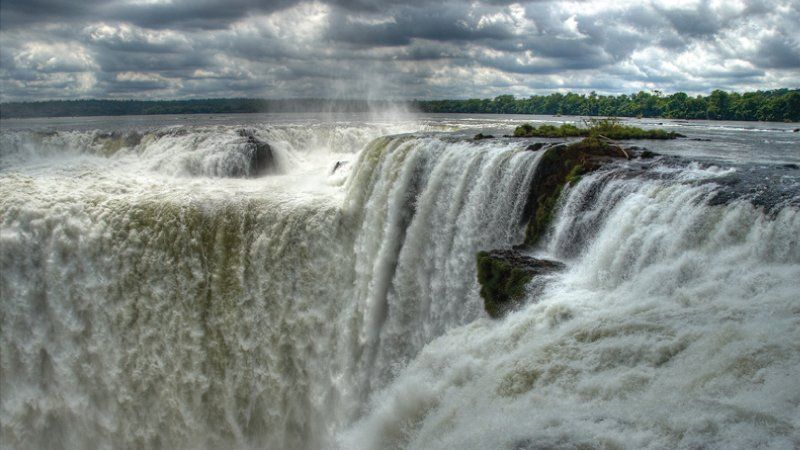
Iguazú - Cataratas
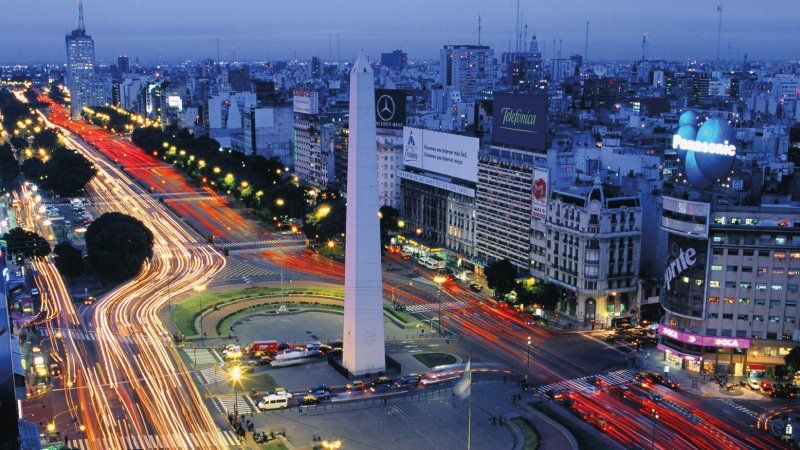
Buenos Aires - Obelisco
-ok.jpg)
Ushuaia - Faro del Fin del Mundo
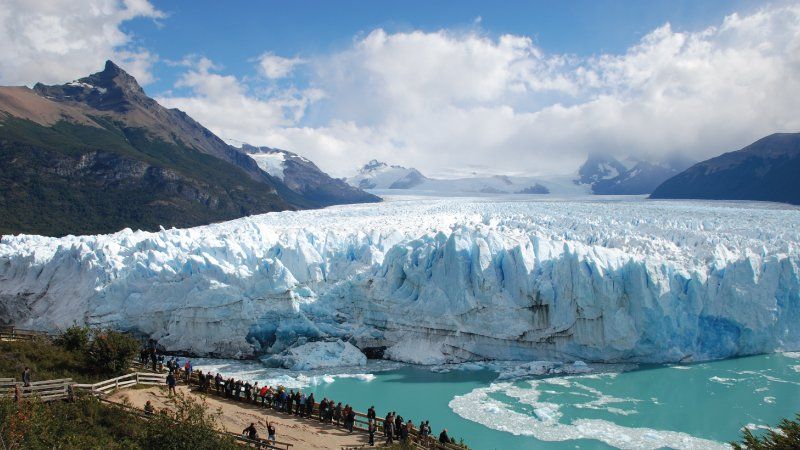
El Calafate - Glaciar Perito Moreno
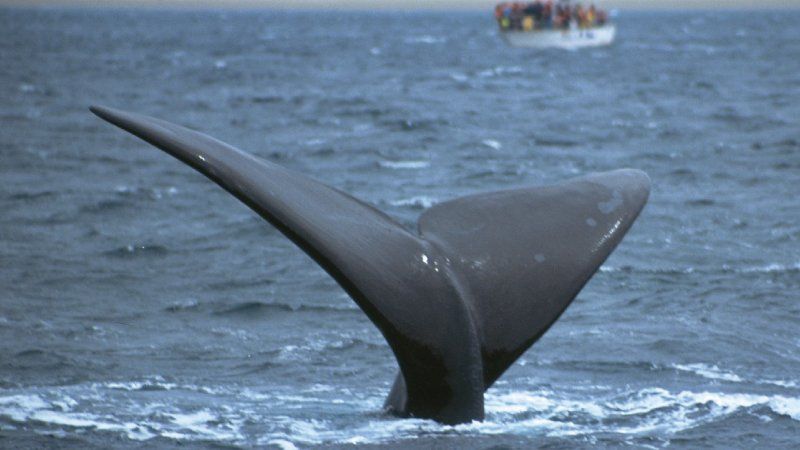
Puerto Madryn - Avistaje de Ballenas
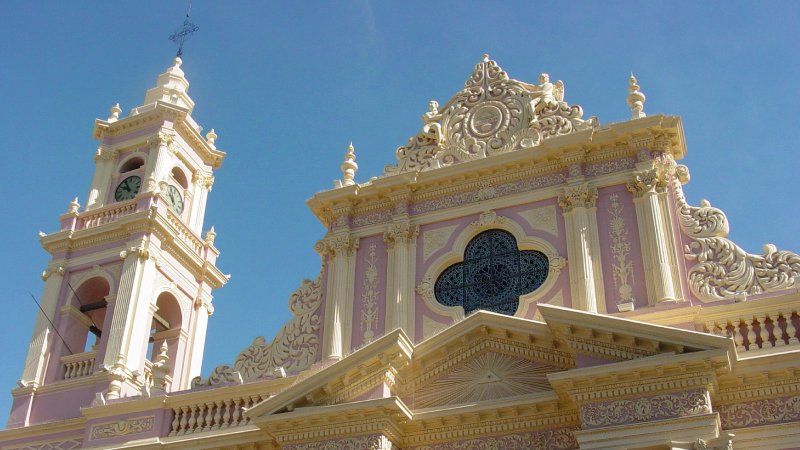
Salta - Catedral
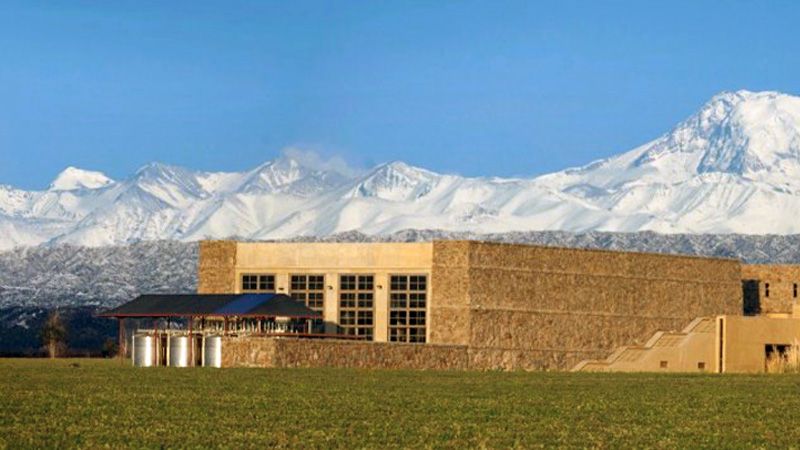
Mendoza- Bodega Séptima
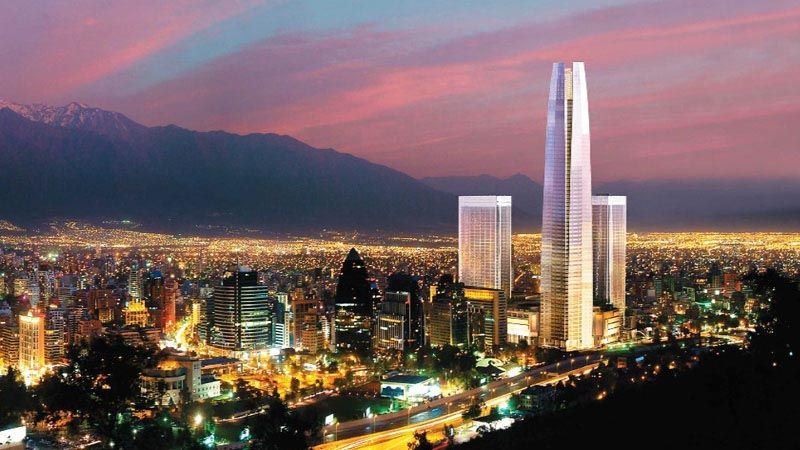
Santiago de Chile - Vista nocturna
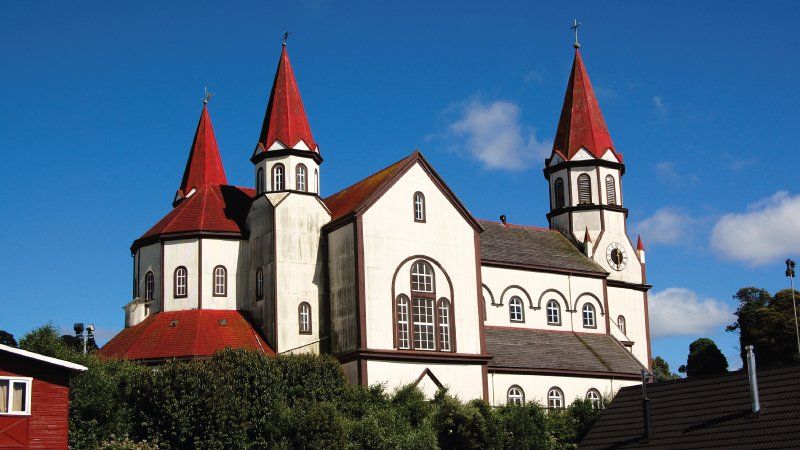
Puerto Varas - Iglesia del Sagrado Corazón de Jesús
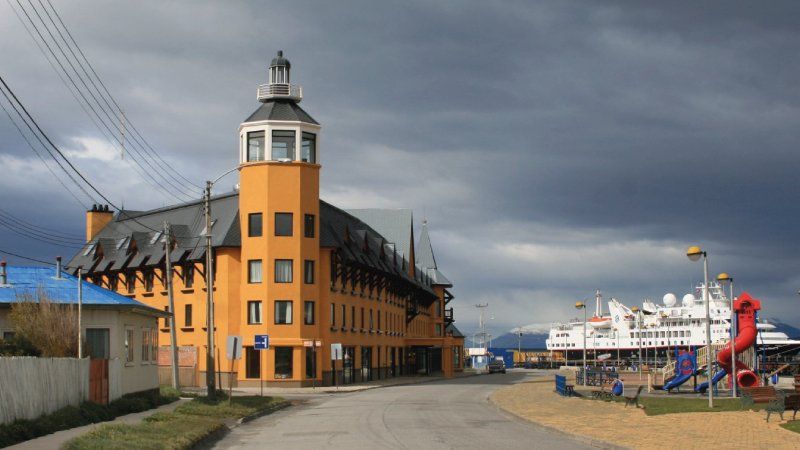
Puerto Natales - Chile
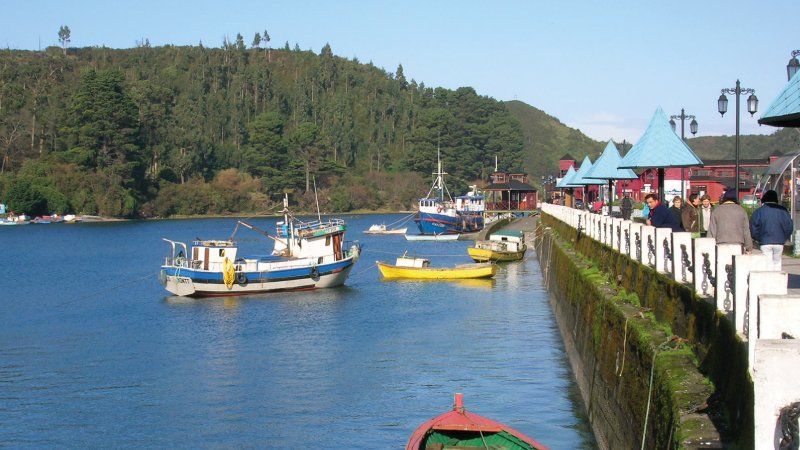
Puerto Montt - Mercado
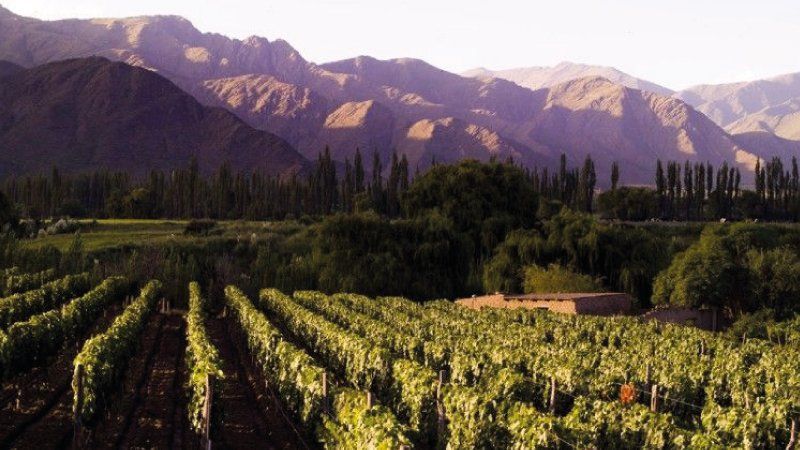
Cafayate - Viñedos
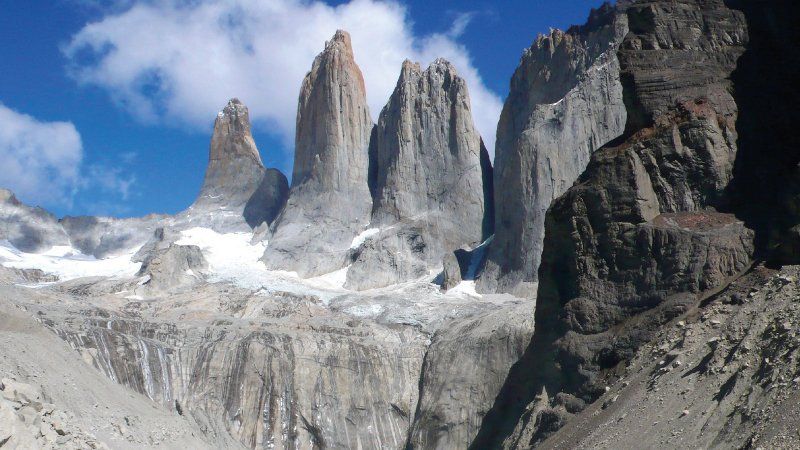
Torres del Paine - Torre Sur, Central, Norte y Peineta
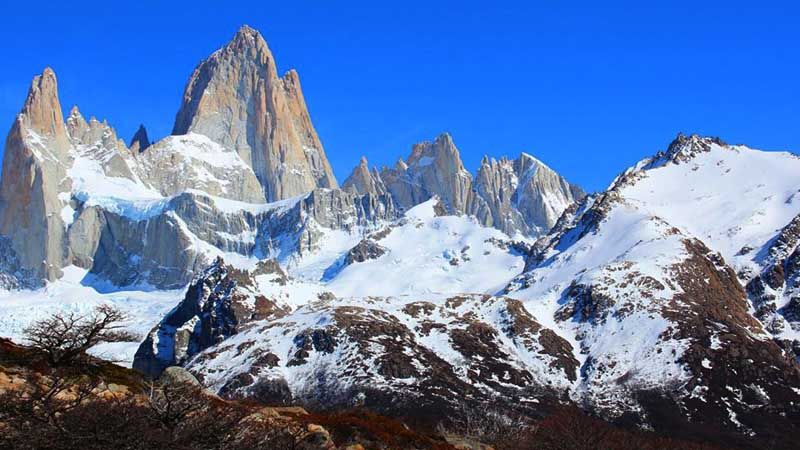
El Chaltén - Cerro Torre y Cerro Fitz Roy
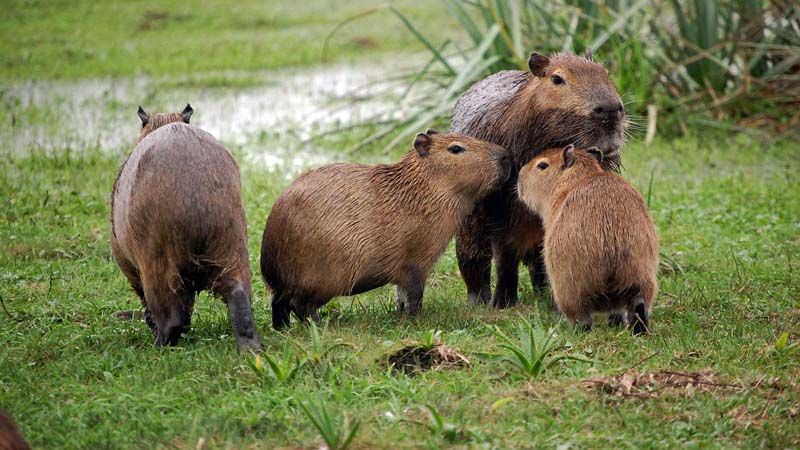
Esteros del Iberá - Carpinchos y sus crías
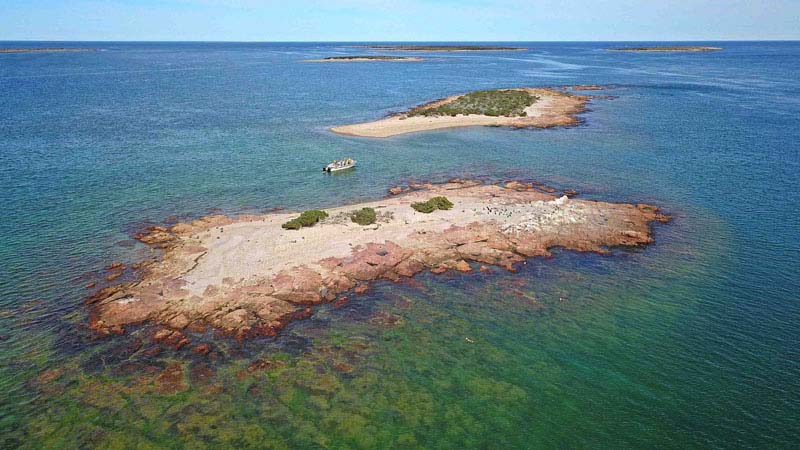
Estilos de viaje
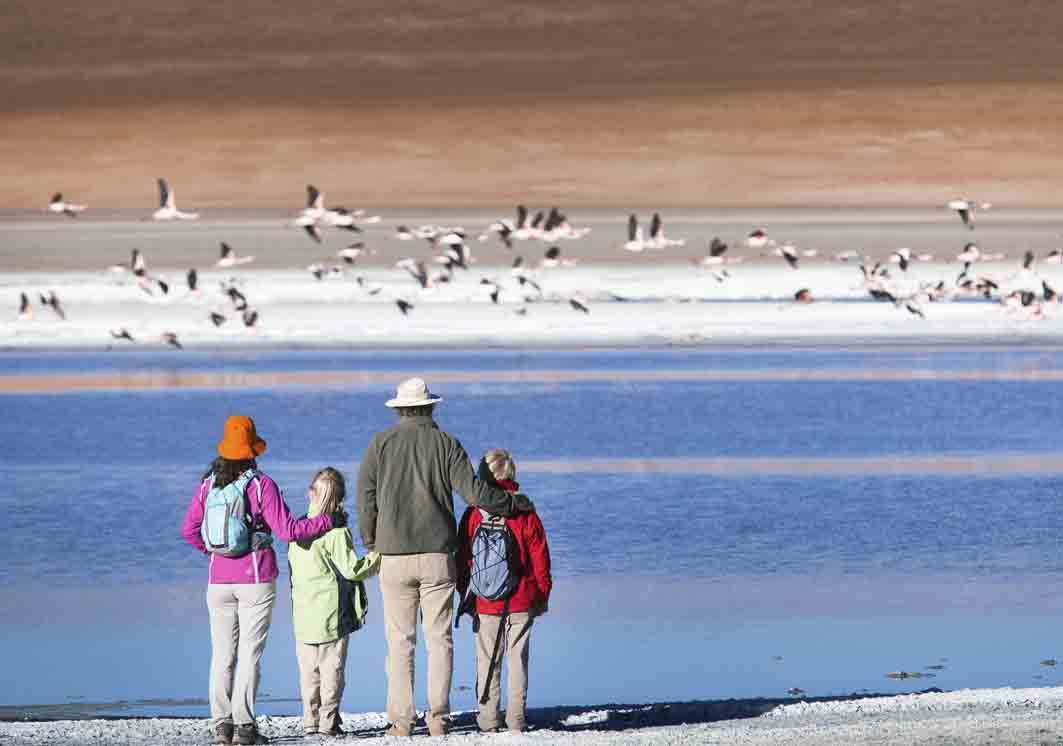
Patagonia Traveler, ¡su agencia de viajes en Argentina!
Patagonia Traveler organiza viajes a Argentina armados a su medida. Si está pensando viajar a Argentina, organizamos tours por Argentina de acuerdo a sus necesidades.
Querer salir de vacaciones con su grupo familiar requiere mucha atención y cuidado. También mucha paciencia si se viaja con niños… Pero por sobre todas las cosas, se necesita contar con el asesoramiento de una buena agencia de viajes y turismo, que pueda ofrecerle itinerarios interesantes y divertidos y donde pueda adquirir el mejor paquete turístico para que conozca Argentina de una manera diferente y agradable para todo el grupo familiar. Esa agencia es Patagonia Traveler! Ya sabe que la República Argentina queda en América del Sur y que, luego de Brasil, es el país sudamericano de mayor extensión. Sabe también que es el país del tango, el país del futbol y que habrá mucho por recorrer para comenzar a conocer un país interesante en todos sus aspectos. Debido a su vasto territorio, habrá que organizarlo todo muy bien, para que todos puedan disfrutar y divertirse, además de aprender a conocer lugares increíbles, que no podrán salir de su memoria. Cuántas opciones para visitar! La capital Buenos Aires, ciudad que alberga los mejores teatros, los mejores restaurantes y cafés, librerías increíbles y paseos agradables. Las Cataratas del Iguazú, con la increíble cantidad de agua que cae incesantemente, produciendo un ruido de fuerza natural impresionante. Mendoza, con su Cordillera de los Andes al fondo y los viñedos y bodegas que producen el mejor Malbec del mundo. O también San Martín de los Andes, Bariloche, Villa La Angostura, para poder pasear por bosques, recorrer lagos, subir laderas para tomar fotos de paisajes espectaculares, comer –y comprar- riquísimos chocolates… Y si se piensa en el sur, en el lugar más austral del planeta, entonces se piensa en Tierra del Fuego, con su capital Ushuaia, donde podrá llevar a sus hijos a un lindo paseo en el Tren del Fin del Mundo! La lista de atracciones es inmensa. Es por eso la necesidad de poder contar con una excelente agencia de viajes y turismo, que le ofrezca el mejor paquete turístico para que conozca Argentina. Adquiera el suyo en Patagonia Traveler!
Recomendados
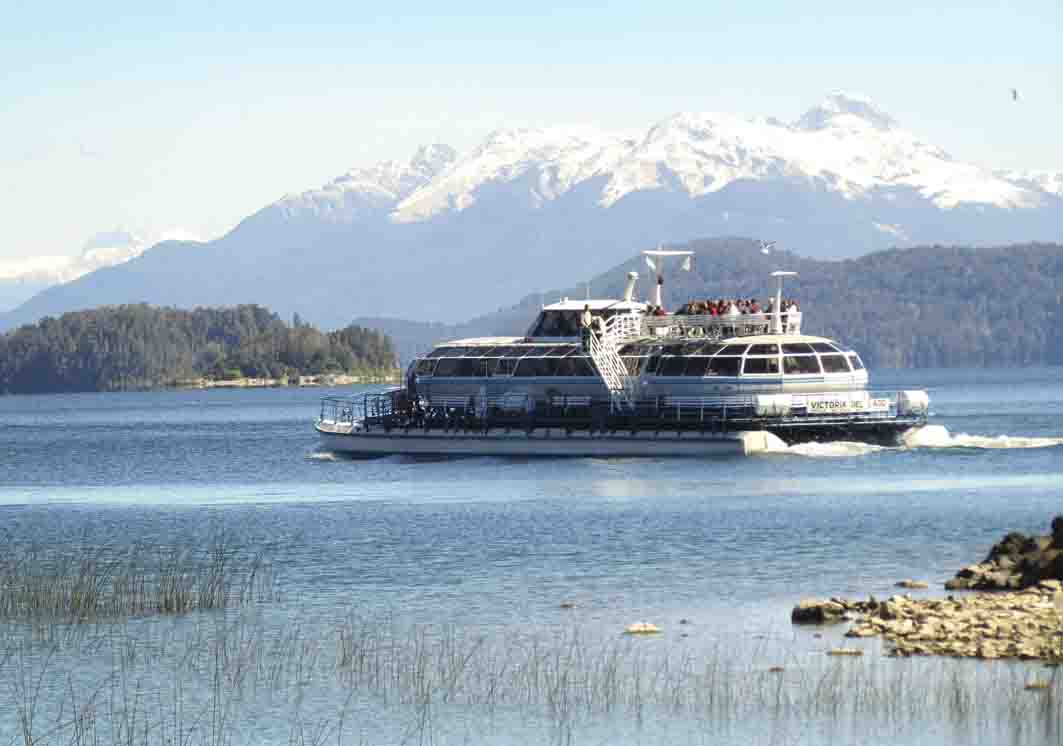
Cruce de los lagos andinos: Bariloche y Puerto Varas
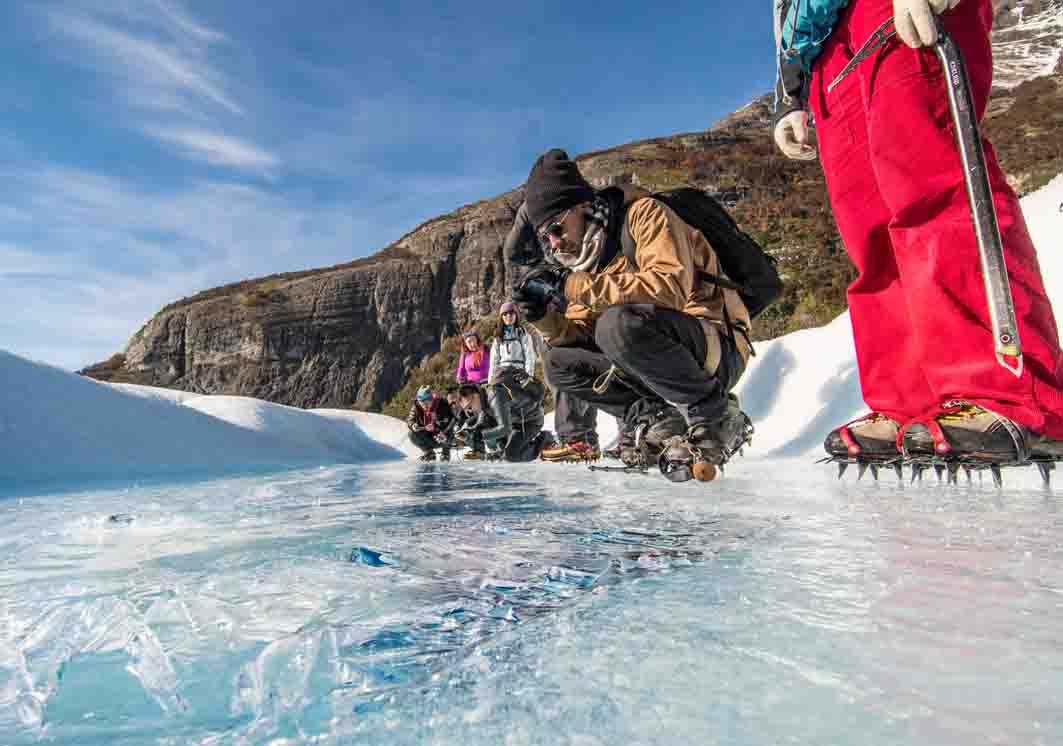
Buenos Aires, Calafate, Bariloche e Iguazú
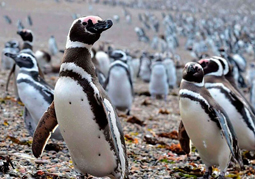
Ballenas, pingüinos y naturaleza a tu ritmo
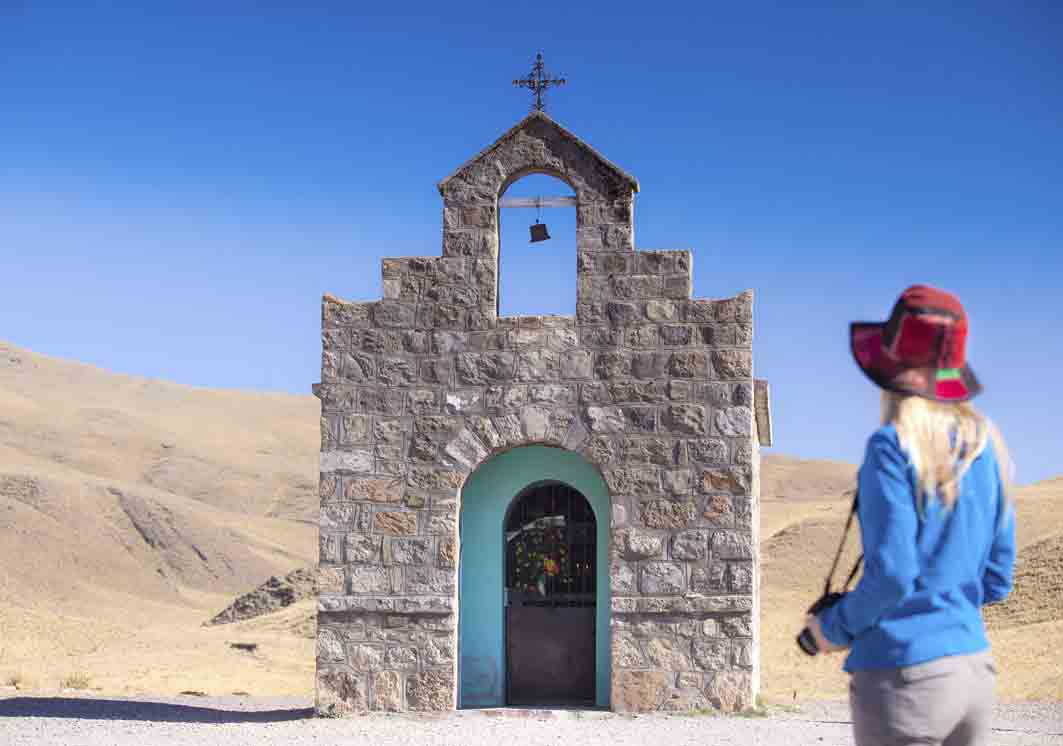
Argentina Ancestral: Salta y Jujuy
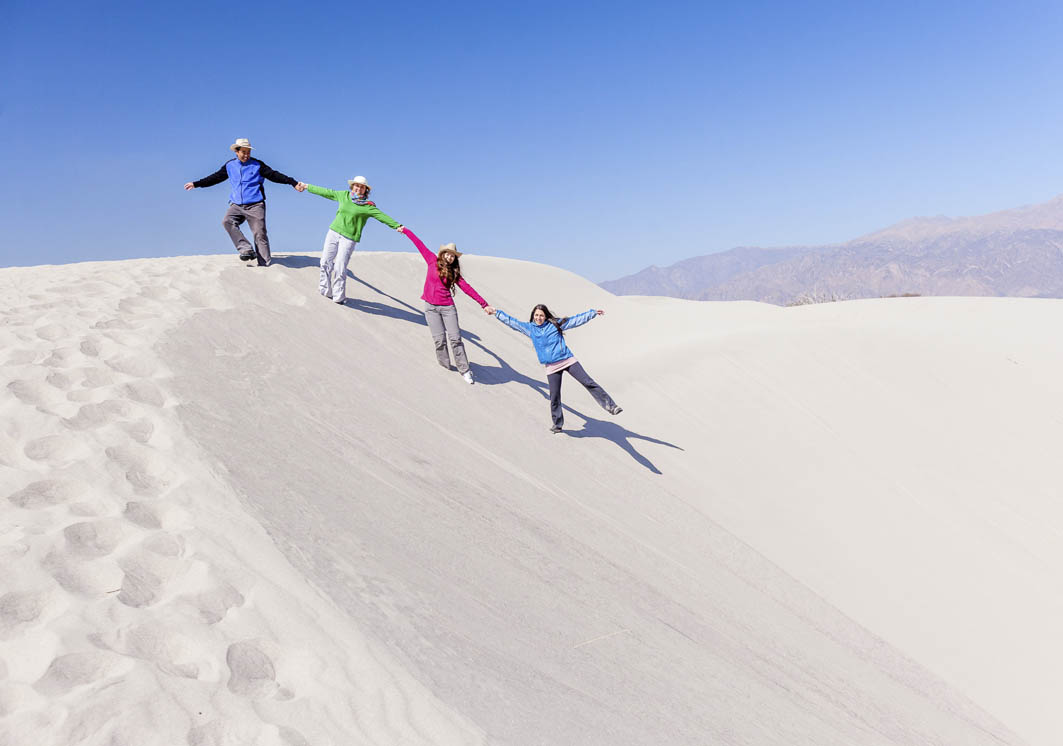
Aventura en familia en Iguazú, Mendoza y Buenos Aires
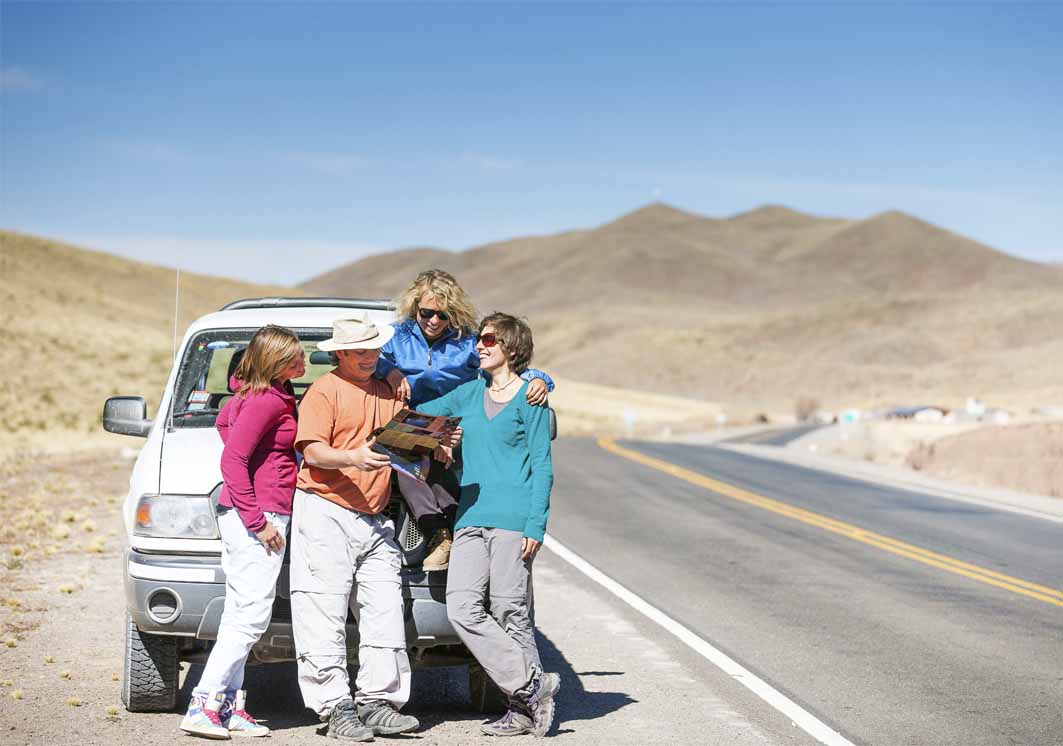
Viaje en auto en la Patagonia en modo self drive
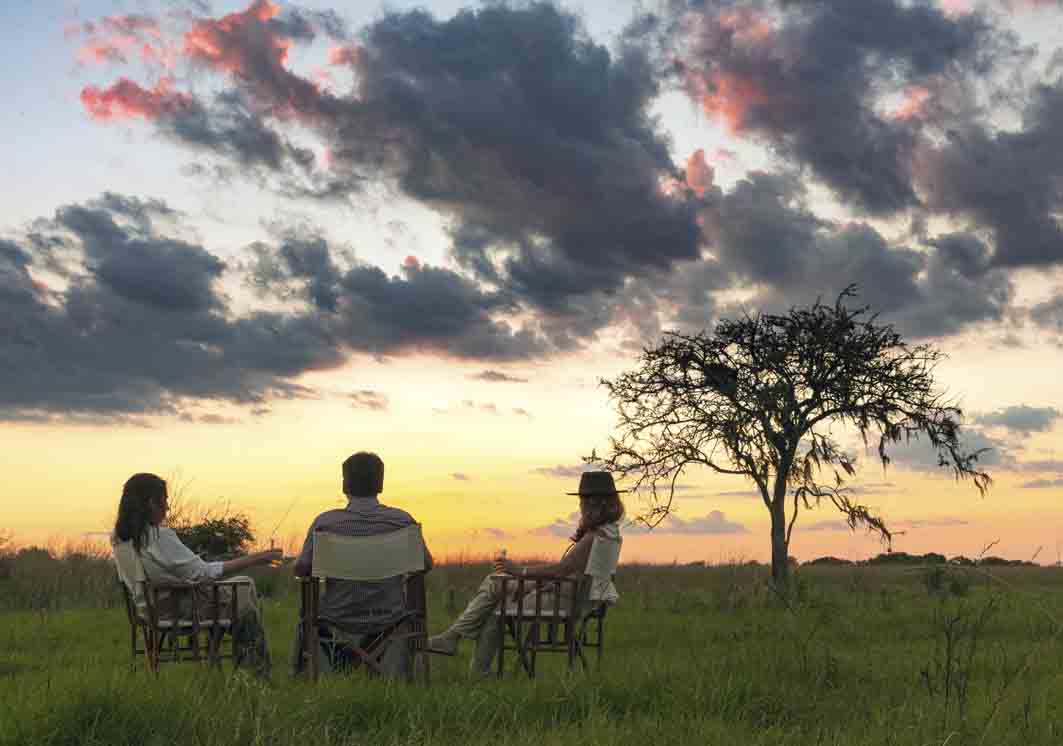
Safari en Esteros del Iberá y Cataratas del Iguazú
¿por qué patagonia traveler.
Patagonia Traveler es una Agencia de Viajes acreditada ante el Ministerio de Turismo de Argentina. También contamos con un seguro destinado a proteger tu inversión.
Somos viajeros al igual que tú. Entendemos de posibles imprevistos. Nuestras políticas son flexibles.
Estamos a tu disposición durante todo el viaje para brindar sugerencias, cuidar los detalles y resolver cualquier imprevisto.
Somos expertos diseñadores de viaje. Personalizamos tus vacaciones en base a tus intereses y preferencias.

- Bahía Bustamante
- Buenos Aires
- Carretera Austral
- Esteros del Iberá
- Puerto Madryn
- Puerto Montt
- Puerto Natales
- Puerto Varas
- Santiago de Chile
- Torres del Paine
- Patagonia Traveler - Tu Agencia de Viajes en Argentina
- Destinos de Argentina y Chile
- Quiénes Somos
- Paquetes Turísticos Recomendados
- Ofertas de Viajes hacia Argentina
- Preguntas Frecuentes
- Arma tu viaje
- Contacto Producto
- Noticias de Patagonia Traveler
- Ofertas para viajar a Argentina
- Estilos de Viaje
- Agentes de Viajes | Patagonia Traveler
- Términos y condiciones

IMAGES
VIDEO
COMMENTS
Top travel destinations while visiting Argentinian Patagonia. Patagonia isn't just one destination. It's hundreds. They're all wedged into this 400,000-square mile (1,036,000-sq km) block of South America, ranging from the spiked Andean peaks to wave-lashed shorelines.
One of only a few working sheep farms open to visitors; accommodation is lavish and the food some of the best in Patagonia. £260 per double, full board, +54 29 6642 8922, montedinero.com.ar ...
A vast and remote region in South America that 402,000 square miles across Argentina and Chile, Patagonia is naturally divided by the Andes, though most of it — about 90% — is Argentinian. ... Long-distance buses that are very comfortable and designed for trips of 24 hours or more are a great way to travel between these small southern ...
Take a Glacier Cruise on Lago Argentina. Taking a glacier cruise on Lago Argentino is sure to be a highlight of any trip to Patagonia. The boat passes oddly-shaped, bright blue icebergs on its way to the first stop, Upsala Glacier. At 10 kilometers wide, Upsala is the largest glacier in all of South America.
My Patagonia highlights. Day 1: Buenos Aires to El Chalten: Hike to Mirador Condores. Day 2: Laguna de Los Tres hike (El Chalten) Day 3: Laguna Torre (El Chalten) Day 4: Perito Moreno Glacier (El Calafate) Day 5 Patagonia itinerary: Puerto Natales. Day 6 - 10: W Trek (Torres Del Paine) Other places to visit in Patagonia.
El Chalten and Perito Moreno Glacier are some of the not-to-miss attractions in Argentinian Patagonia so is Torres del Paine in Chile. The suggested 10-day Patagonia itinerary gives you enough time to explore the area. You can join an organized 9-day tour that starts and finishes in El Calafate.
What To Know Before Traveling To Patagonia Patagonia is huge (and actually two countries). Saying that you are traveling to Patagonia hardly gives a clear indication of where you are actually going. Patagonia is huge and there are many incredible places to visit in Patagonia.First of all, it spans across two countries - Argentina and Chile.
1. Go Hiking in Torres del Paine National Park. Bailey, enjoying the Las Torres Viewpoint at sunrise! Torres del Paine National Park is the most famous national park in Patagonia. Located in Chile near the town of Puerto Natales, the Torres del Paine NP is home to stunning hiking trails and breathtaking viewpoints.
The most important cities and towns from north to south: Western Patagonia [edit]. 1 Neuquén - The largest city in Patagonia and the cultural centre of the Upper Río Negro valley, a modern city with good river beaches, about 260,000 inhabitants.; 2 Villa la Angostura - A lake side town opposite from Bariloche with access to National Park Los Arrayanes and the 12-km trail to the famous ...
Volcan Chaitén Crater Trail, Parque Nacional Pumalín Douglas R. Tompkins (Chile) Best all-encompassing view. 2.7 miles (4.4km) round trip, 3 hours, moderate. In 2008, the eponymous volcano in northern Patagonia staged a surprise eruption and buried half the town of Chaitén under mud and ash. This relatively steep five-hour round-trip trek ...
Here's a map with all of the important stops for one week in Patagonia: Day 1: Fly into El Calafate from Buenos Aires (or do this itinerary in the reverse and fly into Punta Arenas if you're already in Chile). Take 3-hour shuttle directly to El Chalten ( order ahead of time if high season). A ticket should cost you AR $600.
Patagonia is beautiful and the CEO made the trip unforgettable. 10/10 experience! Destinations Buenos Aires, El Chalten, El Calafate, Perito Moreno Glacier, Puerto Natales, Torres del Paine National Park, Punta Arenas, Ushuaia +7 more Age Range up to 90 year olds Physical Rating
Visit this beautiful Argentina escape any time of the year. In the southern part of Argentina, occupying the northern Patagonia region, the low-key mountain town of Bariloche hugs Nahuel Huapi, a ...
Day 1- Hiking to Laguna de Los Tres. Laguna de los Tres. Distance: 13.7 miles. Elevation Gain: 3,503 feet. Difficulty: Difficult. Laguna de los Tres is a difficult trail to climb, but oh so worth it in the end! This is one of the most stunning lakes in Patagonia, and possibly the world, and must be on your Argentina itinerary!
Patagonia 10-Day Itinerary. Overview of the 10-Day Itinerary: Day 1: Flight from Santiago to Punta Arenas. Day 2: Penguin watching at Punta Arenas. Day 3: A boat tour of Lago Grey in Torres del Paine National Park. Day 4: Hiking the Mirador Valle del Frances in Torres del Paine.
This is (understandably) the most popular time to visit Argentine Patagonia. The weather is warm (reaching into the 70s) and the region's attractions are ready for exploration.
A One-Week Patagonia Travel Itinerary. Lucy Pierce 09 May 2022. Discover the depths of Chilean and Argentinian Patagonia, from spotting penguins to scaling mountains and trekking through some of the most incredible surroundings. We've rounded up all the adventures you absolutely shouldn't miss.
Patagonia - travel here to the land that time forgot and set out on the journey of a lifetime where Mother Nature runs the show. When ready, browse vacation ...
El Calafate - Lago Argentino boat trip - USD40. Perito Moreno - Guided trek (65 yrs old is the maximum age permitted) From Price - USD495. Torres del Paine - Half a day visit of Lago Grey - Free. Penguin tour - USD200. Martial Glacier hike - approx USD 15 (payable in ARS, taxi to the start of the trail) - ARS500.
Do []. Motorcycle expeditions in Patagonia, Argentina Compass Expeditions offers adventure Motorcycle Tours specializing in South America, in the the long vast expanses of Patagonia, tours from 10 days to 5 months. (In US 503 369 1955 or in Australia 613 536 86473). Ruta 40.Patagonia is crossed by mythical Ruta 40. The highway takes beginning from the far north to the southernmost tip of ...
Patagonia Traveler es Tu Agencia de Viajes en Argentina, busca y encuentra programas de viajes a Buenos Aires, Iguazú, Bariloche, Patagonia, y muchos destinos más. ... que le ofrezca el mejor paquete turístico para que conozca Argentina. Adquiera el suyo en Patagonia Traveler! Recomendados Estos son nuestros viajes recomendados. 8 días y 7 ...